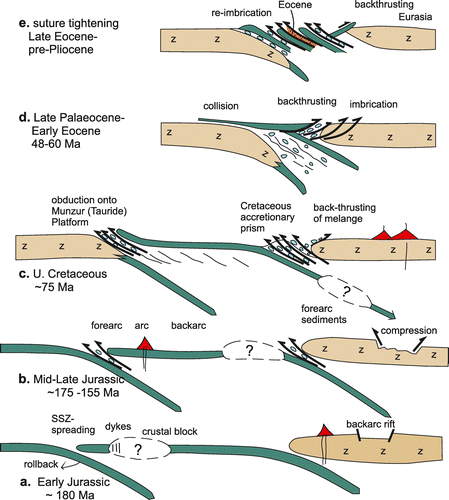Abstract
This paper presents several types of new information including U–Pb radiometric dating of ophiolitic rocks and an intrusive granite, micropalaeontological dating of siliceous and calcareous sedimentary rocks, together with sedimentological, petrographic and structural data. The new information is synthesised with existing results from the study area and adjacent regions (Central Pontides and Lesser Caucasus) to produce a new tectonic model for the Mesozoic–Cenozoic tectonic development of this key Tethyan suture zone.
The Tethyan suture zone in NE Turkey (Ankara–Erzincan–Kars suture zone) exemplifies stages in the subduction, suturing and post-collisional deformation of a Mesozoic ocean basin that existed between the Eurasian (Pontide) and Gondwanan (Tauride) continents. Ophiolitic rocks, both as intact and as dismembered sequences, together with an intrusive granite (tonalite), formed during the Early Jurassic in a supra-subduction zone (SSZ) setting within the İzmir–Ankara–Erzincan ocean. Basalts also occur as blocks and dismembered thrust sheets within Cretaceous accretionary melange. During the Early Jurassic, these basalts erupted in both a SSZ-type setting and in an intra-plate (seamount-type) setting. The volcanic-sedimentary melange accreted in an open-ocean setting in response to Cretaceous northward subduction beneath a backstop made up of Early Jurassic forearc ophiolitic crust. The Early Jurassic SSZ basalts in the melange were later detached from the overriding Early Jurassic ophiolitic crust.
Sedimentary melange (debris-flow deposits) locally includes ophiolitic extrusive rocks of boninitic composition that were metamorphosed under high-pressure low-temperature conditions. Slices of mainly Cretaceous clastic sedimentary rocks within the suture zone are interpreted as a deformed forearc basin that bordered the Eurasian active margin. The basin received a copious supply of sediments derived from Late Cretaceous arc volcanism together with input of ophiolitic detritus from accreted oceanic crust.
Accretionary melange was emplaced southwards onto the leading edge of the Tauride continent (Munzur Massif) during latest Cretaceous time. Accretionary melange was also emplaced northwards over the collapsed southern edge of the Eurasian continental margin (continental backstop) during the latest Cretaceous. Sedimentation persisted into the Early Eocene in more northerly areas of the Eurasian margin.
Collision of the Tauride and Eurasian continents took place progressively during latest Late Palaeocene–Early Eocene. The Jurassic SSZ ophiolites and the Cretaceous accretionary melange finally docked with the Eurasian margin. Coarse clastic sediments were shed from the uplifted Eurasian margin and infilled a narrow peripheral basin. Gravity flows accumulated in thrust-top piggyback basins above accretionary melange and dismembered ophiolites and also in a post-collisional peripheral basin above Eurasian crust. Thickening of the accretionary wedge triggered large-scale out-of-sequence thrusting and re-thrusting of continental margin and ophiolitic units. Collision culminated in detachment and northward thrusting on a regional scale.
Collisional deformation of the suture zone ended prior to the Mid-Eocene (~45 Ma) when the Eurasian margin was transgressed by non-marine and/or shallow-marine sediments. The foreland became volcanically active and subsided strongly during Mid-Eocene, possibly related to post-collisional slab rollback and/or delamination. The present structure and morphology of the suture zone was strongly influenced by several phases of mostly S-directed suture zone tightening (Late Eocene; pre-Pliocene), possible slab break-off and right-lateral strike-slip along the North Anatolian Transform Fault.
In the wider regional context, a double subduction zone model is preferred, in which northward subduction was active during the Jurassic and Cretaceous, both within the Tethyan ocean and bordering the Eurasian continental margin.
1. Introduction
The Mesozoic–Cenozoic geological development of the Eastern Pontide region (Figures and ) is critical to an understanding of the geological development of the southern margin of Eurasia and the adjacent Tethyan ocean. Throughout Late Palaeozoic to Early Cenozoic time Tethyan oceanic crust existed to the south of Eurasia. In many interpretations, the subduction polarity was consistently northwards throughout this time period (Adamia et al., Citation1981; Barrier & Vrielynck, Citation2008; Okay, Satır, & Siebel, Citation2006; Robertson & Dixon, Citationl984; Robertson et al., Citation2005; Ustaömer & Robertson, Citation2010; Ustaömer, Robertson, Ustaömer, Gerdes, & Peytcheva, Citation2013). An alternative is that subduction was southwards during the Late Palaeozoic but switched to northwards during the later Mesozoic–Early Cenozoic (Şengör, Citation1984; Yılmaz, Tüysüz, Yiğitbaş, Genç, & Şengör, Citation1997).
Figure 1. Outline tectonic map of the circum-Black Sea region of NE Turkey. This paper focuses on the eastward extension of the İzmir–Ankara–Erzincan suture zone through the Eastern Pontides, and comparisons especially with the Central Pontides and the Lesser Caucasus. Modified from Ustaömer and Robertson (Citation2010). PCF, Peceneaga Camena Fault; CTF, Caucasian Thrust Front; S, Svenata uplift; RD, Rioni Depression; DZ, Dzirula salient; KH, Khrami salient; LS, Lochi salient; CUZ, Chorchana–Utslevi Zone.
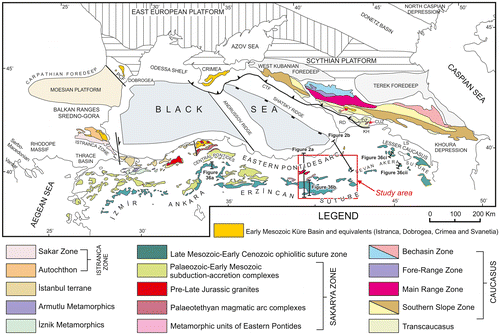
Figure 2. Simplified N–S cross-sections of the İzmir–Ankara–Erzincan suture zone in the Eastern Pontides. (a) West of the area; (b) East of the area (see Figure ). Based on the 1:500,000 Geological Map of Turkey (MTA, Citation2002), with modifications resulting from this work. NAF North Anatolian Transform Fault.
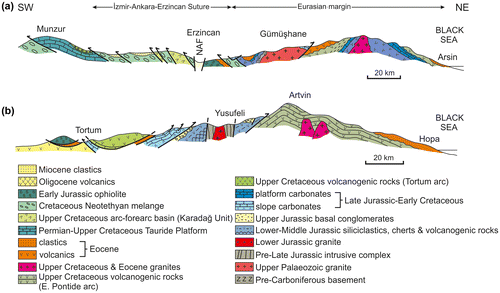
Ophiolites and melanges form an important component of the Tethyan suture zone in the Eastern Pontides (e.g. Bergougnan, Citation1975; Şengör & Yılmaz, Citation1981; Yılmaz et al., Citationl997). The ophiolites in this region were traditionally assumed to be Late Cretaceous in age (Okay & Şahintürk, Citationl997a; Parlak, Çolakoğlu, et al., Citation2013; Rice, Robertson, & Ustaömer, Citation2006). However, Jurassic ophiolite-related rocks have recently been reported from within the same suture zone further west (Çelik et al., Citation2011; Dilek & Thy, Citation2006) and also from the continuation of the suture zone into the Lesser Caucasus to the east (Galoyan et al., Citation2009; Hässig et al., Citation2013; Rolland, Galoyan, Sosson, Melkonyan, & Avagyan, Citation2010; Sosson et al., Citation2010). The timing of emplacement of the ophiolitic rocks onto the Pontide continental margin and the final closure of the Tethyan ocean in this region have been regarded as ranging from Late Cretaceous to Eocene in different interpretations (e.g. Floyd, Göncüoğlu, Winchester, & Yalınız, Citation2000; Göncüoğlu, Turhan, Şentürk, Özcan, & Uysal, Citation2000; Okay & Şahintürk, Citationl997a; Rice et al., Citation2006, Rice, Robertson, Ustaömer, İnan, & Taslı, Citation2009; Şengör & Yılmaz, Citation1981). In addition, Middle Eocene and younger sedimentary and volcanic cover units help to document post-collisional suture tightening and the role of extension related to opening of the Black Sea. Such post-collisional structural features need to be recognised and backstripped to reveal structures related to the earlier ophiolite emplacement and continental collision.
Here, we focus on an approximately 250-km-long segment of the İzmir–Ankara–Erzincan suture zone and its eastward extension, termed the Erzurum-Kars suture zone (Konak et al., Citation2001). The study area (Figure ) encompasses the regional cities of Erzincan and Erzurum, from west to east. The suture zone resulted from the closure of a Tethyan ocean, generally known as the İzmir–Ankara–Erzincan ocean (Okay & Tüysüz, Citationl999), or the Northern Neotethys (Şengör & Yılmaz, Citation1981). This ocean separated the Eurasian and Tauride continents, at least during Late Palaeozoic–Early Cenozoic time.
Figure 3. Outline tectonic map of the İzmir–Ankara–Erzincan suture zone and its eastward extension (Erzurum–Kars suture zone), cover units, together with the Eurasian continental margin and the Tauride continental margin to the south. Areas studied here are shown by the boxes and lines of section. Simplified from the 1:500,000 Geological Map of Turkey (MTA, Citation2002).
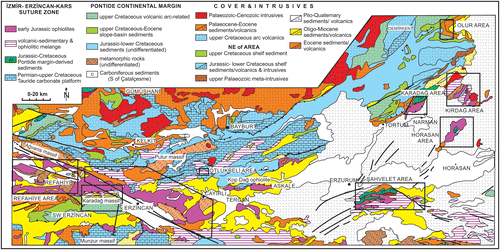
A good understanding of the region requires the study, interpretation and integration of geological information from a number of different study areas across a wide region. No one area demonstrates all of the important evidence. During this study, we paid particular attention to the contact relations of key units.
A multidisciplinary approach is essential to provide an integrated overview. In this paper, much of the detailed supporting data are given in the diagrams and tables, while the geological interpretation is explained in the text.
From west to east, our detailed study areas are as follows: the Refahiye area (Erzincan Region), the Erzincan area (Erzincan and Gümüşhane regions), the Otlukbeli area (Erzincan Region), the Kop Dağ area (Gümüşhane and Erzincan regions), the Şahvelet area (Erzurum Region), the Karadağ area (Erzurum Region), the Kırdağ area (Erzurum Region) and the Horasan area (Erzurum and Kars regions). Several specific ophiolites are recognised within these areas, namely the Refahiye Ophiolite (in both the Refahiye and Erzincan areas), the Kop Dağ Ophiolite, the Şahvelet Ophiolite (Şahvelet area), the Karadağ Ophiolite (Karadağ area) and the Kırdağ Ophiolite (Kırdağ area) (see Figure ). Most of the units of the suture zone studied lie to the north of the North Anatolian Transform Fault. However, the Refahiye area lies partially to the south of the fault zone, implying that this part was up to ~85 km further east prior to Plio-Quaternary right-lateral strike-slip offset (e.g. Şengör et al., Citation2005). As a result, part of the Refahiye area needs to be restored to a location to the east of Erzincan before Plio–Quaternary time.
Key issues that we will consider here include: (1) the age of the ophiolites, both relatively intact and dismembered units, based on new U–Pb dating of zircons, (2) the age of exotic blocks within volcanic-sedimentary melange, using Radiolaria extracted from associated ribbon cherts, (3) the age and provenance of dismembered Mesozoic sedimentary sequences within the suture zone based on petrographic study and dating of calcareous microfossils, (4) the timing and processes of emplacement of accretionary melange over the Eurasian continental margin (equivalent to the E Pontide margin), based on calcareous microfossil dating and sedimentological study, (5) the timing and processes of collision based mainly on micropalaeontological, sedimentary and structural information and (6) post-collisional processes affecting the suture zone especially extension and suture tightening, mainly using micropalaeontological, sedimentary and structural evidence. We go on to outline several alternative tectonic models that are potentially applicable to the NE Pontides, each with several pros and cons. To help to choose between these, we draw on comparisons between the Central Pontides and the Lesser Caucasus and then conclude with a new tectonic model of Tethyan ocean basin closure along this segment of the southern margin of Eurasia.
In this paper, we use the time scale of Gradstein, Ogg, and Smith (Citation2004).
The sample locations are given as geographical coordinates (degree, minute, second) converted from the WGS84 projection.
2. Tectono-stratigraphy
We first outline the composite tectono-stratigraphy. On a regional scale, this is as follows from the structural base to the structural top of the suture zone (Figure ). However, it must be emphasised that the exposures differ greatly between the nine areas studied. All of these units are allochthonous relative to the Eurasian continent to the north.
Figure 4. Summary tectono-stratigraphy based on this work. A Cretaceous subduction-accretion complex is overthrust by Lower Jurassic ophiolites. These are intercalated with Jurassic–Cretaceous sedimentary rocks derived from the Eurasian continental margin. The ophiolite is overthrust by contrasting sedimentary and volcanogenic successions in the east vs. the west of the region. Several units of metamorphic rocks (locally dated as Jurassic) are excluded because they occur in different structural positions in different areas.
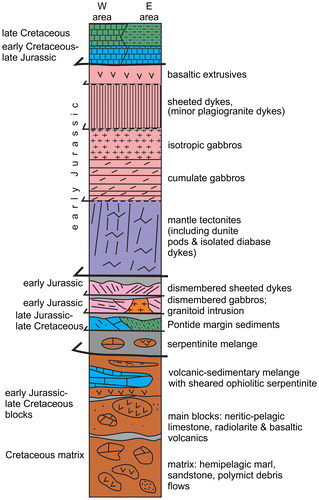
Volcanic-sedimentary and ophiolitic melange forms part of the belt of North Anatolian ophiolitic melange (e.g. Ankara melange) (e.g. Rojay, Citation2013; Rojay, Yalınız, & Altıner, Citation2001; Rojay et al., Citation2004). The melange includes two main components that can be mapped separately at a local scale. The first is volcanic-sedimentary melange that is mainly composed of blocks of basaltic extrusives, radiolarian chert and pelagic, or neritic, limestone; these blocks are set in a clastic to hemipelagic sedimentary matrix.
The second type of melange comprises ophiolitic rocks that range from laterally persistent (i.e. kilometres) lenses of sheared serpentinite to detached blocks (e.g. gabbro; sheeted dykes). The ophiolitic melange ranges from mappable thrust sheets of dismembered ophiolitic rocks, including serpentinised harzburgite, layered gabbro, sheeted dykes and extrusive rocks, to blocks and dismembered thrust sheets of ophiolitic rocks within volcanic-sedimentary melange. Locally, for example, beneath some large ophiolite slices, sheared serpentinite (mostly serpentinised harzburgite) may contain blocks of marble, recrystallised chert and other altered sedimentary rocks. In one known area (Kırdağ massif; see below), a dismembered ophiolitic thrust sheet is intruded by a granitic pluton (tonalite), for which new radiometric age data are presented here. On a regional scale, the two types of melange are not easily distinguishable and here are commonly shown simply as volcanic-sedimentary and ophiolitic melange.
In addition, there are large (kilometre-sized) thrust sheets that encompass a partial ophiolitic pseudostratigraphy, including one or more of mantle tectonites, ultramafic cumulates, layered and isotropic gabbros, sheeted dykes and extrusive rocks (Parlak, Çolakoğlu, et al., Citation2013). However, the ophiolite pseudostratigraphy is commonly sheared and faulted, and there are no known occurrences of a metamorphic sole or an intact deep-sea sedimentary cover.
The suture zone includes dismembered slices of mainly Jurassic–Late Cretaceous sedimentary and volcanic rocks. These sedimentary rocks are here shown to be emplaced fragments of the southerly (distal) Pontide continental margin and, as such, of different origin from the oceanic rocks within the volcanic-sedimentary melange. These Eurasian-related lithologies are important for an understanding of the timing and processes of the tectonic assembly of the suture zone.
The suture zone is bordered to the north by sequences of Jurassic to Lower Eocene sedimentary and/or volcanic rocks that form part of the Eurasian continental margin to the north. These units are relatively autochthonous relative to the ophiolitic rocks and the volcanic-sedimentary and ophiolitic melange. However, they form part of the pile of thrust sheets that was emplaced northwards onto the Eurasian margin during the Early Eocene. These lithologies shed light on the geological development of the Eurasian continental margin.
In the west of the area, there is a large, structurally bounded, outcrop of Upper Cretaceous–Eocene volcanogenic and sedimentary rocks (Figure ; see MTA, Citation2002; Rice et al., Citation2009). This is here termed the Karadağ massif (Erzincan) to distinguish it from the ophiolitic Karadağ massif in the east. This important unit in the Erzincan area is correlated here with the Eurasian continental margin in the northeast of the area studied (e.g. Olur area; see Figure ), with important implications for the timing and amount of thrust displacement.
Several occurrences of metamorphic rocks do not fit neatly into the above regional tectono-stratigraphy (and are thus excluded from Figure ). Metavolcanic and metasedimentary units, including melange, are located at varying structural levels of the suture zone in different areas (i.e. above, within and below ophiolitic rocks). In general, these metamorphic units are poorly dated and may be of different ages and origins.
In the west of the area, the suture zone lithologies are thrust southwards over the northerly edge of the Tauride continent, represented by the Late Permian–Mesozoic Munzur Massif (Figure ). South of the Munzur carbonate platform (e.g. in the Divriği-Hekimhan area), occurrences of accretionary melange and dismembered ophiolitic rocks are correlated with the separate Inner Tauride suture zone (Parlak, Karaoğlan, et al., Citation2013; Parlak, Yılmaz, & Boztuğ, Citation2006; Robertson, Parlak, Metin, et al., Citation2013; Robertson, Parlak, & Ustaömer, Citation2013). The eastern part of the suture zone in the region studied is covered by Neogene sediments and volcanics (Figure ). The underlying rocks are inferred to be part of a regional-scale subduction-accretion complex (East Anatolian accretionary complex of Şengör et al., Citation2008; Şengör & Yılmaz, Citation1981). As a result, no southern continental margin can be recognised in the east of the area studied. This has implications for thrusting and ophiolite emplacement on a regional scale.
Below, we will present the main evidence for each of the above tectono-stratigraphical units, working systematically from the west to the east for each one. Our interpretation is given afterwards utilising several time slices.
3. Volcanic-sedimentary melange
The volcanic-sedimentary melange is the most extensively exposed unit of the suture zone, as seen, for example, in the Şahvelet area Figure ), the Horasan area (Figure ) and the Erzincan area (Figure ). Smaller, but significant, outcrops of melange were also observed in the Refahiye, Kop Dağ, Kırdağ and Karadağ areas (Figure ). In many areas, small ophiolitic slices cannot be distinguished on the scale of the maps shown and in these cases, the more general term volcanic-sedimentary and ophiolitic melange is used. In most areas, the lower contact of the melange is covered or tectonic, while the upper contact is commonly a thrust, with ophiolitic rocks above (e.g. Refahiye, Erzincan and Kırdağ areas). The melange in the Otlukbeli area (SW of Bayburt, Erzincan Region; Figure ) is notable as it is located structurally above the Cretaceous Pontide carbonate platform. Locally in the Bayburt Region, Maastrichtian shallow-water limestones (Kapıkaya Limestone) unconformably overlie the volcanic-sedimentary melange (see Okay & Şahintürk, Citationl997a).
Figure 5. Outline tectonic map of the Şahvelet area, Erzurum Region. An upper, folded thrust sheet of ophiolitic rocks, mostly serpentinised peridotite, is structurally underlain by the volcanic-sedimentary and ophiolitic melange. In different areas, the melange and/or the ophiolite are overthrust by Upper Cretaceous deep-water pelagic and volcaniclastic sediments derived from the Eurasian continental margin (see Figure for location; compiled from Parlak, Çolakoğlu, et al., Citation2013; Tarhan, Citationl988; Yılmaz, Terlemez, & Uysal, Citation1986, Citation1988a, Citation1988c, Citationl989; Yilmaz et al., Citation1988b; Yilmaz & Uysal, Citation1988 and this study).
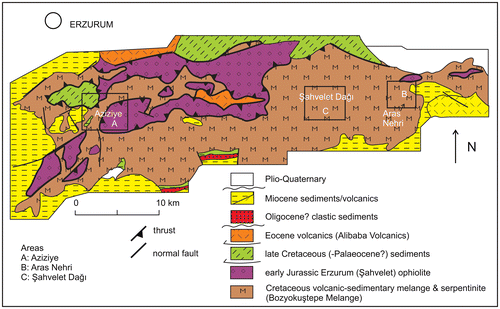
Figure 6. Outline tectonic map of the area north of Horasan, Kars Region. Two contrasting types of melange are exposed. First, volcanic-sedimentary melange, with exotic blocks (e.g. limestone; volcanics), set in a sedimentary matrix and, secondly, ophiolitic melange made up of dismembered ophiolitic rocks. There are also dismembered sequences of Upper Cretaceous mixed carbonate-volcaniclastic sediments that are interpreted as part of the emplaced Eurasian continental margin (see Figure for location; compiled from Konak and Sümengen (Citation2009) and this study).
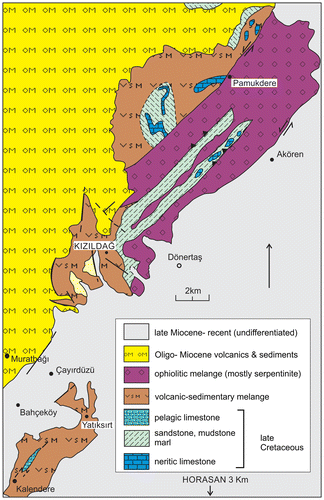
Figure 7. Outline tectonic map of the Erzincan area (Erzincan and Gümüşhane regions). An ophiolite, complete other than for extrusive rocks, is thrust over volcanic-sedimentary and ophiolitic melange. Both units are unconformably covered by Eocene sediments and, in some areas, by Miocene and Plio–Quaternary sediments. Outcrops of greenschist facies metamelange occur in the south and northeast. The southern part of the area is cut by the North Anatolian Transform Fault, which is this area is associated with formation of the neotectonic Erzincan pull-apart basin (see Figure for location; compiled from Aktimur et al., Citation1995; Parlak, Çolakoğlu, et al., Citation2013; Tarhan, Citationl988, Citation2007a, Citation2007b and this study).
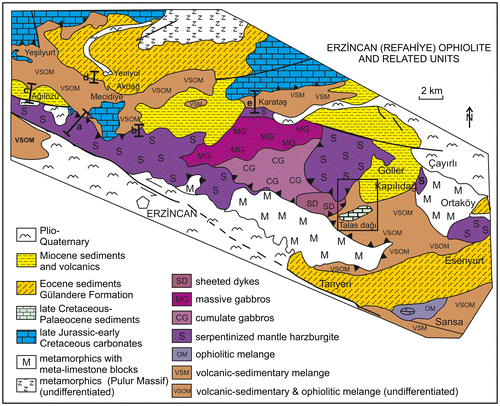
3.1. Exotic blocks
The volcanic-sedimentary melange contains exotic blocks and dismembered thrust sheets set in a sedimentary matrix. The main lithologies are basalt, redeposited limestone, neritic limestone (commonly recrystallised) and pelagic sedimentary rocks, especially ribbon chert and pelagic limestone. Blocks of Early Cretaceous Calpionellid limestone and Late Cretaceous pelagic limestone were previously reported from the melange in the Erzincan area (Rice et al., Citation2006, Citation2009). Here, we focus on sections for which we have new igneous geochemical, sedimentological and radiolarian age dating evidence.
In some areas, the volcanic-sedimentary melange is characterised by dismembered thrust sheets (up to kilometres long × up to several hundred metres thick) and very large blocks (up to 100s of metres across) of basaltic extrusive rocks, together with deep-sea sedimentary rocks. These lithologies are important to reconstruct the oceanic crust that preceded the melange. Some representative examples of basalt and associated pelagic sedimentary sequences are shown in Figure ((a)–(c)). The basaltic sequences encompass pillow basalt, massive basalt, lava breccia and minor volcaniclastic sandstone/siltstone. The lava breccias are generally of primary eruptive type (e.g. pillow disintegration breccia), but reworked (epiclastic) material is also locally present. In places, the basalts are interbedded with and/or stratigraphically overlain by ribbon radiolarite, shale or volcaniclastic sandstone. The uppermost basaltic rocks in a given sequence are commonly altered, haematised or silicified. Epidote-rich veins are commonly present, together with patchy celadonite. The settings of the radiolarites, specifically are shown in Figure , while the Radiolaria that were identified in these cherts are illustrated in Figures (A) and (B) (see below).
Figure 8. Cross-sections and measured logs of local sequences within blocks and dismembered thrust sheets that form part of the volcanic-sedimentary and ophiolitic melange, (a) volcanogenic lithologies, depositionally overlain by radiolarian sediments, passing upwards into volcanogenic shale; (b) volcanogenic lithologies depositionally overlain by redeposited limestones and then by radiolarian and hydrothermal sediments, passing upwards into shale; (a–b) East side of Aras Nehri (river) near road bridge; Şahvelet area; (c) volcanogenic lithologies depositionally overlain by chert, passing upwards into limestone; NE of Aziziye, Şahvelet area, Erzurum Region). Samples that were dated using radiolarians (numbers with arrows) are also shown in Figure (a) and (b), together with data from other areas. See text for discussion.
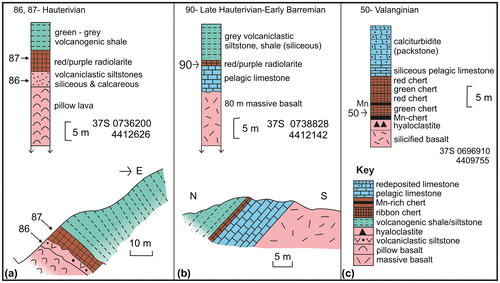
Figure 9. Occurrences of dated radiolarites associated with blocks and dismembered thrust sheets within the volcanic-sedimentary and ophiolitic melange. (a) Upper Tithonian radiolarites spatially associated with basaltic pillow lava (although separated by a thin thrust sheet of sheared serpentinite), E of Erzincan; (b) Pliensbachian radiolarites stratigraphically interbedded with pillow lavas, E of Erzincan; (c) Lower Turonian radiolarites overlying pillow basalt, near Otlukbeli, SW of Bayburt; (d) Valanginian? radiolarites overlying pillow basalt, near Aziziye, Erzurum Region; (e) Late Hauterivian–Early Barremian radiolarites overlying pelagic limestones that, in turn, cover massive basalt, Şahvelet area; (f) Pliensbachian radiolarites stratigraphically interbedded with massive basalt; Şahvelet area. Bedding is recorded as angles of dip and strike. See text for explanation.
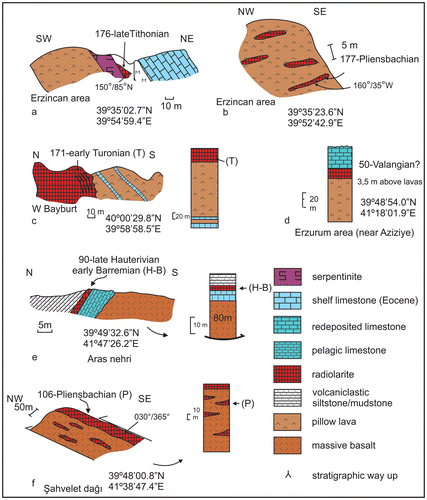
Figure 10(A). SEM images of age-diagnostic Radiolarian from blocks associated with basaltic rocks in the volcanic-sedimentary and ophiolitic melange. Sample E2-11-50 (near Azize; Şahvelet area). 1 – Acanthocircus sp. ×100; 2 – Dicerosaturnalis amissus (Squinabol), 3 – Acaeniotyle cf. diaphorogona Foreman, 4 – Acaeniotyle cf. diaphorogona Foreman, ×100; 5 – Angulobracchia cf. biordinalis Ozvoldova, ×150; 6 – Angulobracchia cf. portmanni Baumgartner, ×75; 7 Aurisaturnalis variabilis (Squinabol), 250; 8 – Praeconosphaera sphaeroconus (Rüst), ×150; 9, 10 – Archaeodictyomitra cf. praegutta Dumitrica, ×100; 11 – Pseudodictyomitra cf. carpatica (Lozyniak), ×150; 12 – Sethocapsa? sp., ×200; 13 – Spongacapsula obesa Jud, ×200; 14 – Thanarla pulchra (Squinabol), ×200; 15 – Archaeodictyomitra sp., ×125; 16 – Nassellaria gen. et sp. indet., ×125. Sample E2-11-86 (Aras Nehri gorge; Şahvelet area) 17 – Alievium regulare (Wu & Li), ×125; 18 – Sethocapsa trachyostraca Foreman, ×125; 19 Sethocapsa uterculus Parona, ×250; 20 – Syringocapsa limatum Foreman, ×100; 21 – Svinitzium pseudopuga Dumitrica, ×150; 22 – Suna echiodes (Foreman), ×150; 23 – Pseudoxitus laguncula Dumitrica, ×150; 24 – Pseudodictyomitra nodocostata Dumitrica, ×150; 25 – Pseudoaulophacus (?) florealis Jud, ×125; 26 – Syringocapsa spinosa (Squinabol), ×150; 27 – Parvicingula usotanensis Tumanda, ×150; 28 – Tethysetta boessi gr. (Parona), ×125; 29 – Pantanellium sp., ×100; 30 – Mirifusus dianae (Karrer), ×85; 31 – Mictyoditra curvata Dumitrica, ×150; 32 – Holocryptocapsa hindei (Tan), ×130; 33 – Hemicryptocapsa capita Tan, ×150; 34 – Dicerosaturnalis trizonalis (Rüst), ×100; 35 – Crucella bossoensis Jud, ×125; 36 – Cecrops septemporatus (Parona), ×150; 37 – Pseudoeucyrtis sp., ×150.
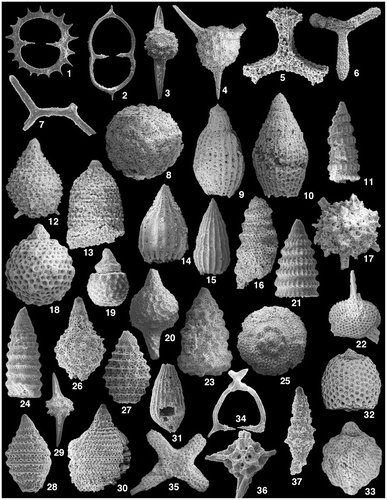
Figure 10(B). SEM images of age-diagnostic Radiolarian from blocks associated with basaltic rocks in the volcanic-sedimentary and ophiolitic melange. Sample E2-11-87 (Aras Nehri gorge; Şahvelet area): 1 – Archaeodictyomitra apiarium (Rüst), ×150; Pantanellium squinaboli (Tan), ×200; 3 – Pantanellium sp., ×200; 4 – Sethocapsa trachyostraca Foreman, ×100; 5 – Svinitzium pseudopuga Dumitrica, ×125; 6 – Xitus sp., ×125. Sample E2-11-90 (Aras Nehri gorge; Şahvelet area): 7 – Alievium regulare (Wu & Li), ×125; 8 – Archaeotritrabs gracilis Steiger, ×100; 9 – Becus helenae (Schaaf), ×125; 10 – Napora sp., ×200; 11 – Orbiculiforma satoi Tumanda, ×100; 12–14 – Pantanellium masirahense gr. Dumitrica, ×125; 15 – Tethysetta usotanensis (Tumanda), ×150; 16 – Phaseliforma cf. micropora (Tan), ×100; 17 – Praexitus alievi (Foreman), ×100; 18 – Tetracapsa sp., ×200; 19 – Thanarla conica (Aliev), ×200; 20 – Veghicyclia ? sp.; 21 – Xitus robustus Wu, ×150. Sample E2-11-94 (Aras Nehri gorge; Şahvelet area): 22 – Thanarla cf. gutta Jud, ×100; 23 – Archaeodictyomitra sp., ×125; Sample E2-11-106 (Şahvelet Dağ) (24 – Gigi fustis De Wever, ×150; 25–26 – Lantus intermedius gr. Carter, ×150. Sample E2-11-177: 27 – Canoptum cf. anulatum Pessagno & Poison, ×125; 28 – Canoptum cf. artus Yeh, ×100; 29 – Droltus sp., ×200. Sample E2-11-176 (E of Erzincan): 30 – Pantanellium aff. riedeli Pessagno, ×125; 31 – Saitoum cf. labeosum Dumitrica & Zügel, ×150; 32 – Bernoullius cf. delnortensis Pessagno, Blome & Hull, ×150; 33 – Pseudodictyomitra primitiva Matsuoka & Yao, ×150; 34 – Perispyridium ordinarium (Pessagno), ×150; 35 – Protunuma costata (Heitzer), ×150; 36 – Spongocapsula sp., ×100; 37 – Emiluvia chica Foreman, ×150; 38 – Napora deweveri Baumgartner, ×150. Sample E2-11-171 (Otlukbeli area): 39 – Pseudodictyomitra pseudomacrocephala (Squinabol), ×100; 40 – Crucella cachensis Pessagno, ×125; 41 – Hemicryptocapsa praepolyhedra Dumitrica, ×150; 42 – Archaeodictyomitra sp.1, ×125; 43 – Alievium superbum (Squinabol), ×150; 44 – Archaeodictyomitra sp.2, ×175; 45 – Patellula ecliptica O’Dogherty, ×125.
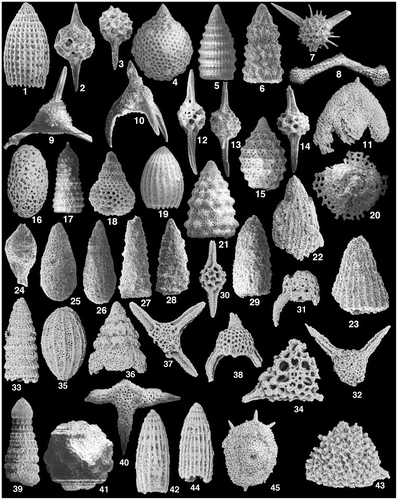
Figure 11. Field photographs. (a) Volcanic-sedimentary melange showing blocks, mainly limestone, in a matrix of shale and sandstone; the melange is traversed by sheared serpentinite (darker grey; middle distance); NW of Aziziye) (see Figure ); (b) Debris-flow conglomerate within the matrix of the volcanic-sedimentary melange. Well-rounded clasts of pelagic limestone (pale) and basalt (dark) in a sandy and pebbly matrix; road paralleling Aras Nehri (river) (see Figure ); (c) Debris-flow conglomerate with well-rounded clasts including gabbro, basalt, limestone and chert, set in a coarse sandy matrix; volcanic-sedimentary melange; near junction of main road to Çatalelma; Kırdağ area (40°28′ 12.2″N, 42°20′22.5″E) (see Figure ); (d) Thrust sheet of sheared serpentinite (foreground, left) within dismembered sequence of Upper Cretaceous volcaniclastic sandstones and shales, above and below (Eurasian margin derived; 4 km W of Akören köy, Horasan area (see Figure ); (e) Ophiolite-derived debris flow, with clasts of gabbro, basalt and serpentinite in a coarse ophiolite-derived clastic matrix; ~3.5 km NW of Dönertaş, Horasan area (40°14′36.5″N, 42°06′54.6″E). (see Figure ); (f) Metadebris flow unit within the matrix of metamorphic melange (Zümrüt Metamorphics). Stretched clasts of metabasalt and metagabbro are set in a schistose, micaceous matrix (40°33′13.1″N, 42°12′31.3″E) (see Figure ); (g) Thrust sheet of Upper Cretaceous–Palaeocene limestone related to the Eurasian margin succession, thrust over Jurassic ophiolitic gabbro; Talas Dağı area; see Figure ; (h) Isoclinal fold (S-verging), cored with dark grey chert, near the top of the carbonate platform succession; Eurasian margin succession, dated as Late Cretaceous during this work; 5 km NW of Otlukbeli; see Figure (40°01′38.8″N, 39°55′47.4″E); (i) Southward-younging succession of Upper Cretaceous volcanogenic sandstone turbidites, interbedded with mudstone; see Figure (b); near Başaklıköy; S of Karadağ (near 40°26′41.6″N, 41°50′22.8″E); (j) Debris-flow conglomerate with well-rounded clasts, including basaltic andesite and pelagic limestone set in a coarse sandy matrix; part of the Late Palaeocene?–Eocene succession that structurally underlies the Kırdağ ophiolite (SW of Bahçelikışla; 40°34′59.3″N, 42°08′49.2″E) (see Figures and ); (k) Unconformity between the Late Palaeocene–Early Eocene succession of marine clastic gravity-flow deposits and overlying Late Middle Jurassic (Bartonian) non-marine clastic sedimentary rocks (near Yukarı Kumlu; near 40°37′26.9″N, 36′07′48.4″E) (see Figures and ); (l) Open-folded marine Palaeocene sediments, unconformably overlain by non-marine red-beds, evaporites and caliche, marking the base of the Middle Eocene marine succession; view north-westwards from near Bozdoğan; Olur area (see Figure ); (m) Volcaniclastic turbidites; Middle Eocene; NW of Bozdoğan, Olur area (see Figure 39°59′03.5″N, 42°10′32.1″E); (n) Eocene marine sandstones and shales (turbidites) overlying the northern part of the suture zone. N of Erzincan (see Figure ) (39°54′53.5″N, 39°36′38.8″E); (o) Strongly folded Miocene shallow-marine sediments; 10 km WSW of Refahiye (39°54′53.5″N, 39°36′38.8″E); see Figure ).
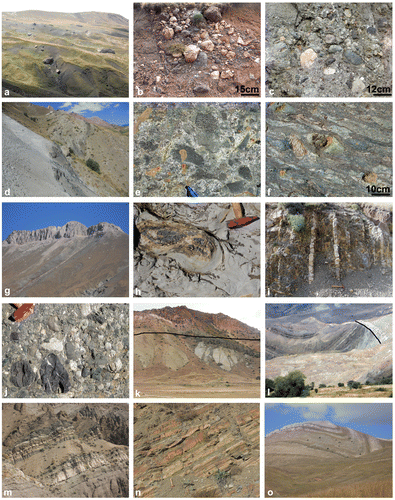
Figure 12. Setting of Upper Cretaceous pelagic carbonates, sandstone-mudstone turbidites and polymict debris-flow deposits within the volcanic-sedimentary melange. (a) Measured log; (b) Outcrop profile; (c) Tectonic model, showing a small basin that was later imbricated with the volcanic-sedimentary melange. These gravity deposits are interpreted as the remains of one of a number of small, perched basin within the Cretaceous accretionary wedge. These sediments provide evidence of a Late Cretaceous age of accretionary melange formation.

Figure 13. Rock classification diagram utilising relatively immobile elements (template according to Pearce, Citation1996). All of the volcanic rocks analysed plot in the basalt and alkali basalt fields.
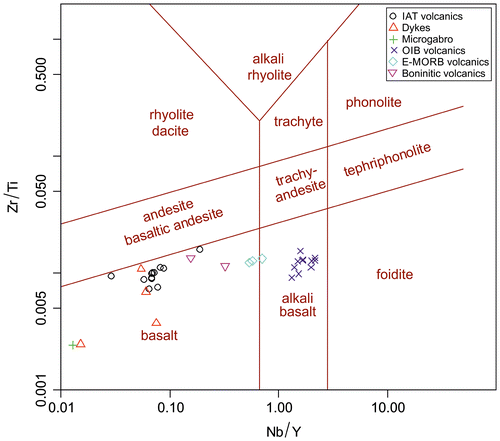
Figure 14. N-MORB-normalised rare earth element plots showing the different groups of basaltic rocks identified. Normalising values from Sun and McDonough (Citationl989). See text for explanation.
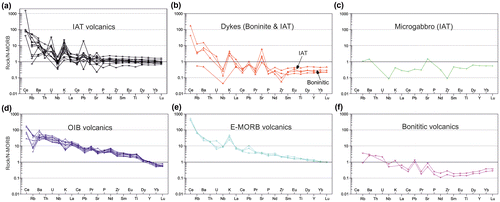
Figure 15. Chondrite-normalised rare earth element plots showing the different groups of basaltic rocks identified. Normalising values from Sun and McDonough (Citationl989). See text for explanation.
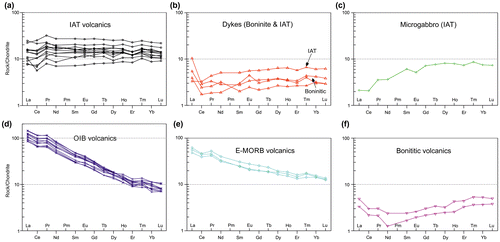
Figure 16. Cross-section showing 1 – Slices of internally coherent ophiolitic rocks (lefthand side); 2 – Volcanic-sedimentary melange, including dismembered blocks of ophiolitic rocks; 3 – Dismembered thrust sheet of Upper Cretaceous-Palaeocene? Carbonate rocks (e.g. Talas Dağı) which is correlated with the Eurasian margin succession; 4 – Unconformably overlying Oligo–Miocene succession. See Figure for location.
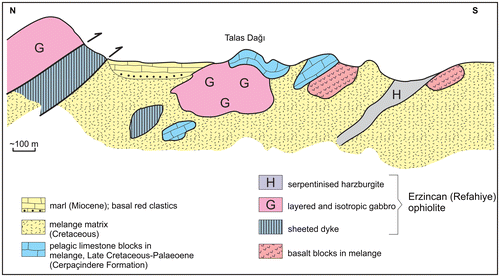
Figure 17. Outline tectonic map of the Karadağ ophiolite and related units (see Figure ). The Karadağ ophiolite includes well-preserved upper crustal rocks (layered and isotropic gabbros and basaltic extrusives). Sheeted dykes are locally exposed as small slices associated with ophiolitic gabbro (in the central south of the outcrop). The ophiolitic rocks are structurally overlain by Jurassic–Cretaceous sedimentary and volcanic rocks related to the Eurasian continental margin (compiled from Konak et al., Citation2001; Konak & Hakyemez, Citation2008b; Parlak, Çolakoğlu, et al., Citation2013 and this study). For section A–B see Figure (b).
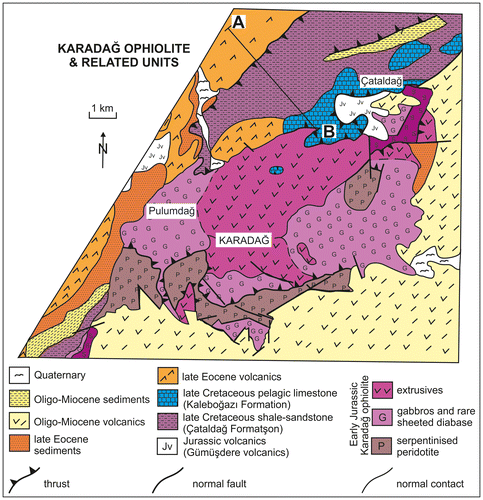
Figure 18. Outline tectonic map of the Kırdağ area. A large thrust sheet of dismembered serpentinised ultramafic rock is structurally underlain by a tectonic slice complex, which is made up of dismembered upper crustal ophiolitic rocks, intersliced with volcanic-sedimentary and ophiolitic melange and Eurasian margin-derived sediments. The ophiolitic gabbro is cut by a tonalite intrusion, radiometrically dated as Early Jurassic. Late Cretaceous pelagic carbonates and Late Palaeocene?–Early Eocene terrigenous gravity flows structurally underlie the peridotite nappe. The area also hosts a metamorphic melange (undated) with blocks of HP-LT lithologies and an underlying slice of metaterrigenous sandstone (also undated) (see Figure ; compiled from Konak & Hakyemez, Citation2008a; Konak & Sümengen (Citation2009); Parlak, Çolakoğlu, et al., Citation2013 and this study).
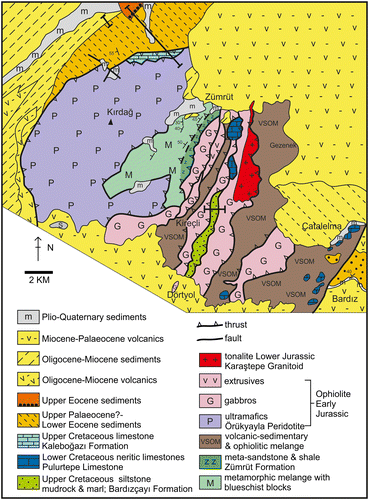
Figure 19. Outline tectonic map and cross-section of the area SW of Erzincan. A thrust sheet of plutonic rocks belonging to the Refahiye Ophiolite is structurally underlain by an unusual unit that is made up of metamorphic rocks (e.g. marble and schist), cut by swarms of diabase dykes. Ophiolitic gabbro and the volcanic-sedimentary melange are thrust over Late Cretaceous–Eocene arc-related volcanic rocks (Karadağ Massif) further south (see Figure ; compiled from Tarhan (Citation2008), Rice et al. (Citation2006) and this study).
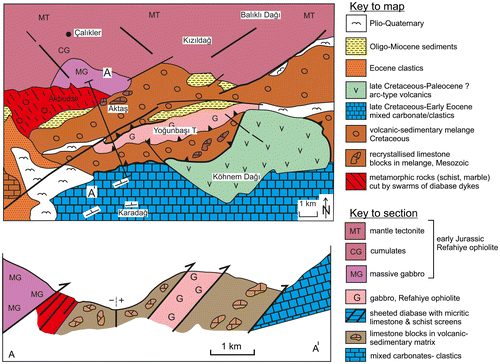
Figure 20. Selected cathodoluminesence (CL) images of dated zircon crystals. The textures are typical of igneous zircons. Homogenous areas of zircon crystals were selected for analysis, while rims were avoided. Scale bars are 50 μm long unless otherwise indicated. See text for explanation.
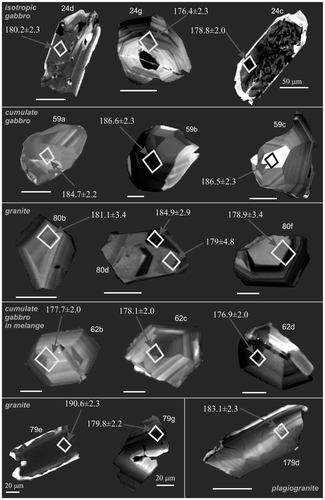
Figure 21. Key structural relationships in the Erzincan area; (a) Serpentinised peridotite cut by isolated sheared diabase dykes and later thrust over serpentinite melange; NW of Erzincan; (b) Serpentinised peridotite cut by isolated sheared diabase dykes; this was then intercalated with ophiolitic gabbro and thrust over the volcanic-sedimentary and ophiolitic melange; N of Erzincan; (c) Volcanic-sedimentary and ophiolitic melange covered unconformably by Eocene basinal sediments and, in turn, by Plio–Quaternary clastic sediments; NW of Erzincan; (d) Volcanic-sedimentary and ophiolitic melange unconformably overlain by Eocene marine sediments, including channellised facies near the base. NE of Erzincan, see Figure for locations of sections.

Figure 22. Isochron plots of age data for the dismembered and ordered ophiolites. EZ-11-62: Gabbro cumulates from a gabbroic slice within ophiolitic melange (i.e. dismembered ophiolite) in the Horasan area; EZ-11-79 and 80: Two samples from a tonalite body (Karataştepe Granitoid) that cuts isotropic ophiolitic gabbro (i.e. dismembered ophiolite) in the Kırdağ area; EZ-11-24: Gabbro cumulate from the Karadağ Ophiolite (i.e. ordered ophiolite); EZ-11-59: Gabbro cumulate from the Kop Dağ Ophiolite (ordered ophiolite), W of Aşkale); EZ-11-179: Plagiogranite cutting the sheeted dykes of the Refahiye Ophiolite, W of Erzincan (included with the ordered ophiolite although it comes from a thrust sheet beneath the main ophiolite body). The results show that all of the ophiolitic rocks and the crosscutting tonalite crystallised during Early Jurassic time. See text for further explanation.
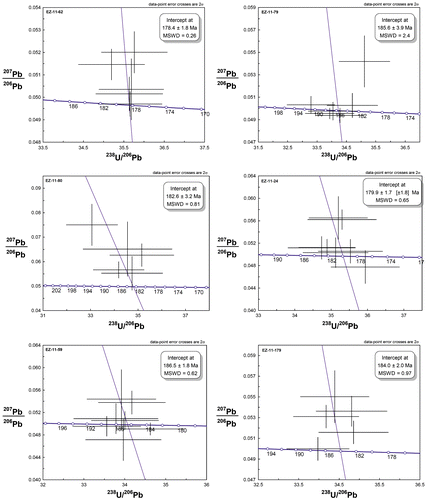
Figure 23. Outline tectonic map showing the relationship of the Refahiye ophiolite to adjacent units (Figure ) (Compiled from MTA, Citation2002 and this study.). Serpentinised peridotite, cut by diabase dykes, is overthrust by a large sheet of Jurassic metamelange, which includes a large marble unit. The area is transected by the North Anatolian Transform Fault in the northeast. The map highlights the westward extension of the Refahiye Ophiolite and the presence of metamorphic melange (locally dated as Jurassic), intersliced with ophiolitic rocks (see Topuz et al., Citation2013).
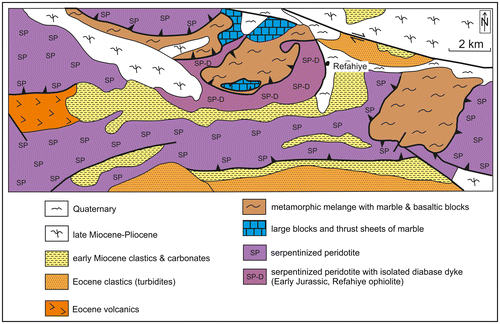
Figure 24. Cross-section of the Kırdağ serpentinised peridotite nappe in relation to underlying units. In the north, a dismembered ophiolite is thrust over Upper Cretaceous pelagic carbonates and Palaeocene?–Early Eocene terrigenous gravity flows (see Figure (b)). To the south, the ophiolite is underlain by two contrasting metamorphic units, first, a melange with blocks of HP-LT metamorphic rocks and secondly, a slice of sandstone turbidites. The melange with HP-LT metamorphic rocks includes lenses of metaclastic sediments and sheared ultramafic rocks (see Figure ; compiled from Konak & Hakyemez, Citation2008a; Konak & Sümengen, Citation2009; Parlak, Çolakoğlu, Citation2013 and this study).
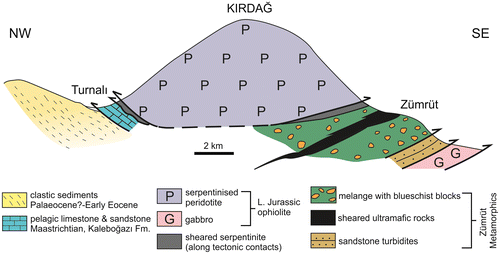
Figure 25. Cross-sections of Eurasian margin-derived sedimentary rocks that were emplaced over the oceanic rocks of the suture zone. (a) Volcaniclastic sandstones and shales passing upwards into a thick, folded sequence of Upper Cretaceous pelagic carbonates. Way-up and structural evidence suggest that this sequence forms the upper limb of a large-scale ~N-facing recumbent syncline, consistent with ~N-directed thrusting. In the NW, the sequence is thrust over red conglomerates (Oligocene?), with derived clasts of Late Cretaceous limestone. The red conglomerates are, in turn, thrust over the volcanic-sedimentary and ophiolitic melange. Şahvalet area, near Aziziye; see Figure ); (b) Upper Cretaceous volcaniclastic turbidites passing upwards into Upper Cretaceous redeposited carbonates (above a minor shear zone), which are thrust over basaltic extrusives of the Karadağ ophiolite; N margin of Karadağ massif; see Figure .

Figure 26. Regional reference successions compared to successions measured during this work. (a) Distal (southerly) Pontide continental margin; (b) Proximal (northerly) Pontide continental margin (a–b reference successions; see e.g. Okay & Şahintürk, Citationl997a); (c–e) Slices of Eurasian-derived sediments from within the Pontide suture zone. Accretionary melange was emplaced over the distal (southerly) margin of Eurasia during the Late Cretaceous, while sedimentation continued further north into Early Eocene time.
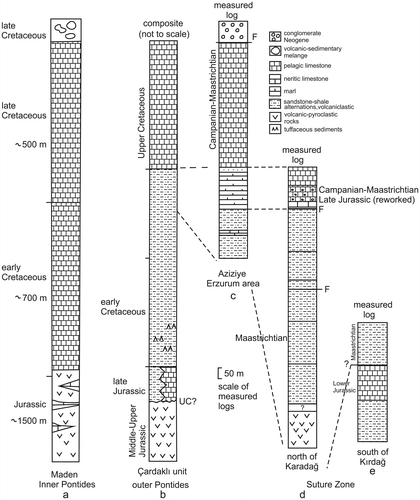
Figure 27. Photomicrographs of Upper Cretaceous–Eocene sandstones from the suture zone and the adjacent Eurasian continental margin. (a) Redeposited carbonate (packstone) with neritic bioclast fragments (e.g. bivalves, calcareous algae, echinoderm plates) in the highest levels of the Eurasian margin succession (half-polarised light); 5 km NW of Otlukbeli (SW of Bayburt); see Figure (40°01′38.8″N, 39°55′47.4″E); (b) Sublitharenite (plane-polarised light); largely quartz, altered basalt and basaltic glass, plus clinopyroxene, with a calcite spar cement (Bardızçayı Formation, near Doşkaya, Kırdağ area; see Figure ; 40°29′26.6″N, 42°13′44.8″E); (c) Subarkose (crossed nicols). Feldspar (zoned plagioclase) in a matrix of volcaniclastic siltstone, including rare clinopyroxene and hornblende; Upper Cretaceous (Bardızçayı Formation); main road south of Zümrüt (to Çatalelma), Kırdağ area; see Figure ; 40°31′21.7″N, 42°14′49.0″E); (d) Litharenite (plane-polarised light). Upper Cretaceous volcanogenic sandstone (plane-polarised light); N of Karadağ; abundant basaltic and feldspar (plagioclase grains; near Başaklı köy; see Figure (b); 40°27′24.8″N, 41°47′46.0″E); (e) Litharenite (plane-polarised light). Upper Cretaceous volcanogenic sandstone, rich in basalt and plagioclase, together with some clinopyroxene and hornblende; 4 km W of Akören köy, Horasan area (see Figure , 40°15′34.5″N, 42°12′39.1″E); (f) Litharenite (crossed nicols). Upper Cretaceous volcanogenic sandstone, compositionally similar to e; see Figure for location; NW of Aziziye; near 39°48′55.6″N, 41°22′29.3″E); (g) Litharenite (serpentinite-rich, coarse, poorly sorted sandstone (half crossed nicols); c. 3.5 km NW of Dönertaş, Horasan area (see Figure ); 40°14′36.5″N, 42°06′54.6″E). (h) As g, serpentinite grains in calcite spar cement (crossed nicols); (i) Subarkose (crossed nicols); common grains of feldspar, altered basalt and quartz with a calcite spar cement; near base of Eocene sequence, 3000 m of Ağılözü, NW of Erzincan (39°52′52.1″N, 39°19′40.5″E); (j) Litharenite (half-polarised light); basaltic grains with plagioclase microphenocrysts in matrix of devitrified glass; calcite spar cement; Middle Eocene; NW of Bozdoğan; Olur area (see Figure , 39°53′09.6″N, 39°27′23.1″E); (k) Litharenite (half-polarised light); including silicic volcanic grains; Upper Palaeocene?–Eocene succession that structurally underlies the Kırdağ ophiolite (see Figure (b); SW of Başaklı köy; 40°34′59.3″N, 42°08′49.2″E); (l) Litharenite (tuff); volcanic glass (tephra) within relatively deep-marine foraminiferal sediments (half-polarised light); Middle Eocene; NW of Bozdoğan, Olur area (see Figure ); 40°53′06.1″N, 42°06′02.7″E). Key to grains: Ba, Basalt; Ca, Calcite; C, Chlorite (altered basic volcanic); F, Feldspar; Fo, Planktic foraminifer; Py, Clinopyroxene; Q, Quartz; R, Rhyodacite; S, Serpentinite; T, Tephra (volcanic glass).
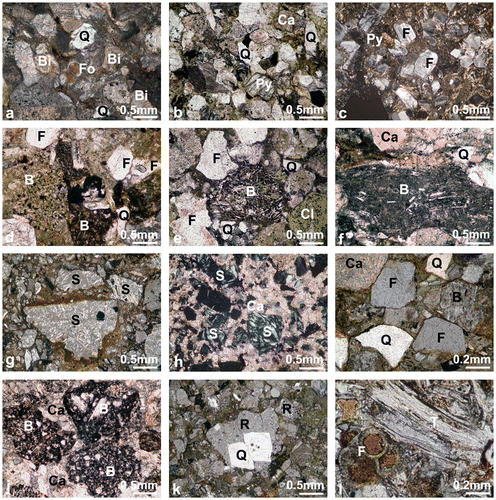
Several specific examples of informative melange relationships are summarised below. In the Şahvelet area (Figure ), the lavas and pelagic sediments commonly occur as repeated imbricate thrust sheets (e.g. along the Aras Nehri (river); Figure ). Intact lava sequences there are depositionally overlain by volcaniclastic siltstones, pelagic limestones and radiolarian sediments that are locally rich in pyrolusite (Figure (a) and (b)). Elsewhere, in the Şahvelet area (near Aziziye; Figure ), basaltic lavas are depositional overlain by radiolarian sediments that grade upwards into siliceous pelagic limestone and then into limestones (Figure (c)). Fine-grained limestones are interbedded with thin- to medium-bedded bioclastic packstones (calciturbidites). These limestones were dated as Early Jurassic in age during this study, using benthic Foraminifera (e.g. see Table ). Nearby (~250 m), another large basaltic block contains inclusions of recrystallised neritic carbonate (marble). The marble is broken into blocks and clasts that are baked in contact with the basalt. This indicates that the gravity emplacement of the carbonate rock was contemporaneous with lava eruption. In addition, basaltic lavas (up to 100 m thick) in this area are locally interbedded with and overlain by neritic carbonates (approximately 10 m thick). The assemblage of volcanic-sedimentary blocks in this area is interpreted as a fragment of an oceanic seamount capped by a carbonate platform (see below).
Table 1. Summary of the calcareous microfossils identified, as referred to in the text, together with geographical coordinates.
In the Kırdağ area (Figure ), a thrust sheet of volcanic-sedimentary melange includes large blocks (up to several hundred metres across) of neritic limestone (locally oolitic), with benthic Foraminifera that were dated as late Barremian–early Aptian in age during this study based on the occurrence of Palorbitolina lenticularis (see Table and Figure (A) (j)).
Figure 28(A). Micopalaeontological evidence. Mesozoic microfossils (benthic foraminifers, calpionellids and algae) (a) Agerina martana (Farinacci), sample 52; (b) Involutina liassica (Jones), sample 52; (a–b) Şahvalet area; Early Jurassic; (c) Calpionella alpina Lorenz (Ca), Crassicollaria sp. (C), sample 125; (d) ‘Tubiphytes’ morronensis Crescenti, sample 184; (a–d) Karadağ area; Late Tithonian; (e) Labyrinthina mirabilis Weynschenk, sample 194; (f) Protopeneroplis striata Weynschenk, sample 193, Erzincan area, block in melange; Late Jurassic (Late Oxfordian–Early Kimmeridgian). (g) Verneuilina sp., sample 26, Karadağ Massif, Late Tithonian; (h) Salpingoporella cf. S. muehlbergii (Lorenz), sample 19, Kırdağ area; Barremian; (i) Salpingoporella annulata Carozzi, sample 69, Horasan area; Early Cretaceous; (j) Palorbitolina lenticularis (Blumenbach), sample 84, Kırdağ area, late Barremian–early Aptian; (k) Mayncina bulgarica Laug et al., sample 76, Kırdağ area; Early Cretaceous; (l) Actinoporella podolica (Alth), sample 69, Horasan area; Early Cretaceous; (m) Smoutina cruysi Drooger, (n) Sirtina orbitoidiformis Brönnimann & Wirz, (o) Pseudosiderolites vidali (Douville), sample 116, Late Maastrichtian, (m–o), Şahvalet area; near Aziziye; Scale bars: .2 mm.
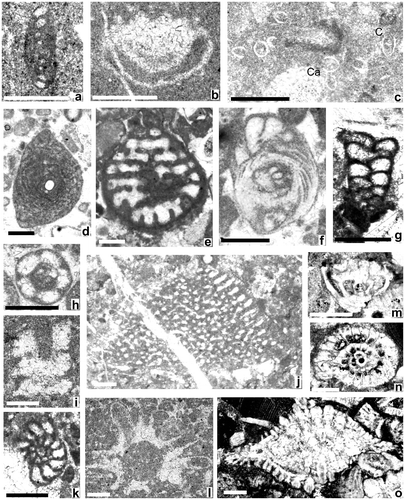
The exotic blocks and dismembered thrust sheets of basaltic lavas were, therefore, overlain by volcaniclastic sediments, neritic carbonates, redeposited carbonates or pelagic sediments in different locations.
3.2. Melange matrix
A sedimentary matrix is typically observed where there is very good exposure (Figure (a)), as in road cuttings (e.g. Erzurum area, Şahvelet area (Figure (b)), Kırdağ area (Figure (c)); Horasan area (Figure )). The matrix typically comprises matrix-supported conglomerates (Figure (b) and (c)) that are interpreted as debris-flow deposits, together with graded volcaniclastic sandstones (i.e. turbidites) and also grey, green or pale brown mudstones and siltstones (deep-sea hemipelagic deposits). The matrix sandstones are typically dominated by variable mixtures of basic-silicic igneous grains, chert, plagioclase and pelagic limestone grains, coupled with metamorphic-derived grains (e.g. quartzite; micaschist). Sandstone turbidites are locally dominated by metamorphic debris (e.g. folded micaschist; e.g. in the Şahvelet area).
In the Kırdağ area (Figure ), the matrix of the melange includes debris flows with well-rounded clasts of ophiolitic gabbro, lava and limestone set in an argillaceous or serpentinitic matrix. Sheared interbeds of pelagic limestone contain Late Cretaceous planktic foraminifera (Globotruncana linneiana, Archaeoglobigerina cretacea; see Table ).
Elsewhere, in the Horasan area (Yatıksırt; Figure ), the volcanic-sedimentary melange includes lenticular intercalations of thin-bedded pelagic carbonate, soft-weathering marl, graded sandstones (turbidites) and matrix-supported conglomerates (debris-flow deposits) (see Figure ). The conglomerates are texturally immature, with angular to subangular clasts (<1 m in size) of rock types typical of the enveloping melange (e.g. basalt, metalimestone, pelagic limestone and rare radiolarite). These sediments include Late Cretaceous planktic foraminifera (e.g. Rugoglobigerina milamensis; see Table ).
In contrast, in a few areas, the matrix of the melange is made up of sheared serpentinite. This is seen especially near the contact with overlying ultramafic ophiolitic rocks (e.g. beneath the Refahiye Ophiolite, west of Refahiye; Figure and in the Erzincan area (Figure ).
The matrix of the melange is of similar origin to the exotic blocks and dismembered thrust sheets in the volcanic-sedimentary melange (i.e. oceanic-derived). However, an additional continental source is implied by the presence of metamorphic debris (e.g. micaschist) in some areas.
3.3. Radiolarian dating of melange extrusive rocks
Samples of radiolarian chert that are interbedded with, overlying, or in close proximity to the basaltic sequences were collected, with a view to age dating, utilising well-known stratigraphical schemes (e.g. Baumgartner et al., Citation1995; Dumitrica, Immenhause, & Dumitrica-Jud, Citation1997; Goričan et al., Citation2006, Citation2013; Jud, Citation1994; O’Dogherty, Citation1994). The samples were treated with dilute hydrofluoric acid, allowing radiolarian tests to be extracted and identified. Some of the samples collected were too recrystallised to identify radiolarians. Age-significant taxa that are illustrated in Figures (A) and (B) and fully listed in Table .
Table 2. Radiolarian ages inferred from the samples studied.
In the Erzincan area (Figure ), radiolarites that are clearly interbedded with basalt gave a Pliensbachian age (east of Erzincan; see Figure (b) and Table ). In the Şahvelet area (Şahvelet Dağ), radiolarites that are again definitely interbedded with basaltic lavas also gave an Early Jurassic age (Pliensbachian) (see Figures (f) and (B) 24–29).
In the western part of the Şahvelet area, radiolarites accumulated above basaltic lavas during the Early Cretaceous (Valanginian?), as documented near Aziziye (Figures (d) and (A) 1–16). Further east in the Şahvelet area, siliceous sediments overlying basalt (Figure (a)) are dated as Hauterivian based on two samples from the Aras Nehri (river) gorge (Figures (A) 17–37 and (B) and 1–6). Another sample that was collected from radiolarites depositionally overlying basalt and pelagic limestone (Figures (b) and (e)) gave a Late Hauterivian–Early Barremian age (Figure (B) 7–21). A third sample above basalt in the vicinity yielded a Barremian age (Figure (B) 22–23). In addition, radiolarites accumulated above basalt during the Late Cretaceous (Early Turonian) in the Otlukbeli area (Figures (c) and (B), 27–29; 39–45), providing a minimum age for the basaltic volcanism locally. In addition, radiolarites that are in faulted contact with abundant basaltic lavas to the east of Erzincan (Figures (b) and (B) 30–38) accumulated during the Late Jurassic (Late Tithonian).
3.4. Petrography, geochemistry and age of basaltic rocks in the melange
The volcanic rocks in the volcanic-sedimentary melange are generally basaltic. They typically display porphyritic, microlitic-porphyritic, amygdaloidal and subophitic textures and are dominantly plagioclase- and pyroxene-phyric. Plagioclase occurs as subhedral to anhedral phenocrysts or as microliths within the matrix. The pyroxenes form euhedral to subhedral phenocrysts. The pyroxenes are commonly altered to amphibole. Calcite, chlorite, albite, epidote and opaque minerals are common secondary alteration minerals. Magnetite is present as an accessory phase. The basaltic volcanic rocks in the Kırdağ area exhibit a blueschist imprint, represented by glaucophane.
Representative samples of relatively unaltered basaltic rocks from the volcanic-sedimentary melange were analysed by inductively coupled plasma mass spectrometry (ICP-MS) for major elements, trace elements and rare earth elements (REE) at the Acme Laboratories in Vancouver, Canada (see Parlak, Karaoğlan, et al., Citation2013 for analytical methods), as presented in Table (see Table for locations). In addition, two samples of metabasalt were analysed from a unit of metamorphic melange (undated) in the Kırdağ area (Figure ). When plotted on a diagram used to classify different extrusive rock types (Figure ), the samples are basalt and alkali basalt. The analysed volcanic rocks were derived from alkaline (Nb/Y = 1.31–2.17) and tholeiitic (Nb/Y = .01–.71) magmas. Loss on ignition (LOI) values reach up to 10.5%, reflecting variable alteration, and also the presence of secondary mineral phases (e.g. epidote, calcite, chlorite).
Table 3. (a) and (b) Major, trace element and REE data for basalt, diabase and microgabbro, associated with Early Jurassic ophiolitic rocks of the suture zone (parts A and B). LOI LOI. The samples are basalt except: EZ-11-91A microgabbro dyke in tonalite; EZ-11-21A microgabbro dyke in serpentinite; EZ-11-46 sheeted diabase; EZ-11-95 diabase dyke in serpentinite; EZ-11-23 microgabbro. Locations are listed in Table .
Table 4. Locations where basaltic rocks were collected for chemical analysis.
Four main subgroups of volcanic rocks are recognised, based on their major element, trace element and REE contents (Figures and ), namely island arc tholeiite (IAT), ocean-island basalt (OIB) and enrichedmid-ocean ridge basalt (E-MORB). There are also several boninitic volcanics. Of these, the OIBs and the E-MORBs can be taken together as within-plate basalts. The boninitic volcanics are from the metamorphic melange in the Kırdağ area and are discussed separately in a later section of the paper. The IAT-type volcanics are represented by low to moderate TiO2 (.59–2.44 wt.%), moderate Zr (31.4–160.4 ppm), flat REE (LaN/YbN = .68–1.86) trends and strong negative Nb anomalies relative to MORB. The within-plate basalts are characterised by high TiO2 (2.00–4.02 wt.%) and Zr (151.9–306 ppm) contents; LREE-enriched (LaN/YbN = 3.64–17.04) patterns and enrichment of LIL elements compared to HFS elements. The boninitic volcanics display generally U-shaped REE patterns and are depleted in TiO2 (0.18–0.26 wt.%) and Zr (12.3–20.9 ppm) contents (Figures and ).
Previously, based on mapping and geochemical studies in the Erzincan area, Rice et al. (Citation2006, Citation2009) recognised subduction-influenced basalts from an association of serpentinite + basalt + radiolarite and also of OIB-type basalt from an association of serpentinite + massive limestone + lava + volcaniclastics. In addition, Parlak, Çolakoğlu, et al. (Citation2013) reported OIB-type basalts from outcrops near the main road east of Erzincan.
Combined with the radiolarian data (see Figures (A) and (B) and Table ), the available results indicate that the IAT-type basalts erupted during the Early Jurassic (Pliensbachian) in the Şahvelet area; Figure (f)). IAT basalts erupted during syn- or pre-Early Cretaceous (Late Hauterivian–Early Barremian) time along the Aras Nehri (river) (Şahvelet area; Figure (e)). Undated IAT-type basalts also erupted in the Kırdağ, Erzincan and Refahiye areas (Table ). In addition, the Pliensbachian radiolarites from the section east of Erzincan are interbedded with basalts. Both OIB-type and IAT-type basalts were previously reported from the Erzincan area by Rice et al. (Citation2009) and by Parlak, Çolakoğlu, et al. (Citation2013). Basalt from this particular outcrop (near Sansa Gorge) was analysed by Çolakoğlu (Citation2010) and found to have an OIB-type composition, indicating an Early Jurassic age for this volcanism. OIB-type basalts also erupted prior to, or during, the Late Tithonian (Figure (a)) in the Erzincan area, where an OIB composition was previously reported (Rice et al., Citation2009; Parlak, Çolakoğlu, et al., Citation2013). OIBs also erupted prior to, or during, the Early Cretaceous (Valanginian?) in the Şahvelet area (near Aziziye; Figure (d)). In addition, E-MORB erupted during, or before, the Early Turonian in the Otlukbeli area (Figure (c)).
Radiolarian results from elsewhere in the İzmir–Ankara–Erzincan suture zone suggest that MOR-type volcanism began during the Late Triassic (Bragin & Tekin, Citationl996; Göncüoğlu, Yalınız, & Tekin, Citation2006; Tekin, Göncüoğlu, & Turhan, Citation2002), while eruption continued as late as the Cenomanian (Göncüoğlu et al., Citation2006; Rojay et al., Citation2004). A comparable timing has been inferred for basalts in melange emplaced over the Tauride continental margin further south (Danelian, Robertson, Collins, & Poisson, Citation2006). In contrast, MORB-volcanism was not recognised in the East Pontide basalts analysed during this work.
4. Dismembered ophiolites
The melange in most areas (e.g. NE of Aziziye; Figure (a)) includes dismembered thrust sheets of ophiolitic rocks, especially serpentinised harzburgite and layered gabbro, up to kilometres long and hundreds of metres thick. Where highly sheared, these rocks can be considered as ophiolitic melange. The scale, distribution and geometry of these ophiolitic rocks differ from the blocks and dismembered thrust sheets of volcanic and sedimentary rocks in the melange, as discussed above. The dismembered ophiolites are discussed separately from the ordered ophiolites because, in principle, they could be of different age and origin.
4.1. Field relations of dismembered ophiolites
Ophiolitic inclusions are exemplified in the Erzincan area where large disrupted thrust sheets and blocks of gabbro and sheeted dykes are distributed through the melange (e.g. Talas Dağ area; Figure ).
In the Horasan area (e.g. near Pamukdere, Figures , , and (d)), layered gabbro (up to hundreds of metres thick) is intersliced with ophiolitic pillow lava (~100 m thick). The pillow lavas are depositionally overlain by volcaniclastic siltstone (3–5 m thick), pelagic limestone and radiolarite (3–5 m thick). Elsewhere, in the Horasan area (e.g. 3 km NW of Dönertaş; Figure ), the melange includes lenticular slices of pillow lava, sheeted diabase, gabbro and serpentinite (up to several hundred metres long). A matrix of crudely stratified ophiolite-derived debris flows is present between the disrupted ophiolitic rocks. The composition of the debris-flow deposits ranges from monomict (e.g. dunite) to polymict with clasts of massive to layered gabbro and basalt, set in a reddish sandy matrix (Figure (e)). The clasts are mostly angular, up to tens of centimetres in size, and include veins of ophicalcite within ultramafic rock (e.g. dunite). The field relations indicate that the ophiolitic rocks were exposed to seafloor erosion prior to being emplaced within the melange.
In the Karadağ area (Figures and ), the main ophiolite thrust sheet is dominated by upper crustal rocks, mainly in the form of gabbro and extrusives. Beneath this there are discontinuous thrust sheets of ophiolitic peridotite, gabbro and locally, sheeted dykes, which in general occur in a reverse order compared to the original ophiolite pseudostratigraphy. Melange is absent from between the thrust sheets. These thrust slices are interpreted as originally parts of the overriding ophiolite, which was imbricated during emplacement.
In the Kırdağ area (Figures , ), the upper ophiolitic thrust sheet is dominated by highly sheared ultramafic rocks, structurally underlain by metamorphic rocks (see below). Below, comes a tectonic slice complex with the following structural sequence (moving downwards): dismembered cumulate gabbro; ophiolitic basalt (lenticular); volcanic-sedimentary and ophiolitic melange; massive gabbro, cut by a tonalite intrusion (Karataştepe Granitoid); a dismembered sedimentary thrust sheet of Early Cretaceous age (see below); massive gabbro (with rare plagiogranite dykes); additional volcanic-sedimentary and ophiolitic melange; massive gabbro (again with rare plagiogranite dykes) and finally further volcanic-sedimentary and ophiolitic melange. The tonalite intrusion is strongly sheared, similar to the enveloping gabbro, and is cut by thin aplitic dykes (~30 cm). The eastern margin of the granite is defined by a west-dipping thrust contact with the volcanic-sedimentary melange. Near the contact, brecciated gabbro is cut by pods of coarse tonalite (several tens of cm across). The westerly contact (poorly exposed) was originally mapped as an intrusive contact with ophiolitic gabbro (Konak & Sümengen, Citation2009), although Parlak, Çolakoğlu et al. (Citation2013) show a tectonic contact. The field relations indicate that the tonalite intruded the ophiolitic gabbro and that both were later faulted and imbricated with the melange.
Very unusual and distinctive field relations are present in one known area. Screens of metamorphic rocks are exposed between diabase dykes to the SW of Erzincan (Figure ). The Refahiye Ophiolite is underlain by a discontinuous thrust sheet of sheared and faulted diabase dykes. The dykes are separated by screens of metasedimentary and metaigneous rocks, as reported by Rice et al. (Citation2006). The screens include calc-schist, marble (chert rich), micaschist, epidote–actinolite schist, metabasite, massive marble and amphibole-bearing gneiss. Individual screens include locally intact sequences (e.g. chert-rich marble), up to 60 m thick and laterally continuous for hundreds of metres. For example, the hillside .5 km SW of Akbudak (Figure ) is characterised by such screens, each up to ~10 m wide, mostly made of marble, within an overall body of sheeted diabase. Traced laterally, the dykes with metamorphic rocks screens pass into typical sheeted dykes. The presence of the metasedimentary rock screens indicates that the sheeted dykes in this area were intruded into pre-existing metamorphic host rocks, either ‘basement’ or an exhumed subduction-accretion complex. The dykes with screens have important implications for the setting of sheeted dyke intrusion and thus sea-floor spreading, as discussed further below.
Very locally in the north of the Erzincan area, gneissic rocks of the Pulur Massif are overlain directly by a small fault-bounded outcrop of sheared serpentinite (<100 m wide) (MTA, Citation2002; Figure ). This serpentinite is unmetamorphosed in contrast to the underlying gneissic metamorphic rocks of the Pulur Massif, which also include serpentinite (see Okay & Leven, Citationl996; Okay & Şahintürk, Citation1997b; Topuz, Alther, Satır, & Schwartz, Citation2004). However, the observed serpentinite appears to have been emplaced from the suture zone to the south giving an indication of the maximum northwards tectonic transport of ophiolitic rocks.
4.2. Geochemistry of dismembered ophiolites
Several samples of diabase/microgabbro dykes and a gabbro slice from the dismembered ophiolites were chemically analysed (see Table (a) and (b) and also Figures –; sample locations are given in Table ). LOI values reach up to 4.3% in the dykes and 4.6% in the gabbroic rocks, reflecting variable degrees of alteration. Sheeted dykes from the Horasan area (~3 km NW of Dönertaş; Figure ) have a highly depleted, boninitic composition. A sheeted dyke within serpentinite from the Şahvelet area reflects IAT-type magmatism. In addition, microgabbro dykes cutting the tonalite in the Kırdağ area (Figure ) are also boninitic (see Table for sample locations). A microgabbro slice in the melange from the Kırdağ area was derived from IAT-type magmatism. The IAT-type dyke is represented by low TiO2 (.51 wt.%) and Zr (21 ppm), LREE-depleted (LaN/YbN = .59) and negative Nb anomaly relative to MORB. In contrast, the boninitic dykes are characterised by very low TiO2 (.21–.33 wt.%) and Zr (4.1–13.5 ppm) contents, LREE-depletion (LaN/YbN = 1.41–2.65) and generally U-shaped patterns (Figures and ). The microgabbro slice is represented by low TiO2 (.46 wt.%) and Zr (6,6 ppm) contents, LREE-depleted patterns (LaN/YbN = 0,30) and pronounced Nb anomalies (Figures and ).
4.3. Geochronology of dismembered ophiolites and granitic rocks
In an attempt to date both the intact and the dismembered ophiolitic rocks, suitable rock types (i.e. gabbro and plagiogranite) were collected throughout the region studied. Zircon crystals suitable for radiometric dating were separated at İstanbul University and then dated radiometrically using an ion probe at the University of Edinburgh (Robertson, Parlak, & Ustaömer, Citation2013). The methods used have been reported by Ustaömer, Ustaömer, and Robertson (Citation2012). Backscattered scanning electron microscope (SEM) images of mounted and polished zircons were initially recorded, allowing selection of suitable grains for dating. Relatively homogenous areas of individual zircon grains were selected for analysis, with minimal signs of cracking or alteration. Cathodoluminescence (CL) images were prepared after the probing to check and confirm the suitability of the analyses (Figure ). The analytical data are listed in Table in both uncorrected and corrected form. Calculated isochrons for each sample dated are shown in Figure .
Table 5. Summary of the chemical data obtained by ion probe analysis. The uncorrected and corrected U–Pb isotopic ratios were used to calculate the Early Jurassic radiometric ages.
Th/U ratios of >.3 (Table ) indicate a typically igneous origin for the zircons. The CL images (Figure ) exhibit oscillatory zoning in many of the zircon grains. A few grains have undergone magmatic resorption of the rims followed by a veneer of further zircon growth; however, this was too thin to be analysed.
A gabbro cumulate (EZ-11-62) from an ophiolitic slice in the Horasan area (Figure ; see above) gave an age of 178.4 ± 1.8 Ma. In addition, one sample of plagiogranite (EZ-11-78) from a gabbroic slice in the Kırdağ area (Figure ) yielded a less accurate Mid-Jurassic age (169.7 ± 5.8 Ma). Furthermore, two samples from the kilometre-sized tonalite body (Karataştepe Granitoid) that cuts isotropic gabbro in the Kırdağ area (Figure ) yielded ages of 182.6 ± 3.2 and 185.6 ± 3.9 Ma, respectively (EZ-11-79 and 80). We, therefore, infer that the dismembered ophiolitic rocks crystallised during the late Early Jurassic (Pliensbachian-Toarcian) and were locally cut by a granitic intrusion, also of Early Jurassic age. The age error bars of the samples overlap suggesting that all of these rocks could have formed during a single Early Jurassic period of sea-floor spreading and oceanic granitic intrusion.
5. Ordered ophiolites
The ordered ophiolites are defined as large-scale thrust sheets that retain portions of a typical ophiolite pseudostratigraphy. However, even these ophiolites are commonly faulted and thrust imbricated, as seen in the Refahiye Ophiolite in the Erzincan area (Figures , ). Descriptions of some of the ordered ophiolites are given by Parlak, Çolakoğlu, et al. (Citation2013). Here, we summarise these results and provide new information concerning some additional outcrops.
5.1. Field relations of ordered ophiolites
In the far west of the area, the Refahiye Ophiolite, as exposed SW of Erzincan (Figure ), comprises harzburgites with a well-developed mantle tectonite fabric (trending 080°/85°N), interspersed with layers of dunite (trending 068°/27°NW). Pyroxenite dykes cut the fabric of the mantle rocks or trend parallel to the fabric of the mantle rocks. The harzburgitic mantle is intruded by microgabbro and diabase dykes at different structural levels, as well exposed near Çalıklar village (Figure ). Pyroxenite, dunite and cumulate gabbroic rocks dominate the upper levels of the exposed mantle sequence in this area (e.g. along the road from Çalıklar to Akbudak), reflecting a transition from mantle tectonites to ultramafic cumulates.
North and east of Erzincan, the Refahiye Ophiolite encompasses three large thrust sheets (Figure ). The highest thrust sheet (difficult to access) is mainly serpentinised peridotite (W of Göller). The middle thrust sheet is extensively exposed to the N and NE of Erzincan. This begins with mantle tectonite, largely harzburgite, with lesser amounts of dunite and chromitite, as exposed south of Karataş (Figure ). Listvenite occurs along tectonic contacts within the mantle tectonites. Listvenitisation commonly occurs along thrust zones, within ultramafic rocks. Such thrusts have acted as pathways for fluids, resulting in alteration and mineralisation. Silica-carbonate alteration and the development of listvenites are significant because they mainly postdate serpentinisation of ultramafic rocks. This, in turn, implies that the ultramafic rocks were extensively serpentinised before the thrusting took place.
The sequence passes upwards into cumulates and then into massive gabbro and sheeted dykes. However, the contacts between each of the main ophiolite lithologies are sheared and commonly faulted. The cumulate rocks are characterised by alternations of dunite, pyroxenite, wherlite and gabbro. A large outcrop of isotropic gabbro is seen in the central part of this ophiolite thrust sheet, to the NNE of Erzincan. Sheeted dykes crop out as one or several tectonic slices beneath the gabbroic rocks to the east of Erzincan (e.g. west of Talasdağ; Figure ). However, a contact between sheeted dykes and isotropic gabbros is locally preserved and intruded by plagiogranite dykes (10 cm–2 m thick). Sheeted dykes are also present as large blocks within the structurally underlying melange (Figure ; see above).
The dykes are strongly faulted, sheared and brecciated. The lowest thrust sheet that is widely exposed NE of Erzincan is dominated by serpentinised harzburgite. These rocks are cut by swarms of diabase dykes together with rare pyroxenite dykes (e.g. Parlak, Çolakoğlu, et al., Citation2013; Rice et al., Citation2006, Citation2009). The diabase dykes, up to 8 m thick, are discontinuous, typically over tens of metres. These dykes were disrupted owing to strong layer-parallel extension during their emplacement (Figure (a) and (b)).
Further east, the intact Karadağ Ophiolite (Figure ; see Parlak, Çolakoğlu, et al., Citation2013) begins with serpentinised mantle tectonites, with dunites and podiform chromites. An interval of listvenite development (50–70 m thick) occurs near the basal tectonic contact. The mantle tectonites are separated from massive to cumulate gabbros above by a tectonic contact. The gabbroic unit includes gabbro, gabbronorite and rare anorthosite bands. The gabbro section is locally seen to pass upwards into sheeted dykes complex and extrusive rocks.
The southern margin of the ophiolite is strongly faulted, and the outcrops of sheeted dykes occur separately from the main body of gabbro and volcanic rocks that are exposed further north (Pulumdağ and Karadağ; Figure ). For this reason, the sheeted dykes are included with the dismembered ophiolites (see above). The Kop Dağ Ophiolite forms a large ophiolitic massif (>50 × 20 km) between Erzurum and Bayburt (Figure ), which is dominated by mantle harzburgite. These rocks are locally rich in chromite and dunite. Lherzolite, wehrlite and pyroxenite constitute minor parts of the Kop Dağ ultramafic rocks (Kolaylı, Citation1996). The ultramafic rocks pass upwards into gabbroic rocks (Kolaylı, Citation1996; MTA, Citation2002; Figure ). Cumulate gabbro rocks are well exposed along the road from Aşkale (Erzurum) to Bayburt.
Lastly, the Şahvelet Ophiolite (Figure ) is dominated by ultramafic rocks especially serpentinised harzburgite. Chromite-rich horizons occur within dunitic zones and within layered gabbros (Erdoğan, Citationl972). Pegmatitic gabbros occur within the layered gabbros. The mantle tectonites are intruded by numerous diabase dykes that are exposed at different structural levels (Parlak, Çolakoğlu, et al., Citation2013).
Taken together, the above outcrops preserve all of the parts of a typical ophiolite pseudostratigraphy, that is, harzburgite tectonite, layered cumulates, isotropic gabbros, sheeted diabase and basaltic extrusives, although no complete ophiolite is preserved in any one section. The upper levels of the ophiolite are typically preserved as imbricate thrust sheets near the base of larger gabbroic-ultramafic thrust sheets (e.g. Karadağ and Refahiye ophiolites) and similar upper-level ophiolitic rocks occur locally in adjacent melange (Refahiye ophiolite). This suggests that the intact and dismembered ophiolites may have a common origin.
5.2. Geochronology of ordered ophiolites
The objectives here were to radiometrically date the ordered ophiolites (for the first time) and to compare the ages of the ordered and dismembered ophiolites to determine whether or not all of the ophiolitic rocks relate to a single phase of sea-floor spreading.
Samples of gabbro and plagiogranite were collected from the ordered ophiolites and radiometrically dated, as described above for the dismembered ophiolitic rocks (see Table ). Sample localities are given in Table .
Zircons from the gabbro and plagiogranite are mostly euhedral, but a few anhedral crystals are also present, as seen on CL images (Figure ). The zircons are generally short, stubby crystals (aspect ratio close to 1), but needle-shaped, prismatic crystals (aspect ratio < .5) are also present. The CL images commonly exhibit oscillatory growth zoning, typical of an igneous origin. Some crystals exhibit sector zoning while one crystal displays chaotic internal structure, possibly due to post-crystallisation or hydrothermal alteration. A few crystals have undergone marginal magmatic resorption, followed by a veneer of later zircon (not analysed). The Th/U ratios (Table ) of the dated zircons (>.3) confirm an igneous origin. The analytical data (uncorrected and corrected) are given in Table , while the calculated isochrons for each sample dated are given in Figure .
A gabbro cumulate from the intact sequence of gabbroic rocks within the Karadağ Ophiolite gave an age of 179.9 ± 1.7 (Ma) (2σ) (EZ-11-24; Figure ). In addition, a gabbro cumulate from the dismembered Kop Dağ Ophiolite (W of Aşkale) gave an age of 186.5 ± 1.8 (Ma) (2σ) (EZ-11-59; Figure ). Finally, a plagiogranite cutting the sheeted dykes of the Refahiye Ophiolite (E of Erzincan) yielded an age of 184.0 ± 2.0 Ma (EZ-11-179). However, it should be noted that this is from a thrust sheet below the main ophiolite.
We, therefore, infer that several of the ordered ophiolites crystallised during the Early Jurassic (Karadağ and Refahiye ophiolites). The ages obtained do not differ significantly from those obtained from the dismembered ophiolites (Kırdağ and Horasan areas; see above), suggesting that all of the ophiolitic rocks and the granitic intrusion (Kırdağ area) formed during the Early Jurassic (i.e. Refahiye, Kop Dağ, Kırdağ and Horasan ophiolitic rocks), while the Şahvelet ophiolitic rocks remain undated.
6. Metamorphic melange
Two main assemblages of metamorphic rocks occur within the areas of the suture zone: first, metamorphic units that lie within the outcrops of the unmetamorphosed volcanic-sedimentary and ophiolitic melange, and secondly, metamorphic units that occur independently of the melange. The metamorphic rocks are important for any interpretation as they could be indicative, for example, of older Pontide ‘basement’, exhumed subduction complex material or emplacement-related subophiolite metamorphism.
6.1. Metamorphosed volcanic-sedimentary melange
The lithologies and field relations of the metamorphic melange are very similar to the unmetamorphosed melange. The main difference is that this melange has undergone low-grade metamorphism of up to greenschist facies and is typically more strongly deformed. For example, in the Şahvelet area (Figure ), the metamorphic melange occurs as patchy inclusions, hundreds of metres to several kilometres in size, within the typical unmetamorphosed volcanic-sedimentary melange. A penetrative cleavage is developed in the metamorphic melange, coupled with recrystallisation of limestone and chert and the alteration of the typically brownish argillaceous melange matrix to a green-grey colour.
The metamorphic melange is interpreted as local bodies of exhumed volcanic-sedimentary melange and is likely to be of Cretaceous age, similar to the age of the enveloping unmetamorphosed melange.
6.2. Metamorphic melange with eclogite blocks
In the Refahiye area, two large bodies of metamorphic rocks overlie peridotites of the Refahiye Ophiolite (i.e. east and west of Refahiye; Figure ). The outcrops west of Refahiye town show the following tectono-stratigraphy (the outcrop to the east was not studied). The lower part is mostly green phyllite (with minor sheared serpentinite). This followed by blocks of marble, with recrystallised chert intercalations (mostly <50 m across) and also blocks of metabasalt (mostly <10 m across). The matrix, where exposed, is largely phyllite, micaschist, metarudites (metadebris flows), with clasts including volcanic and carbonate rocks. A large body of metalava follows (>250 m wide in outcrop), then marble (vaguely bedded >60 m thick), which caps the highest hill in the area. Further northwest, an extension of the same melange is overthrust by serpentinised harzburgite (Figure ).
Topuz et al. (Citation2013) have recently dated several blocks of eclogite, of assumed ophiolitic origin, that are surrounded by garnet amphibolite and garnet micaschist, from which they obtained a U–Pb rutile age of 172 ± 4 Ma. From this result, they inferred that both the Refahiye Ophiolite in this area and the associated metamorphic rocks are Early–Middle Jurassic in age.
Here, we interpret the metamorphic rocks west of Refahiye as accretionary melange of at least partially Early Jurassic age. This suggests an older age for at least some of the sedimentary and volcanic blocks and inclusions (Late Triassic?). The position of the melange sandwiched with ultramafic ophiolitic rocks is likely to relate to much younger (collisional?) re-imbrication; thus, its Jurassic tectonic setting is uncertain (i.e. continental margin or intra-oceanic subduction complex).
6.3. Metamorphic melange with meta-limestone blocks
To the east of Erzincan (Figure ), the melange and the ophiolitic rocks, described above, are underlain by metamorphic rocks made up of dark-coloured phyllite, metavolcaniclastic sandstone, metavolcanic debris-flow deposits, metacarbonates, plus some basic to silicic metalavas (Yoncayolu Formation of Tarhan, Citation2008). The uppermost levels of the metamorphic unit are characterised by a dismembered thrust sheet of metacarbonate rocks (~80 m thick × 5 km long). A separate exposure further northeast (near Göller; Figure ) is mainly phyllite, calc-schist and marble, with occasional marble blocks. Small-scale folds in this melange are locally SW facing. These metamorphic rocks remain undated, although they have been compared with the Triassic Nilüfer unit of the Karakaya Complex owing to general similarities in composition (i.e. dark phyllitic matrix and Permian? limestones; e.g. Tarhan, Citation2008).
The above metamorphic rocks show close similarities with the Ağvanis Massif (Figure ), which has been interpreted by Okay (Citationl984) as part of the Pontide basement beneath Mesozoic sequences. Recent work on part of the Ağvanis Massif shows that there is an ordered succession of dark metavolcanogenic sediments, in places intercalated with metacarbonates forming laterally continuous beds and rare metacherts. The top of the succession is made up of dark grey to black phyllites, followed by thicker-bedded metacarbonates (Özgülük, Ustaömer, Ustaömer, & Gerdes, Citation2009; Ustaömer, unpublished data). The exposures north and northeast of Erzincan and the Ağvanis Massif and are likely to relate to active continental margin processes, but their formation age remains uncertain.
6.4. Metamorphic melange with blueschist blocks and meta-clastics
In the Kırdağ area (Figures and ), the ophiolite is underlain by two contrasting thrust-bounded units of metamorphic rocks, mapped together as the Zümrüt Metamorphics, which were assumed to be of Triassic age (i.e. related to the Karkaya Complex) by Konak and Hakyemez (Citation2008b), although they remain undated.
The upper of the two units is a metamelange that includes glaucophane within metabasic blocks (Parlak, Çolakoğlu, et al., Citation2013; Yılmaz, Terlemez, & Uysal, Citation1988b). Additional information is reported below. The most common blocks are coarse sedimentary breccia-conglomerate with strongly flattened clasts <80 cm in size (Figure (f)). Some of the clasts were originally well-rounded indicating much abrasion during sedimentary transport. The main clast lithologies are metabasalt, amphibolite, marble (commonly isoclinally folded), micaschist (i.e. metasandstone), pelitic schist (i.e. metamudrock), metagabbro (brecciated), metadiabase, metaharzburgite and microcrystalline quartz (metachert). Several of the individual breccia-conglomerate units are packed with gabbro clasts, while others are mostly metadiabase or metachert. The clast fabrics indicate deposition as lenticular debris-flow deposits. The mineral assemblage in the metaigneous clasts includes tremolite, actinolite, glaucophane, albite, epidote, calcite and chlorite (Konak & Hakyemez, Citation2008b and this study). The evidence of HP/LT metamorphism is restricted to the metabasaltic rocks in the melange. The matrix (poorly exposed) is mostly greenish to dark grey pelitic schist. The metamorphic melange includes lenses of highly sheared schistose serpentinite (up to several hundred metres long × tens of metres wide) (Figure ).
Two samples of metabasic igneous rocks from the metamelange were chemically analysed using the methods specified above and were found to have a boninitic composition (Table (a) and (b); Figures –; see Table for sample locations).
The metamelange is underlain by a slice of metasandstone-shale (up to ~100 m thick). Although having experienced metamorphism, apparently under greenschist facies condition, the metaclastics retain primary depositional features. The metasandstones are up to thick bedded, fine to medium grained and exhibit dark shale interbeds and partings. Little grading is evident within individual beds. Small-scale folds are rarely present, also common crosscutting quartz veins. Although largely recrystallised, the sandstones retain moderately well-rounded detrital grains of plagioclase, unstrained quartz, metamorphic (polycrystalline) quartz, quartzite and micaschist, suggestive of plutonic igneous and metamorphic origins.
The metamelange beneath the Kırdağ Ophiolite (Zümrüt melange) includes debris-flow deposits with blueschist clasts that were derived from all parts of the ophiolite, including boninitic rocks. This suggests an origin as sedimentary melange (‘olistostromes’), shed from the Early Jurassic ophiolitic rocks when they were uplifted and eroded. The melange was then subducted, exhumed and incorporated into the finally emplaced thrust stack. The sedimentary melange may be comparable with the Upper Cretaceous blueschists of the Lesser Caucasus (Rolland, Billo, Corsini, Sasson, & Galoyan, Citation2009).
In addition, the metasandstone-shale could either be part of the ‘basement’ (Triassic Karakaya Complex) or a metamorphosed fragment of the later-Mesozoic Eurasian continental margin succession. The presence of relict metamorphic grains in the underlying thrust sheet of metasandstone suggests a Pontide continent-related origin. However, there are no confirmed occurrences of the Triassic Karakaya Complex in the Eastern Pontides, in contrast to the Central and Western Pontides.
In passing, it should be noted that an outcrop (15 × 10 km) of ‘metamorphic rocks’ shown south of Şahvelet Dağ on the 1:500,000 map of Turkey (MTA, Citation2002) is instead Neogene sediments and volcanogenic rocks.
7. Eurasian continental margin-related sedimentary and volcanogenic rocks within the suture zone
The suture zone includes several intercalations of Jurassic–Cretaceous sedimentary and volcanogenic rocks that were previously described locally in several reports of the General Directorate of Mineral Research and Exploration of Turkey (MTA) and commonly treated together with the melange (e.g. Parlak, Çolakoğlu, et al., Citation2013). Here, we present new sedimentary evidence for the depositional processes, petrographic evidence for the provenance and new palaeontological dating indicating the age of these units.
In the east, the large-scale Karadağ Massif to the west of Erzincan is within the mid part of the suture zone (Figures and ). The succession in the Karadağ Massif begins with Upper Cretaceous pelagic limestones and passes upwards into a thick succession of basaltic andesites and volcanogenic sedimentary rocks of inferred Late Cretaceous age (Karadağ Formation; see Rice et al., Citation2009). The volcanogenic succession is overlain, commonly with a thrust contact, by shallow-marine sediments of Upper Palaeocene–Eocene age (Sipikör Formation; see Rice et al., Citation2006).
The Karadağ Massif (Erzincan) is interpreted as Upper Cretaceous arc-related volcanism, overlain by a Palaeocene–Eocene age forearc basin. The succession can be correlated with the Eurasian continental margin, with important implications for the timing and processes of melange and ophiolite emplacement.
Further east, also in the Erzincan area, a dismembered thrust sheet of limestone occurs within and above the volcanic-sedimentary and ophiolitic melange (Talas Dağı; Figure ). This was mapped as the Sütpınar Formation (~Çerpaçindere Formation), of Late Palaeocene age by Aktimur, Tekirli, and Yardakul (Citation1990). A large mass of limestone, viewed from the west, appears to form a large ‘klippen’ on top of the volcanic-sedimentary and ophiolitic melange (Talas Dağı; Figures (g) and ). However, this sequence is dismembered into discontinuous units (600 m long × <100 m thick), when mapped out. This succession of Eurasian margin affinities has both overthrust the melange and been incorporated into the melange.
In the Şahvelet area, the volcanic-sedimentary and ophiolitic melange is structurally overlain by an intact thrust sheet of Upper Cretaceous volcaniclastic sandstones and pelagic limestones (near Aziziye; Figures , (a), and ). The succession, which is well exposed along a valley NW of Aziziye, (see Figures (f) and (B) (c-e) begins with dark-hearted, nearly massive sandstones. After a short interval of thin-bedded pelagic limestones there is a return to sandstones and marly pelagic limestones. Above, come medium-bedded volcaniclastic sandstone turbidites, showing grading, parallel lamination and micro-cross lamination, indicating that the succession is inverted (Figure (a)). A thick succession (<500 m) of Upper Cretaceous (Campanian–Maastrichtian) pelagic carbonates follows, with occasional small-scale N-verging folds. This succession can be correlated with the Eurasian margin succession with which it is similar in terms of lithology and age (see below). In the NW, the Upper Cretaceous succession is thrust over reddish non-marine conglomerates. These conglomerates include subrounded clasts (<.6 m in size) of pelagic chalk and also bioclastic limestone with reworked large foraminifera of Late Maastrichtian age (Figure (A) (m–o)). The reddish conglomerates are similar to red clastic rocks mapped as Oligocene elsewhere in the region. The Upper Cretaceous succession is interpreted as the inverted upper limb of a large-scale north-facing recumbent fold (nappe) of which the upper right-way-up limb is not preserved. This structure was emplaced northwards over the reddish non-marine sediments, which in turn were thrust over the volcanic-sedimentary melange.
Figure 28(B). Micopalaeontological evidence. Late Cretaceous planktic foraminifera and Miocene large foraminifera. (a–b) Hedbergella sp., sample 165, Otlukbeli area, Late Cretaceous; (c) Archaeoglobigerina cretacea (d’Orbigny), sample 112; (d) Schackoina multispinata (Cushman & Wickenden), sample 114; (e) Globotruncanella petaloidea (Gandolfi), sample 58; (c–e) Şahvalet area; near Aziziye; (f) Globotruncana bulloides Vogler, sample 43A; Horasan area; near Yatıksırt); (g) Rugoglobigerina rugosa (Plummer), sample 68; (h) Planoglobulina carseyae (Plummer), sample 68; Horasan area; W of Akören; (i) Globotruncana orientalis El Naggar, sample 111; Şahvalet area; near Aziziye; (j) Rugoglobigerina milamensis Smith & Pessagno, sample 34a; Horasan area; near Kalendere; (k) Globotruncanita pettersi (Gandolfi), sample 68; (l) Racemiguembelina fructicosa (Egger), sample 68; Horasan area; W of Akören; (m) Abatomphalus mayaroensis (Bolli), sample 35A; Horasan area; near Kalendere; (n–p) Miocene benthic foraminifera, n: Operculina complanata (Defrance) (O), Amphistegina lessonii (d’Orbigny) (A), coralline alga (C), sample 175; E of Erzincan, main road sectional o: Borelis sp., sample 88; Şahvalet area; W bank of Aras Çay; p: Miolepidogypsina sp., sample 178; NE of Erzincan; S of Kapılıdağ. Scale bars: .2 mm.
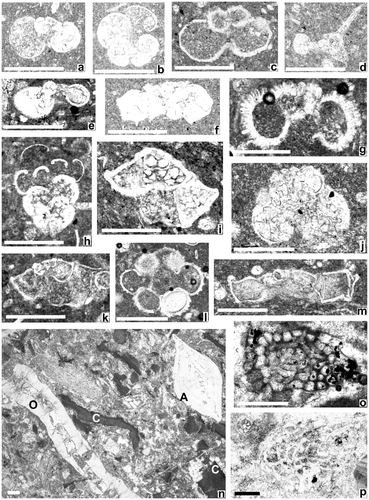
In the Karadağ area (Figure ), the northern margin of the ophiolite is overlain by a discontinuous thrust sheet of Jurassic volcanic rocks (Gümüşdere volcanics), which Konak and Hakyemez (Citation2008a) have correlated with the intact Eurasian margin succession further north (e.g. Çardaklı unit; see Figure (b)).
In the northwest of the Kırdağ area, the ophiolitic peridotite is underlain by a thin (<100 m thick), discontinuous, thrust sheet of Upper Cretaceous marls and sandstones. The outcrops are deformed by an intense N-dipping fracture cleavage (Kaleboğazı Formation of Konak & Hakyemez, Citation2008b; Figures and ). Despite being largely recrystallised, the sandstone has a mixed siliciclastic–volcaniclastic composition, with angular to subrounded, clear unstrained quartz grains (volcanogenic), devitrified volcanogenic grains and lithoclasts of quartzite and micaschist.
Further southeast, in the Kırdağ area (Figures and ), the imbricate slice complex includes a dismembered thrust sheet of mainly Cretaceous sedimentary rocks. The succession, as exposed 3 km N of Kireçli (Figure (e)), begins with dark greenish grey siltstone, interbedded with occasional fine- to medium-grained sandstones. Individual sandstone beds exhibit sharp bases and tops, typical of current-deposited sands. The sandstones pass transitionally upwards into bioclastic and oolitic limestones and slightly nodular pink limestone (Pulurtepe Limestone), containing Early Cretaceous (Berriasian–Barremian) benthic foraminifera (Figure (A) (h)). The limestones grade upwards into an intact succession of fine- to medium-grained, thin- to medium-bedded, dark grey volcaniclastic siltstones and fine-grained sandstones (Bardızçay Formation; see Figure (b) and (c)). Overlying hemipelagic marls yielded Maastrichtian planktic foraminifera, including Pseudosiderolites vidali and Smoutina cruysi (see Table ). In places, the limestone is disrupted into lenticular blocks that are locally rotated or structurally repeated, as seen along the main road (N of Kireçli). Elsewhere, the limestone is structurally thinned and degenerates into blocks scattered through shale and sandstone (e.g. between Kireçli and Dörtyol; Figure ). This locally gives the impression of being melange but has resulted from intense layer-parallel extension and breakup of an originally intact succession.
Figure 29. Cross-section and sedimentary log of Jurassic–Cretaceous sedimentary succession within imbricate thrust sheets to the SE of the Kırdağ massif (see Figure for location). In general, Early Cretaceous neritic limestones and siltstones/mudrocks are overlain by Upper Cretaceous volcanogenic siltstone and fine-grained sandstones.

In the southern part of the Horasan area (near Kalendere; Figure ), an elongate, fault-bounded outcrop of pelagic limestone is dated as Late Cretaceous based on planktic foraminifera (Figure (B) (m)). This pelagic limestone is homogeneous and well lithified in contrast to the soft, deformed marls within the melange in this area. The pelagic limestones are interpreted as a fragment of the Upper Cretaceous Eurasian margin succession that includes similar pelagic limestones (e.g. Konak et al., Citation2001; see Figure (a–b)).
Further north in the Horasan area, dismembered successions of volcaniclastic sandstones, mudstones and debris-flow deposits are interleaved with ophiolitic melange (Figure ; W of Akören). A structurally lower succession (Figure ) begins with medium-bedded volcaniclastic sandstones with interbedded mudrocks and hemipelagic marls, containing gastropods and Cretaceous (Albian–Maastrichtian) planktic foraminifera (Hedbergellidae; Globotruncana dupeublei, Globotruncanita pettersi (see Table ). Overlying neritic limestone (a possible block, tens of metres across) is rich in fragments of large bivalves and is followed by feldspar-phyric lava (another possible block). Intercalated sandstones are dominantly volcanogenic, assuming that the common microcrystalline quartz originated as recrystallised silicic volcanic material. There are also numerous grains of serpentinite (locally sheared). After an ophiolitic intercalation, the succession resumes with pebbly sandstones containing subrounded to rounded clasts (<5 cm thick). Another ophiolitic slice follows (~10 m of sheared serpentinite). This is, in turn, followed by a locally intact succession of mudrocks, volcaniclastic sandstones (Figure (e)), debris-flow conglomerates and pelagic carbonates that contain Late Maastrichtian planktic foraminifera (Figure (B) (g), (h), (k), (l)). Overlying lenticular (channellised) conglomerates (~5 m thick individually) contain angular to subangular clasts (<.8 m in size) of silicic intrusive rocks (granite-diorite), volcanic rocks and neritic limestone. The limestone clasts are dated as Early Cretaceous in age (Berriasian–Barremian; Figure (A) (i), (l)) based on benthic foraminifera (e.g. Pseudocyclammina lituus, Charentia sp., Spiroloculina sp., Salpingoporella annulata, Actinoporella podolica; see Table ). Intercalations of large-scale debris flows (up to 90 m thick, individually) are dominated by angular clasts and blocks of neritic limestone, set in a mud-rich matrix. The matrix of these blocks includes latest Cretaceous planktic foraminifera (e.g. near Yatıksırt; Figures and (B) (f)). The succession finally grades upwards into massive debris-flow deposits with detached blocks of limestone (‘olistoliths’) set in a matrix of latest Cretaceous age.
Figure 30. Cross-section showing interslicing of Cretaceous Eurasian margin-related sediments with ophiolitic rocks; Horasan area (see Figure ). The Eurasian margin units are tectonically dismembered, while the intact sequences include interbedded debris-flow deposits.
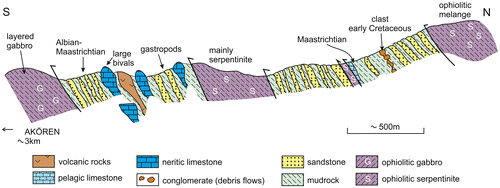
The dismembered Upper Cretaceous succession in the Horasan area is interpreted as gravity flows that were mostly derived from a volcanic arc and from ultramafic ophiolitic rocks within a forearc basin that bordered the Eurasian continental margin. The ophiolitic rocks were locally reworked on the seafloor as mass-flow deposits (Figure (g) and (h)) before being finally emplaced together with the volcaniclastic succession.
In summary, taken together, the Upper Cretaceous sequences are interpreted as emplaced fragments of a regional-scale Eurasian forearc basin.
8. Late Cretaceous–Early Cenozoic Eurasian margin successions
In several areas, the ophiolitic rocks and/or the melange are covered by thrust sheets of Mesozoic–Palaeogene sedimentary rocks. Although locally fault disrupted, in adjacent areas similar sequences extend stratigraphically downwards into relatively autochthonous successions of the Eurasian continental margin (Figure ). These successions can be compared with the dismembered successions of the same age within the suture zone to the south (see above) and the autochthonous Eurasian continental margin to the north.
8.1. Jurassic–Cretaceous successions
In the Erzincan area, the volcanic-sedimentary and ophiolitic melange is in north-dipping fault contact with the regional Eurasian margin carbonate platform of Jurassic–Cretaceous age. For example, ammonite-rich pelagic limestone (Ammonitico Rosso) belonging to the regional carbonate platform was locally dated as Late Jurassic (Late Oxfordian–Early Kimmeridgian) in the northwest of the area (near Yeşilyurt; Figures and (A) (d–f)). The north-dipping fault contact probably relates to post-suturing southward re-thrusting (see below).
In the Otlukbeli area (Figure ), the Eurasian margin carbonate platform is overlain by volcanic-sedimentary melange with a transitional sedimentary contact (Figure (a) and (b)). The age relationships provide important new evidence for the timing of melange emplacement in this area. Jurassic volcanogenic rocks of Eurasian margin origin are overlain by pelagic limestones that contain lenses of chert of diagenetic replacement origin (i.e. Hamurkesen Formation; Korkmaz & Baki, Citationl984). Outcrop-scale folds verge northwest (as well seen within chert; Figure (h)), subparallel to the platform-melange contact. The highest levels of intact platform succession (~8 m thick) comprise pelagic limestone with interbeds of redeposited silty calcarenite (calciturbidites). These pelagic limestones contain planktic foraminifera of Late Cretaceous age (e.g. Hedbergella sp.; see Table ). The calciturbidites contain reworked Early Cretaceous benthic foraminifera and other bioclastic grains (see Table ). The silty layers show grading, parallel lamination and contain grains of altered basic volcanic rocks, rare plagioclase, polycrystalline (metamorphic) quartz and rare biotite (Figure (a)). The intact succession is followed by disrupted lenses of pelagic carbonates with dark grey chert nodules and planktic foraminifera, again dated as Late Cretaceous in age (Figure (B) (a), (b)). Redeposited carbonate interbeds (up to 1.5 m thick) are again rich in bioclastic debris but lack ophiolite-derived material. The disrupted lenses are interpreted as fragments of the highest levels of the platform succession that were detached and entrained with the overlying volcanic-sedimentary melange during its emplacement over the carbonate platform.
Figure 31. Highest stratigraphical levels of the Eurasian margin carbonate platform and overlying volcanic-sedimentary melange (near Otlukbeli, W of Bayburt; (a) Outline geological map (modified from Bozkuş & Yılmaz, Citationl993); (b) Cross-section A–A′. The highest stratigraphical levels of the platform are dated here as Campanian–Maastrichtian using planktic foraminifera; (c) Dismembered thrust sheet (large block) within the volcanic-sedimentary melange in the SE of the area (B–B′). (see Figure ; compiled from Korkmaz & Baki, Citationl984, Özer, l984 and this study).

In the Karadağ area, the ophiolitic rocks are structurally overlain by (or in local fault contact with) a thick sequence (up to 250 m) of volcaniclastic and carbonate sediments of Late Cretaceous age (Kaleboğazı Formation of Konak et al., Citation2001) (Figures , (b), and (d)). The succession (from near Başaklıköy to near Çataldağ; Figure (b)) is dominated by regular alternations of volcaniclastic sandstone and shale, hundreds of metres thick (Figures (i) and (d)). The presence of sharp bases and gradational tops provides clear evidence of stratigraphical way up. Individual beds are up to 2.5 m thick, with grey mudrock between. The uppermost sandstone is relatively fine-grained and grades into brownish to dark grey mudrock and marl. The succession passes upwards, across a low-angle shear zone, into a short interval (~ 20 m) of siliceous packstones with chert lenses. This is followed by medium- to thick-bedded, redeposited bioclastic limestones with minor chert and fragments of large bivalves (Figures (b) and (d)). These redeposited limestones contain abundant shelly material, calpionellids (Figure (A) (c)) and large foraminifera of Late Jurassic (Late Tithonian) age, which are likely to be reworked within gravity flows. The succession passes upwards into graded pelagic carbonates (>60 m thick) containing Campanian–Maastrichtian planktic foraminifera (see Table ). The overall succession is interpreted as slope facies, ranging from volcaniclastic to bioclastic carbonate to pelagic carbonate and can be correlated with the successions exposed within the suture zone, notably in the Şahvelet area (Figure (a)).
Maastrichtian shallow-water carbonates, locally rich in rudist bivalves, are reported to unconformably overlying volcanic-sedimentary melange in the center of the region studied (e.g. in the Aşkale and Maden areas; Fenerci, Citationl994; Okay & Şahintürk, Citationl997a). However, there is no evidence of the suture zone being covered regionally until the Middle Eocene.
8.2. Palaeocene-Lower Eocene successions
In the Kırdağ area, the ophiolite and the Late Cretaceous pelagic carbonate thrust slice are underlain by a thick folded and faulted succession of Palaeogene terrigenous coarse clastic sediments (Figure ). These clastic sediments are important because they are youngest deposits prior to final suturing of the melange and ophiolitic rocks. In the section studied (Figure ; left-hand side), the Palaeogene succession is unconformably overlain by Upper Eocene sedimentary and volcanic rocks (see below). However, further northeast, along strike, similar Palaeogene sediments overlie Jurassic–Cretaceous lithologies, including volcanic rocks, which are correlated with the Eurasian continental margin (Konak & Hakyemez, Citation2008a).
Figure 32. Upper Cretaceous and Cenozoic successions exposed along the northern margin of the Kırdağ massif. Upper: cross-section. The small offset section shows a contrasting relationship several kilometres to the SW where the Lower Eocene succession is unconformably overlain by Oligo-Miocene sediments and volcanics. Lower left, summary logs (1–6) with locations marked on the cross-section above. Data from this study (see Figure for location).
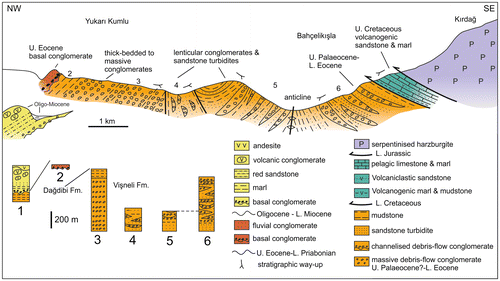
The upper part of the Palaeogene clastic succession (~Vişneli Formation ~700 m) is dated as Early Eocene in age based on calcareous nannofossils and benthic foraminifera. The lower part of the succession (~Bahçelikışla Formation; up to 1000 m thick) is undated but may be of Late Palaeocene age (Konak & Hakyemez, Citation2008b). The succession is deformed into a kilometre-scale anticlinorium, with contrasting successions on both limbs, each estimated as >1000 m thick. The sequence on the southern limb (near the structural axis; Figure ) begins with well-bedded, medium- to thick-bedded sandstone turbidites (in beds <35 cm thick), showing grading, parallel and ripple lamination, sole marks and fine-grained interbeds. The bases of individual beds are commonly pebbly. Upwards, conglomerate lenses become thicker (up to 35 m individually) and more laterally persistent (up to several hundred metres). Clasts are randomly orientated, mostly composed of pelagic limestone with Late Cretaceous planktic foraminifera (e.g. Globotruncana sp.), shelly limestone (with large foraminifera) and also basalt. The succession passes upwards into lenticular conglomerates with purple mudstones (~40 m thick) (near Bahçelikışla village; Figure ). Higher in the sequence (S of Bahçelikışla village) additional lenticular conglomerates contain well-rounded clasts (<45 cm in size). The clast lithologies are ~90% basalt/andesite, 5% calc-schist and schist, 3% marble (foliated) and ~2% pelagic limestone (with Globotruncana sp.). Additional conglomerates and amalgamated coarse sandstone lenses (reddish) dominate the uppermost levels of the succession (~450 m thick). Finer-grained intercalations are mostly reddish brown siltstones/shales (in units <10–15 m thick). The northern limb of the anticlinorium (Figure ) begins with lenticular debris-flow-type conglomerates, individually up to 30 m thick (Figure (j)). Clasts within individual debris flows (<.9 m in size) are mainly basaltic, including some feldspar-phyric lava. Northwards, a fault-bounded succession is dominated by lenticular, channellised conglomerates, in units up to 10 m thick. After a further fault, the succession continues with a thick sequence (several hundred metres) of very coarse, amalgamated conglomerates, medium- to thick-bedded sandstones and mudstones, ending upwards with grey marl. Clasts within nearly massive conglomerate reach 1 m in size. During this work, a probable Eocene age was indicated for the highest levels of the succession in the north based on the calcareous nannofossils Ellipsolithus macellus (Bramlette and Sullivan) and Coccolithus pelagicus (Wallish) (A. Yıldız, personal communication, 2012).
The Palaeocene?–Lower Eocene succession is interpreted as mainly high-energy gravity flows that prograded southwards into an elongate basin, in which hemipelagic muds accumulated. The clastic material was mainly derived from basaltic to andesitic volcanics and pelagic carbonates (Figure ( k)). This material was eroded from the volcanic arc (Olur arc; see below), which was active along this part of the Eurasian continental margin during the Upper Cretaceous. The likely setting was a flexurally controlled foredeep that formed and infilled bordering the Eurasian margin during and soon after the final stages of emplacement of the oceanic rocks.
8.3. Eocene para-autochthonous successions
In the Erzincan area, the volcanic-sedimentary and the ophiolitic melange are, in places, unconformably overlain by a shallow-marine, mixed siliciclastic-carbonate succession, including nummulitic limestones and conglomerates (Sipikör Formation; up to 500 m thick). These sediments contain sediments from both the suture zone rocks (e.g. ophiolitic detritus) and from the Eurasian continental margin (e.g. metamorphic detritus). The succession is well dated as Late Palaeocene–Eocene (Okay & Şahintürk, Citation1997a; Rice et al., Citation2009). Locally, the contact with the underlying Sütpınar Formation appears to be conformable (Rice et al., Citation2009) and can be interpreted as a parallel unconformity. The Sipikör Formation lacks the N-vergent deformation seen in the underlying units of the suture zone and is terminated upwards by an N-dipping thrust (Rice et al., Citation2009). These sediments are broadly contemporaneous with the Late Paaleocene?–Early Eocene coarse clastic sediments beneath the ophiolite in the Kırdağ area (see above). The Late Palaeocene? – Early Eocene sediments overlying the ophiolites and melange can be interpreted as the infill of a thrust-top (piggyback basin) that existed during the final stages of emplacement of the oceanic rocks onto the Eurasian margin.
There are several examples of similar Eocene successions, which are less well-dated. For example, in the Refahiye area (Figure ), serpentinised peridotite is mapped as being depositionally overlain by Eocene volcanogenic rocks (MTA, Citation2002). We observed well-bedded graded sandstones (gravity flows) and dark shales, locally passing upwards into andesitic breccia, conglomerate and andesitic flows. In the north, the succession is overthrust by ophiolitic rocks.
Elsewhere, to the north of Erzincan (Figure ), the lower part of the Eocene succession (e.g. near Ağılözü; Figures and (c)) comprises medium- to thick-bedded sandstones and lenticular conglomerates. A typical lenticular (channellised) unit (~5 m thick) contains poorly sorted, rounded to subrounded clasts (<.4 m in size), mostly volcanics, serpentinite, peridotite and sheared serpentinite. The lower part of the Eocene succession is again exposed further east (near Yeniyol; Figures and (d)), where grey-green mudstones are interbedded with lenticular limestones. Further east again (near Akdağ; Figure ), shales are interbedded with medium- to thick-bedded sandstones. Lenticular, matrix-supported conglomerates (individually up to 6 m thick × 15 cm long) are dominated by limestone clasts (up to .4 m in size), set in a muddy and sandy matrix. Medium-bedded sandstones are, in places, normally graded and exhibit bottom structures (e.g. flute casts), while thick-bedded sandstones are typically lenticular. In places, there is evidence of slump folding. Some of the sandstones are strongly bioturbated or rich in plant material. These clastic sediments were mostly derived from the underlying volcanic-sedimentary melange and the ophiolitic rocks based on petrographic evidence and were largely deposited by gravity processes. Cleavage-bedding relations and observed folds show that the Eocene succession in this area is strongly folded about ~E–W axes. A similar Eocene marine succession overlies the contact between the ordered ophiolite and the volcanic-sedimentary melange elsewhere in the Erzincan area (Figure ).
Further north in the Erzincan area, the Eocene marine sedimentary rocks overlie the deformed Eurasian margin, reaching as far north as the southern margin of metamorphic Pulur Massif (Figure ). Towards the Pulur Massif, the Eocene succession is virtually undeformed but warped into an open synform. The Eocene facies in this area are mainly thin- to medium-bedded sandstone, mudstone and marls (Figure (n)). The sediments are typically finer grained and more argillaceous than those transgressing the suture zone further south. These clastic sediments could be turbidites or storm deposits (Figure (i)). Near the Pulur Massif there is an increased abundance of metamorphic detritus material.
The field relations suggest that at least some of these Eocene sediments are effectively autochthonous with respect to the suture zone rocks and the adjacent Eurasian margin, for example, the succession south of the Pulur Massif. These sediments are inferred to record the latest stages of infilling of a flexural foreland basin that existed during and soon after the final stages of northward-directed thrusting of the suture zone rocks over the Eurasian margin.
8.4. Mid-Eocene non-marine to deep-marine sedimentary and volcanic rocks
A drastic change in tectonic setting occurred very soon after the final emplacement of the allochthonous units onto the Eurasian margin. To the north of the suture zone, for example, in the Olur area in the east (Figures and ), the Palaeocene succession of the Eurasian margin was folded (Figure (l)) and then unconformably overlain by a sedimentary and volcanic succession, which has been dated as late Early Eocene (Ypresian) at the base (lowest 20 m only) and Mid-Eocene (Lutetian) in age (Bozkuş, Citationl992a; Hakyemez & Konak, Citationl996; Yılmaz, Citationl995). The succession lacks any evidence of emplacement-related thrusting and folding as seen in the underlying and adjacent units. The succession begins with varied, metre-scale alternations of non-marine grey and reddish marl, limestone, caliche-bearing mudrocks, red siltstone, orange sandstone and gypsum (Figure ). The sandstone is fine- to medium-grained, parallel laminated, up to thick bedded, grey and dominated by reworked volcanic grains. These sediments are transgressed by shallow-marine mudstones, marl with Nummulites sp. and further marl. A prominent interval of very fresh olivine- and plagioclase-phyric basalt follows in the form of pillow lava and columnar-jointed massive lava. The succession continues with deeper-marine marls, sandstones and mudstones, up to ~80 m thick (e.g. near Bozdoğan; Figure ). Individual sandstone depositional units, up to 5 m thick (Figure (m)), grade upwards into siltstone, mudstone and thin-bedded fine sandstone, with siltstone alternations and white marl interbeds (up to 2.5 m thick). The sandstones are rich in volcaniclastic debris, including basalt, volcanic glass and tephra. Thin sections reveal plagioclase, aphyric basalt, clinopyroxene-phyric basalt and plagioclase-phyric basalt, fresh basic volcanic glass (tephra), devitrified glass (basic), clinopyroxene, hornblende, biotite, opaque minerals and planktic foraminifera (see Figure (j) and (l)). The marl interbeds were found to contain calcareous nannofossils of Middle–Late Eocene age (A. Yıldız, personal communication, 2012). The succession passes upwards into marl with volcaniclastic sandstone interbeds (<30 cm thick), reddish marl, feldspar-phyric lavas and finally pink and white marl rich in planktic foraminifera. In the Olur area (Figure ), the Eocene succession is mapped as being unconformably overlain by Oligo–Miocene non-marine clastics and basic volcanics (Bozkuş, Citationl992b). A comparable Eocene succession is exposed near the Black Sea coast (e.g. Hopa and E of Borçka areas; Figure (b)), where it dips beneath the Black Sea (Hakyemez & Konak, Citationl996).
Figure 33. Simplified geological map of a key area of the Eurasian margin to the north of the suture zone, NW of Olur. Left: outline map showing lines of sections; Right: upper, Summary measured log (composite of logs a and b on the map; this study); Right lower, cross-section (marked A–A′ on the map). (U. Eo Upper Eocene; M. Eo. Middle Eocene). An Upper Cretaceous marine, mixed carbonate/volcanogenic succession passes into Upper Palaeocene shallow-water mixed carbonates and clastics. This sequence was transgressed by Middle-Upper Eocene non-marine, shallow-marine and then deeper-marine (marls) sediments. The shelf carbonates are intercalated with basaltic extrusions (see Figure ; compiled from Konak & Hakyemez, Citation2008a and this study; see also Bozkuş, Citationl992a, Citation1992b).
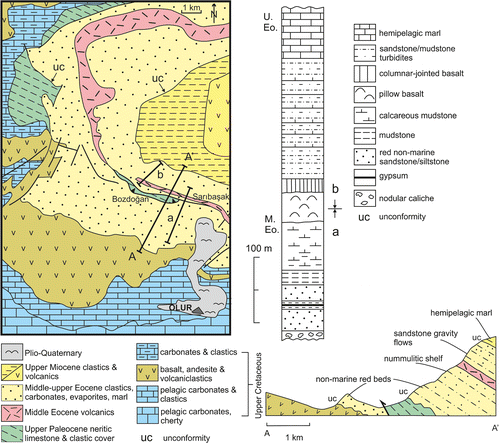
The transgressive setting including basaltic volcanism, terrigenous gravity flows and hemipelagic carbonates is interpreted as the result of drastic rift-related subsidence soon after the final northward emplacement of allochthonous rocks over the Eurasian margin.
8.5. Late Middle Eocene–Late Eocene non-marine transgression
In some areas, the suture zone is overlain by transgressive non-marine, to shallow-marine clastic sedimentary rocks and volcanic rocks, which postdate northward-directed thrusting in the region.
In the Kırdağ area (Figure ), the Upper Palaeocene?–Lower Eocene sequence of coarse gravity-flow deposits (see above) is unconformably overlain by a contrasting, mostly non-marine succession up to 300 m thick, of inferred Late Middle Eocene (Bartonian) to Late Eocene age (Dağdibi Formation of Konak & Hakyemez, Citation2008b; Figures (k) and ; left-hand side). We observed a thin (<2 m) basal conglomerate (<2 m thick) containing a wide variety of well-rounded ophiolite-related clasts (<4 cm in size), notably basalt, gabbro and red chert (jasper), together with metamorphic and igneous rocks derived from the Eurasian margin. The succession passes upwards into well-bedded, medium-grained, well-sorted red fluvial sandstones and conglomerates (~30 m thick). In a nearby succession (1 km to the east; Figure -offset section), a basal conglomerate is absent and red fluvial sandstones pass upwards through volcanogenic conglomerates and into Upper Eocene volcanic rocks (Karataş Formation) that cover a wide area. Laterally equivalent facies include shallow-marine sandstones (up to 300 m thick) containing large foraminifera (Konak & Hakyemez, Citation2008b).
The transgressive non-marine sediments and equivalents elsewhere in the region accumulated after final suturing of the Tethyan ocean in the region. The clastic detritus was derived widely from the oceanic rocks and from the Eurasian margin.
9. Younger cover: Oligocene to Recent
The younger cover is relevant here because it encodes information on the later-stage deformation history of the suture zone and the Eurasian crust to the north. Any such deformation needs to be back-stripped to understand the overall tectonic development of the region.
Widespread typically reddish, non-marine clastic sediments are commonly mapped as Oligocene in age but remain poorly dated (Figure ). The clastic sediments infill depressions and commonly pass upwards into better-dated shallow-marine carbonates of Early–Mid Miocene age and then into evaporitic sediments (Late Miocene?). In addition, shallow-marine Lower Miocene sediments directly transgress the suture zone rocks in some areas.
Palaeontological dating during this study confirmed the presence of Miocene shallow-marine carbonates (rich in large foraminifera) to the northeast of Erzincan (Figure (B) (p)), east of Erzincan (Figure (B) (n)) and in the Şahvelet area (near Aras Nehri; Figure (B) (o)). For example, NE of Erzincan (Figure ) the succession begins with gently dipping, little deformed, coarse red clastic sediments (~10 m), passing upwards into pale brown coloured marl (~80 m) and then into well-bedded bioclastic limestones (~50 m), extending to the top of Kapılıdağ (see Figure ). West of Refahiye (Figure ) the Lower Miocene succession is characterised by thick-bedded marls with calcareous algae (e.g. oncolites), interbedded with poorly consolidated conglomerates, in beds up to 3 m thick (i.e. debris-flow deposits), with clasts including limestone and serpentinite.
In some areas, the Oligo–Miocene succession is strongly folded and/or overthrust by different units of the suture zone, as seen in the Refahiye area (Figures (o) and ) and south of Erzincan (Figure ). The polarity of thrusting is southwards in some areas (e.g. S of Erzincan), as seen, for example, affecting the Late Palaeocene–Eocene succession (Sipikör Formation) in the Erzincan area (Rice et al., Citation2006, Citation2009). However, northward vergence is also observed in some areas (e.g. N margin of Kırdağ Ophiolite; Figure ).
Figure 34. Relationship of the Munzur carbonate platform (part of the Taurides) to the suture zone in the southwest of the area studied. For the line of the main cross-section see Figure . The small cross-section (above, center) shows an outcrop on strike to the E where basalt and cherty pelagic limestone are also exposed. The Karadağ Massif is interpreted as part of the Eurasian continental margin, which was imbricated with volcanic-sedimentary melange during collision-related out-of-sequence thrusting.
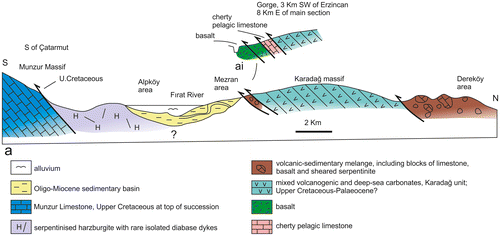
Voluminous lava flows and pyroclastic deposits of Late Miocene–Pliocene age cover many parts of the suture zone and the adjacent areas (e.g. Aktimur et al., Citation1990; Figure ). Plio–Quaternary non-marine sediments (and related volcanics) largely relate to right-lateral movement along the North Anatolian Transform Fault Zone (e.g. Konak et al., Citation2001). Examples include the regional-scale Erzincan pull-apart basin (Figures and ) and smaller strike-slip controlled depocentres (e.g. NW of Erzincan; Figures (c) and ). The right-lateral strike-slip needs to be taken into account when restoring the suture zone, for example, the outcrops of the Refahiye Ophiolite and related units that are exposed to the south of the North Anatolian Transform Fault need to be restored ~ 85 km; that is, to the eastern end of the outcrop of the Refahiye Ophiolite and related units which lie to the north of the fault zone.
Figure 35. Influence of Plio–Quaternary strike-slip related to the North Anatolian Transform Fault, as seen along the NE margin of the ophiolite in the Erzincan area. Ophiolitic peridotite is juxtaposed with the volcanic-sedimentary and ophiolitic melange by a strike-slip fault. Another strike-slip fault separates the melange from the Eurasian carbonate platform to the north. The Oligocene–Miocene cover of both the ophiolite and the melange was folded (Late Miocene?) prior to Plio–Quaternary fault displacement.
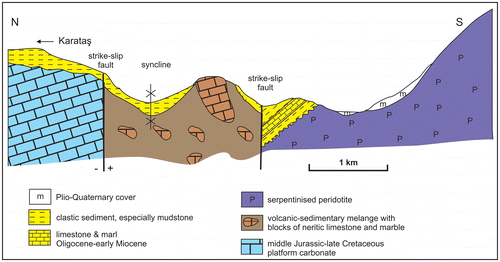
10. Regional comparisons
Useful comparisons can be made with the lateral extension of the suture zone and the Eurasian continental margin both westwards into the Central Pontides and Eastwards into the Lesser Caucasus.
10.1. Central Pontides
The large-scale structure of the suture zone in relation to the Eurasian continental margin is shown in Figure (a) (see Figure for line of section).
Figure 36. Tectono-stratigraphic comparison. (a) Central Pontides (see Figure for line of section). One important unit, the Upper Cretaceous arc apron/forearc basin sediments (Yapraklı Formation) is exposed ~20 km west of the section, while the largest ophiolite outcrop (type Kızılırmak ophiolite) is exposed 50 km northeast of the line of section; (b) Eastern Pontides (see Figure for line of section). This section is representative of the western part of the Eastern Pontide region (around Erzincan), where the oceanic units dip below Eurasian continental margin units. In contrast, the structure of more easterly areas of the Eastern Pontide was strongly influenced by post-collisional northward thrusting. (a–b) Modified after Rice et al. (Citation2006) (c) Lesser Caucasus. ci, well-documented example of imbricate thrust belt within the western exposure of the Sevan–Akera suture zone (simplified from Hässig et al., Citation2013); cii, isolated klippen of oceanic rocks ~50 km SW of the main Sevan–Akera suture zone; thrust over the northernmost outcrop of the South Armenian crustal unit (simplified from Sosson et al., Citation2010). See text for discussion.
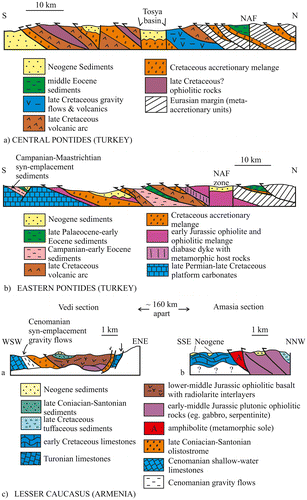
The suture zone is dominated by a northward-dipping stack of thrust sheets. In the south, the suture zone is concealed beneath Cenozoic basinal sediments (Çankırı Basin). The exposed thrust stack begins with (poorly dated) Mesozoic accretionary melange (Kirazbaşı melange). This is followed by a thrust slice of basaltic rocks and related volcanogenic sediments, with subduction-related volcanic arc affinities (Yaylaçayı Formation), as shown by Rice et al. (Citation2006). A Late Cretaceous age is shown by the presence of Globotruncana sp. within interbedded hemipelagic marls. The arc-type rocks are unconformably overlain by an Upper Cretaceous succession of largely redeposited, mixed volcanogenic-neritic/pelagic carbonate sediments without terrigenous detritus. This sequence (Yapraklı Formation) is interpreted as a pre-collisional forearc basin (Rice et al., Citation2006). A slice of ophiolitic rocks (undated) follows, then a further slice of the volcanic arc basaltic rocks and related volcanogenic (non-terrigenous) sediments, also of Late Cretaceous age (Tüysüz, Dellaloǧlu, & Terzioǧlu, Citation1995). To the north of a neotectonic basin (Tosya Basin), a thick succession of Upper Cretaceous gravity-flow deposits (İkiçam Formation) includes abundant volcanogenic and terrigenous-derived detritus, interbedded with within-plate-type basalt. Structurally above come additional slices of arc-related basaltic rocks cut by the North Anatolian Transform Fault and also slices of low-grade metamorphic rocks of inferred accretionary origin (i.e. metamorphosed subduction complex), which are correlated with the Eurasian continental margin. Further east (~40 km), to the north of the North Anatolian Transform Fault, the Eurasian margin rocks are structurally underlain by ophiolitic rocks of geochemically supra-subduction zone (SSZ) type (Kızılırmak Ophiolite; Rice et al., Citation2006) and by further unmetamorphosed accretionary melange. All of the units of a complete ophiolite stratigraphy are present although disrupted by faulting and thrusting. The ophiolitic extrusives are reported locally to contain Upper Cretaceous planktic foraminifera (Tüysüz, Citationl990, although this requires confirmation). The accretionary melange as a whole includes Cretaceous (Albian–Maastrichtian) pelagic limestones and exotic blocks of MORB to WPB chemical composition (Rice et al., Citation2006).
Further north, Eurasian metamorphic basement rocks (Kargı Complex; Tüysüz, Yiğitbaş, & Serdar, Citation1988; Ustaömer & Robertson, Citationl997) are unconformably covered by a well-dated Upper Cretaceous (Campanian; Tüysüz et al., Citation1988) succession of mixed terrigenous clastic and neritic-pelagic carbonate rocks (Eskiköy Formation; Rice et al., Citation2006). The continental margin was then covered by accretionary melange derived from south (Kirazbaşı melange). In the northwest (NW of Tosya), the suture zone exposes ophiolitic rocks that include pillow basalts of geochemically SSZ type. These lavas are associated with Upper Cretaceous Globotruncana-bearing pelagic chalks (Ustaömer & Robertson, Citationl997). The more northerly suture zone exposures are characterised by northward thrusting and imbrication with Eurasian continental margin rocks. Middle Eocene, non-marine to shallow-marine mixed carbonate-terrigenous sediments accumulated transgressively above (Kadıkızı Formation).
There are a number of similarities and differences between the suture zone exposures in the Central Pontides vs. the Eastern Pontides.
Both regions contain mixed terrigenous-volcanogenic successions of Late Cretaceous age (largely gravity flows) that are interpreted as related to backarc rifting and/or arc volcanism along the Eurasian continental margin. This includes the Tortum arc (Olur area) and the Karadağ Massif (Erzincan area) in the Eastern Pontides (see above) and also the Upper Cretaceous sedimentary-volcanic succession in the Central Pontides (İkiçam Formation; north of the Tosya basin; Figure (a)). Rice et al. (Citation2009) interpreted all of the Upper Cretaceous arc-type volcanics and related sediments, exposed at several different levels of the tectono-stratigraphy as dismembered parts of a single continental margin arc. The frontal portion of the arc was inferred to have rifted from the Eurasian margin during the Late Cretaceous, opening an intra-continental backarc basin (Rice et al., Citation2006). More recent work indicates that the Upper Cretaceous volcanogenic-terrigenous succession (İkiçam Formation) passes stratigraphically downwards into Jurassic–Early Cretaceous platform carbonates of the Eurasian margin (MTA, Citation2002; unpublished data). The evidence that the Upper Cretaceous sedimentary-volcanic sequence is underlain by continental crust suggests that the tectonic setting is best interpreted as a backarc rift. The position of this rift along the continental margin effectively isolated the magmatic arc to the south from the input of terrigenous sediments. This rifting also isolated the magmatic arc to the south (Yapraklı Formation) from terrigenous input. In this interpretation, accretionary melange located in the higher levels of the thrust stack was first emplaced onto the Eurasian margin (Late Cretaceous) and then intersliced with Eurasian margin units by large-scale out-of-sequence thrusting (Eocene). This interpretation of an Upper Cretaceous rifted continental margin arc contrasts with an earlier interpretation, in which subduction-related volcanic rocks (i.e. a large thrust sheet south of the Tosya basin) were interpreted as a fragment of an accreted Late Cretaceous oceanic arc (Tüysüz et al., Citation1995).
Both regions include ophiolitic rocks of SSZ chemical affinities, which are distributed through different structural levels of the suture zone. The Central Pontide ophiolites are not radiometrically dated. The ophiolitic extrusives in several outcrops are associated with Late Cretaceous pelagic limestones, which has suggested a Late Cretaceous magmatic age (Tüysüz, Citationl990; Ustaömer & Robertson, Citationl997). However, ophiolitic melange in the Ankara region to the southwest of the Central Pontides is known to include Jurassic plagiogranite (see Çelik et al., Citation2011; Dilek & Thy, Citation2006). It is, therefore, still necessary to carry out radiometric dating of the Central Pontide ophiolites to determine their age with confidence.
In the Eastern Pontides, Upper Cretaceous thrusting over the Tauride-related Munzur platform was clearly southwards. Any comparable southward thrusting in the Central Pontides is concealed beneath the Cenozoic Çankırı Basin. In contrast, northward-vergent folding and thrusting dominates in more northerly units in both the Central Pontides (Rice et al., Citation2006) and the Eastern Pontides (Rice et al., Citation2006, Citation2009; this study). The northward thrusting in the Eastern Pontides appears to be partially of Late Cretaceous age because, in contrast to older units in the region, the Palaeocene–Eocene transgressive forearc basin sediments (Sipikör Formation) lack evidence of any north-vergent deformation (e.g. in the Erzincan area; Rice et al., Citation2006). Specifically, northward vergence is documented in the volcanic-sedimentary melange, in dismembered ophiolites and in Upper Cretaceous Eurasian margin-related sediments (İkiçam Formation). In addition, Eocene sediments in some areas (e.g. Kırdağ area) also show north-vergent deformation (see Figure ). The evidence of pre-Palaeocene–Eocene northwards vergence in both the eastern and western Pontides has been taken as evidence of initial emplacement of oceanic-derived rocks over the Eurasian margin during latest Cretaceous time (Rice et al., Citation2006, Citation2009). Further northward-directed deformation took place during the Eocene, in both the Central and Eastern Pontides.
Both regions expose volcanic-sedimentary melange at various structural levels that is interpreted as of subduction-accretion origin. The Eastern Pontides includes accretionary melange of both Jurassic age (i.e. metamorphosed melange; Topuz et al., 2012) and Cretaceous age (i.e. unmetamorphosed; Rice et al., Citation2006, Citation2009; this study).
The most important implications of the Central Pontides for a reconstruction of the Eastern Pontide suture zone are: first, northwards emplacement of accretionary melange onto the Eurasian margin took place during the Late Cretaceous in both regions accompanied by north-vergent deformation, and secondly, crustal-scale imbrication of the suture zone units and Eurasian continental margin units took place during Early–Middle Eocene continental collision.
10.2. Lesser Caucasus
Comparable outcrops also occur within the Lesser Caucasus >200 km to the east of the Eastern Pontide region studied, within the Republics of Armenia and Azerbaijan (Figure ). The summary below draws on extensive work by numerous geologists (see Sosson et al., Citation2010; Yılmaz et al., Citation2000; Zakariadze et al., Citation1990 for bibliography). A simplified cross-section of the area as a whole, together with local cross-sections of two key areas, is shown in Figure (c). In general, the upper levels of the Eurasian continental margin are seen, whereas the deeper crustal levels of the Eurasian margin (e.g. Palaeozoic units) are exposed in the Great Caucasus within the Republic of Georgia to the north.
Within the Republic of Armenia, there are two main separate outcrop areas of Mesozoic oceanic rocks. The first forms part of the laterally persistent Sevan–Akera suture zone, the eastward extension of the İzmir–Ankara–Erzincan–Kars suture zone (Figure ). The exposures are in elongate structural highs separated by Palaeocene–Oligocene sedimentary basins. The second outcrop area is ~70 km further south, where an isolated thrust sheet of ophiolitic rocks (Vedi ophiolite and related rocks) structurally overlies the Devonian–Coniacian sedimentary cover of the South Armenian continental unit.
The Eurasian margin rocks exposed within the Sevan–Akera suture are characterised by two magmatic arc units separated by an unconformity. Upper Palaeozoic ‘basement’ rocks there are unconformably overlain by a Mid-Jurassic–Early Cretaceous calc-alkaline magmatic arc sequence, dominated by volcanic and volcaniclastic lithologies (see Hess, Aretz, Gurbanov, Emmermann, & Lippolt, Citationl995). After an unconformity (Early Cretaceous), a second arc sequence includes volcanics and shallow-water carbonates of Late Cretaceous age. The sequence passes upwards into latest Cretaceous (Campanian–Maastrichtian) limestones, followed by a further unconformity, above which comes an Eocene succession of terrigenous clastics and silicic volcanics. A final unconformity intervenes before Pliocene–Quaternary coarse clastic sediments.
The oceanic rocks of the suture zone rocks are well exposed to the north of Sevan Lake and in separate outcrops further west.
North of Sevan Lake, the exposure includes a partially preserved ophiolite (Sevan–Akera ophiolite), which is exposed in both right-way and inverted units. The ophiolite begins with serpentinised ultramafic rocks and passes upwards, in some sections, into gabbros, diorites and quartz diorites and then into basaltic pillow lavas and radiolarites. A Jurassic age of the plutonic ophiolitic rocks of the NE Sevan ophiolite has long been known based on radiometric dating (Zakariadze et al., Citation1990). Small bodies of plagiogranite occur locally, but a sheeted dyke complex is not observed. The ophiolitic rocks are covered by a ‘melange’ and with clastic sedimentary rocks of Coniacian–Santonian age. The cover sequence continues upwards into Campanian–Maastrichtian and Palaeocene? limestones, followed by Eocene limestones and volcanics, Oligo–Miocene volcanics and then Plio–Quaternary volcanics and clastic sediments (see Galoyan, Rolland, Sosson, Corsini, & Melkonyan, Citation2009; Galoyan et al., Citation2009; Sosson et al., Citation2010; Zakariadze et al., Citation1990 for data summaries).
Exposures ~100 km further west (near Amasia) reveal an organised thrust stack (Hässig et al., Citation2013). From the structural top downwards, this comprises thrust-imbricated plutonic rocks (serpentinite; gabbro), greenschist facies ophiolitic melange (including pillow basalt and radiolarian chert) and then garnet amphibolite. Amphiboles from the ophiolitic gabbros yielded a Mid-Jurassic age based on Ar40–Ar39 dating. The underlying amphibolite is interpreted as part of the metamorphic sole of the overriding ophiolite (Hässig et al., Citation2013). In another separate exposure, ~40 km to the east (near Stepanovan), metamorphic rocks are exposed in the core of a domal uplift. Blueschists there, experienced initial HP/LT metamorphism around 94–90 Ma (Turonian), followed by lower pressure exhumation-related metamorphism around 71–74 Ma (Maastrichtian) (Rolland, Billo, et al., Citation2009; Rolland et al., Citation2010). The blueschists are overthrust by ophiolitic rocks including basaltic volcanics that have been dated as Mid-Late Jurassic using interbedded radiolarians (see Danelian et al., Citation2010 for review of data). The ophiolitic extrusive rocks show a weak subduction chemical influence, which is attributed to formation in an intra-oceanic backarc marginal basin. The blueschists and SSZ ophiolitic rocks were tectonically juxtaposed by Late Cretaceous intra-oceanic thrusting (Rolland, Billo, et al., Citation2009; Rolland et al., Citation2010).
In the second main outcrop area, ~50 km SW of the main Sevan-Akera suture zone, the Vedi ophiolitic zone is underlain by Cenomanian reef limestones passing upwards into Cenomanian-aged, mostly fine-grained gravity flows. These sediments pass upwards into sedimentary melange (‘olistostrome’) of Upper Coniacian–Santonian age, which is highly sheared near the overriding Vedi ophiolite. The lower levels of the ophiolite pseudostratigraphy are represented by dismembered gabbro and by various serpentinised ophiolitic rocks. The ophiolitic extrusives, which are more intact, are chemically of MORB type (Rolland et al., Citation2010; Sosson et al., Citation2010) and are interstratified with radiolarites of Middle Bathonian-Callovian age (see Danelian et al., Citation2010). The MOR-type pillow basalts are overlain by alkaline basalts, which are interpreted as ocean-island or oceanic plateau-type extrusives (i.e. plume-type magmatism). Both the ophiolitic and the alkaline rocks are covered by mixed carbonate-clastic gravity flows of Late Coniacian–Santonian age. Palaeocene transgressive lithologies occur above this. The Vedi ophiolite was emplaced southwards over the collapsed northern continental margin of the Sevan–Akera continental block during Late Coniacian–Early Santonian time, accompanied by the emplacement of large-scale subaqueous debris flows (olistostrome).
In recent work all of the ophiolitic rocks in the different outcrops are correlated as remnants of single oceanic slab of Mid–Late Jurassic age. Radiolarian sediments depositionally overlie a range of ophiolitic rocks, including serpentinised peridotite (e.g. lherzolite; gabbro), suggesting that the oceanic crust experienced strong extensional faulting, typical of modern slow-spread oceanic crust. Overlying calc-alkaline lavas (Turonian–Early Coniacian) are attributed to a further phase of intra-oceanic subduction (Rolland et al., Citation2010). There are two different interpretations of when northward subduction beneath the Eurasian margin ended. In the first interpretation, subduction ended around 73–71 Ma (Maastrichtian) marked by cessation of arc magmatism, uplift and non-deposition (Rolland, Billo, et al., Citation2009, Citation2010). In the second interpretation, subduction did not end until the Palaeocene associated with further uplift, erosion and infill of a frontal flexural basin (Sosson et al., Citation2010).
In a proposed, plate tectonic model (Sosson et al., Citation2010), Tethyan oceanic crust (~northern Neotethys) subducted northwards beneath the Eurasian margin, at least during Mid-Jurassic to Early Cretaceous time, and also during Late Cretaceous (Santonian) time. The oceanic rocks docked with the Eurasian margin before the Late Middle Eocene when transgressive shallow-marine limestones and terrigenous clastic sediments first appear. Further south within Tethys, northwards subduction was initiated giving rise to a backarc? marginal basin of Mid-Late Jurassic age. Plume-type magmatism followed. Oceanic crust continued to subduct until the SSZ slab (i.e. marginal basin crust) collided with the Gondwana-derived South Armenian continent. Any remaining crust continued to subduct until initial continental collision, either during latest Cretaceous or Palaeocene time in different scenarios (Rolland et al., Citation2010; Sosson et al., Citation2010).
There are several similarities with and differences between the East Pontide region, as reported here:
Jurassic ophiolitic rocks are present in both regions, but there are differences. (1) The East Pontide ophiolitic extrusives (e.g. IATs of the Karadağ ophiolite) show a strong subduction chemical influence (Parlak et al., Citation2013), whereas the Armenian ophiolites range from mildly subduction influenced to MORB. (2) The Eastern Pontide ophiolites exhibit a complete ophiolite pseudostratigrapy including sheeted dykes, whereas the Armenian ophiolites exhibit a rifted stratigraphy suggestive of slow seafloor spreading. (3) The known Eastern Pontide ophiolite extrusives lack interbedded sediments (consistent with relatively rapid spreading) and do not preserve a contemporaneous (i.e. pre-emplacement) deep-sea sediment cover. (4) The age of the Eastern Pontide ophiolites (~178–186 Ma; Early Jurassic) based on radiometric dating appears to be somewhat older than the Armenian ophiolites, as determined from a combination of radiometric dating (e.g. Vedi ophiolite: ~178 Ma; Sevan ophiolite ~165 Ma; Amasia ophiolite ~169–176 Ma) and radiolarian dating (165–161 Ma). The two regions are likely to share a common tectonic development with different units of the same overall intra-oceanic spreading fabric being preserved in the two regions. For example, the Eastern Pontide ophiolites could have resulted from initial, Early Jurassic intra-oceanic spreading in a forearc setting (preserved in the E Pontides), followed by rifting to form a Mid-Jurassic backarc basin (preserved in Armenia). The ~182–185 Ma intrusive granitic rocks cutting ophiolitic gabbro in the Eastern Pontides (Kırdağ area) could be a remnant of an intra-oceanic arc, which is apparently not preserved in the Lesser Caucasus.
Ophiolitic rocks and accretionary material were emplaced onto both the South Armenian platform (Lesser Caucasus) and the Munzur platform (Eastern Pontides) during the Late Cretaceous. However, the timing differs significantly. The ophiolitic rocks were emplaced onto the collapsed South Armenian platform during Late Cenomanian-Santonian time (~96–84 Ma), significantly earlier than the Campanian–Maastrichtian (83–68 Ma) emplacement of accretionary melange and ophiolites over the Munzur carbonate platform in the Eastern Taurides (see Rice et al., Citation2009). The age difference implies regionally diachronous ophiolite emplacement, either because the ophiolitic slab was closer to the southerly continental margin in the Lesser Caucasus than the Eastern Pontide, and/or the palaeogeography was irregular such that the South Armenian continental crust represents a promontory and the Munzur platform an embayment within one, or several continental blocks (see Robertson, Parlak, & Ustaömer, Citation2013).
Jurassic arc magmatism characterises the Eurasian continental margin in both the Eastern Pontide and the Lesser Caucasus regions. However, this phase of arc magmatism appears to have terminated in the Eastern Pontides by the end of the Middle Jurassic because the magmatic rocks there are transgressed by well-dated Late Jurassic–Early Cretaceous marine carbonates (e.g. Calpionellid limestones) (see Ustaömer & Robertson, Citation2010). Arc magmatism was again active in both regions during the Late Cretaceous (Senonian) but appears to have largely or completely terminated before the Palaeocene. In both regions, the oldest shallow-marine to non-marine regionally transgressive sediments are of Late Middle Eocene (Bartonian) age, indicating that final continental collision was synchronous in both regions.
In summary, the main implications of the evidence from the Lesser Caucasus for an interpretation of the Eastern Pontides are: first, Jurassic intra-oceanic SSZ ophiolite genesis occurred widely; secondly, intra-oceanic subduction remained active in the Late Cretaceous, with blueschist genesis, then exhumation (Turonian vs. Maastrichtian); thirdly, ophiolites were emplaced ~5–10 Ma earlier onto the southern continent in Armenia compared to Eastern Turkey, and fourthly, the Armenian ophiolites were emplaced by thrusting beneath the Eurasian continental margin. Important issues that remain not fully resolved in both regions are the width of ocean remaining after Late Cretaceous southward continental obduction and the timing of initial collision of the Tauride/South Armenia crustal blocks with Eurasia (latest Cretaceous or Palaeocene).
11. Tectonic development of the Eastern Pontide suture zone
The assembled geological information, comparisons and local interpretations are discussed in chronological order below.
The Palaeozoic geological development of the Pontide margin (Sakarya Continent) culminated in regional metamorphism and the emplacement of granitic plutons during the Carboniferous (Dokuz, Citation2011; Dokuz, Karslı, Chen, & Uysal, Citation2010; Okay & Şahintürk, Citationl997a; Ustaömer & Robertson, Citation2010; Ustaömer, Robertson, Ustaömer, Gerdes, & Peytcheva, Citation2013; Topuz et al., Citation2004, Citation2010). The orogen was then exhumed and deeply eroded. This was followed by localised deposition by transgressive shallow-marine deltaic and carbonate rocks, coupled with siliceous magmatism during Late Carboniferous time, as uniquely exposed in the Bayburt Region (near Çatalçesme; Okay & Şahintürk, Citation1997a; Figure ).
11.1. Jurassic: Pontide active margin and SSZ ophiolite genesis
The crystalline basement (Sakarya Continent) was transgressed by Jurassic shallow-water carbonates and intercalated with volcanic rocks (Okay & Şahintürk, Citation1997a; Şen, Citation2007). A subduction influence (e.g. a negative Nb anomaly) is documented from chemical analyses of the Jurassic volcanic rocks and has been interpreted as indicating eruption above a subduction zone (Şen, Citation2007; Ustaömer & Robertson, Citation2010). North-dipping subduction of oceanic crust beneath the Pontide margin during the Jurassic has been inferred (Ustaömer & Robertson, Citation2010), although southward-dipping subduction has also been proposed (e.g. Koçyiğit & Altıner, Citation2002). During Early Jurassic time, the Pontide margin rifted (e.g. Koçyiğit & Altıner, Citation2002; Yılmaz & Kandemir, Citation2006), most obviously in the eastern part of the Eastern Pontides, where a deep-marine basin known as the Irmakyanı basin formed during the Early Jurassic (Ustaömer & Robertson, Citation2010). The Irmakyanı basin was underlain by a sheeted complex, known as the Demirkent Intrusive Complex, which cuts the basement. The rift basin was bordered to the south by a contemporaneous, Jurassic volcanic arc, which is preserved in a north-vergent thrust sheet (Olur thrust sheet of Ustaömer & Robertson, Citation2010). Volcaniclastic material derived from the arc infilled the upper part of the rift basin. Granites were emplaced into the Demirkent Intrusive Complex during Toarcian–Aalenian time (Ustaömer et al., Citation2013). The Irmakyanı basin closed during Late Middle Jurassic (Oxfordian), associated with faulting, folding and uplift (i.e. stratigraphic inversion) of the basin fill. The deformed basin was then unconformably overlain by shelf to slope sediments and volcanics during Late Jurassic–Early Cretaceous (Tithonian–Berriasian) time (Bozkuş, Citationl992a; Tunç, Citationl992).
The East Pontide ophiolites formed in a SSZ setting within the Tethyan ocean (İzmir–Ankara–Erzincan ocean) during the Early Jurassic (~178–186 Ma) based on the radiometric dating of four different outcrop areas, as presented here (Figure ). Comparable Jurassic ages of ophiolite genesis are reported from plagiogranites within an ophiolitic thrust sheet in the Ankara melange further west (Dilek & Thy, Citation2006; Sarıfakıoğlu, Özen, & Winchester, Citation2009). A comparable age of ophiolite genesis is also suggested by the Jurassic age of an amphibolite block in the melange (Çelik et al., Citation2011). In addition, Topuz et al. (2012) have documented an U–Pb rutile age of 172 ± 4 Ma from a micaschist sample within metamelange intercalated with the Refahiye Ophiolite. They interpret this age as the product of Jurassic subduction-accretion, which apparently took place ~6–14 years later than the magmatic genesis of the ophiolitic rocks dated here. As discussed above, the ophiolites associated within the eastward continuation of the suture zone into the Lesser Caucasus are also dated as Jurassic, although they may be a few million years younger (~169 and 175 Ma; compared to those in the Eastern Pontide region (see above).
11.2. Cretaceous: continental margin arc volcanism and subduction/accretion
Northward-dipping subduction is generally inferred along the Eurasian margin during the Cretaceous (Rice et al., Citation2006, Citation2009; Robertson & Dixon, Citationl984; Şengör & Yılmaz, Citation1981; Ustaömer & Robertson, Citation2010; Yılmaz et al., Citation1997).
Specifically, Early Cretaceous northward subduction is inferred in the Central Pontides based on radiometric dating (Okay, Tüysüz, et al., Citation2006) and also in the Lesser Caucasus to the east (see Sosson et al., Citation2010). Several authors have inferred that the ophiolites and the accretionary melange were emplaced northwards onto the Pontide margin during the Cenomanian (Okay & Şahintürk, Citation1997a; Yılmaz et al., Citation1997). This relatively early obduction was inferred because in some areas relatively distal (southerly areas) shallow-water deposition on the Eurasian margin ended during the Aptian or Albian, followed by melange/ophiolite emplacement. However, we have found that in one key area (Otlukbeli; Figure ), the Pontide carbonate succession extends into the Late Cretaceous (Campanian–Maastrichtian), prior to melange emplacement. Older (Early Cretaceous) microfossils in the succession there are reworked. In addition, no evidence of Cenomanian ophiolite/melange emplacement has been identified in the Erzincan area, where the stratigraphy of the Eurasian margin-related successions (i.e. Sütpınar Formation) continues into the Eocene (Rice et al., Citation2006, Citation2009).
A regional comparison suggests that pelagic carbonate sedimentation (e.g. globotruncanid wackestones) in the Maden area (Bayburt east) extends from the Tithonian into the Late Cretaceous. This sequence is followed by ‘olistrostromal’ conglomerates, melange, an Upper Cretaceous volcanogenic unit and then by Maastrichtian rudistid limestones (Bergougnan, Citation1975). The emplaced accretionary melange was therefore covered by rudist-bearing shallow-water carbonates, as reported from the Aşkale and Maden areas of Bayburt Region (e.g. Fenerci, Citationl994; Okay & Şahintürk, Citationl997a). Elsewhere, in the Berdiga Mountains, the carbonate platform sequence ends in the Aptian–Albian(?) (Pelin, Citation1981) and is unconformably overlain by Turonian sandy limestone. The Turonian platform drowning and breakup was followed by deposition of Campanian red pelagic limestone. Volcanogenic and turbiditic sediments accumulated during the Campanian–Maastrichtian without oceanic-derived material. In addition, sedimentation continued in some more proximal (northerly) areas of the Eurasian margin into Palaeocene time (e.g. Olur area in the NE; Figure ; see below).
The field relations show that accretionary melange was emplaced northwards onto at least some parts of the southerly edge of the Eurasian margin during the Late Cretaceous (Campanian–Maastrichtian Figure ), followed by shallow-water carbonate deposition during the Maastrichtian. The melange includes small amounts of ophiolitic rocks, especially serpentinite, but there is no evidence from the Eastern Pontides, the Central Pontides or the Lesser Caucasus (see Figure ) that major ophiolite thrust sheets were emplaced onto the Eurasian margin during the Late Cretaceous.
Figure 37. Emplacement of accretionary melange over the collapsed southern margin of Eurasia represented by the Pontide carbonate platform (near Otlukbeli, SW of Bayburt; see Figure for location). The uppermost levels of the platform comprise pelagic and redeposited carbonates that were are dated as Campanian–Maastrichtian during this study (see Figure ). The platform succession terminates with siltstone/fine-grained sandstone turbidites with reworked Early Cretaceous benthic foraminifera. Folds in the carbonate platform indicate top-N displacement. The lowest levels of the melange contain blocks of lithologies that are similar to those exposed in the highest levels of the platform (i.e. Campanian–Maastrichtian-aged pelagic and silty redeposited carbonates).
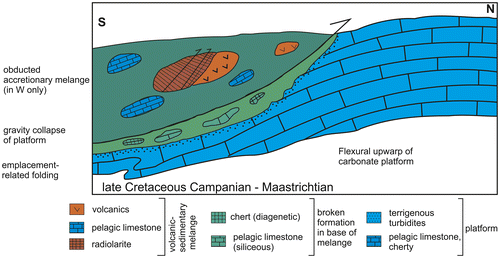
Upper Cretaceous arc magmatism is documented throughout the Eastern Pontides (e.g. E Pontide magmatic arc; e.g. Şengör & Yılmaz, Citation1981; Yılmaz et al., Citation1997) and in the Lesser Caucasus (Sosson et al., Citation2010). In the study area, shallow-water shelf to more distal slope deposition (Figure ) was followed by widespread Upper Cretaceous subduction-related volcanism, as seen in the Tortum area (Konak et al., Citation2001; Okay & Şahintürk; Citationl997a; Ustaömer & Robertson, Citation2010).
Dismembered Cretaceous sequences within the suture zone (e.g. Şahvelet and Karadağ areas; Figure ) can be correlated in terms of age and lithology with the intact Pontide margin successions further north. Taken together, both the relatively autochthonous Eurasian margin sequences and comparable allochthonous units within the suture zone restore as proximal to distal parts of the south-facing continental margin slope. Mixed terrigenous and arc-derived volcaniclastic sediments were redeposited downslope along the edge of the continental margin. Given that contemporaneous subduction was taking place beneath the Eurasian margin the Upper Cretaceous sediments accumulated in a large forearc basin.
The volcanic-sedimentary melange is interpreted as a Cretaceous subduction-accretion complex related to northward subduction. The age of the accreted volcanics and associated deep-sea sediments, as documented here, ranges from Early Jurassic to Late Cretaceous. The sedimentary matrix of the melange is dated as partially Late Cretaceous. Some of the Cretaceous deposits within the melange (e.g. in the Horasan area) are interpreted as small perched basins that later collapsed and were incorporated into the melange (Figure (c)).
The melange contains exotic blocks of chemically, within-plate type basalts (E-MORB/OIB) of both Early Jurassic and Late Cretaceous age. These blocks are inferred to represent parts of oceanic seamounts that were detached and entrained within the melange. In contrast, the blocks and dismembered thrust sheets of Early Jurassic subduction-influenced volcanics (IAT) are interpreted to have detached from the overriding Early Jurassic forearc ophiolitic slab. The deep-sea sediments (e.g. radiolarites; Figure ) thus represent the uppermost parts of the ophiolite sequence, which are otherwise not preserved. The alternative that IAT fragments were derived from a different oceanic magmatic arc is unlikely. Accretionary melange can thus contain exotic material derived from both the downgoing oceanic slab and from the overriding oceanic plate. A similar dual origin of oceanic blocks has been proposed for accretionary melange in central and western Anatolia (Robertson, Parlak, & Ustaömer, Citation2009).
During the Cretaceous, the Early Jurassic ophiolites formed a relatively rigid backstop within the ocean some distance from the Eurasian margin. Fragments of ophiolitic crust were incorporated into the Cretaceous accretionary melange by out-of-sequence thrusting or re-thrusting during subduction and ensuing collision.
Several lines of evidence suggest that during the Cretaceous oceanic crust (of uncertain width) still existed on a regional scale between the Eurasian margin and the Jurassic SSZ-type oceanic crust (i.e. the future emplaced ophiolites). (1) The melange matrix (e.g. red mudstones; marls; locally derived debris-flow deposits) represents trench-type sediments accreted in an oceanic setting, similar to present-day SW Pacific subduction zones (e.g. Underwood et al., Citationl995). Pelagic/hemipelagic sediments predominate without the thick terrigenous turbidites that characterise typical continental margin subduction complexes (e.g. Leggett, McKerrow, & Eales, Citationl979). (2) Cretaceous SSZ-type ophiolites are documented from the westward extension of the suture zone into the Central Pontides based on dating of associated deep-sea pelagic carbonates (see above). (3) Upper Cretaceous ophiolites are also recognised overlying the Kırşehir Massif further south, again mainly based on dating of pelagic carbonates associated with ophiolitic volcanic rocks (Floyd et al., Citation2000). (4) The Late Cretaceous age of metamorphic sole rocks of SSZ-type ophiolites in the northwestern Taurides (Tavşanlı area) implies a Cretaceous age of formation (Önen & Hall, Citation2000). These ophiolites originated in an oceanic basin to the north of the Tauride continent. (5) The Jurassic–Cretaceous deep-sea sedimentary cover of the Armenian ophiolites (not preserved in the Eastern Pontides) lacks input of terrigenous sediments (e.g. Danelian et al., Citation2010; see above).
11.3. Latest Cretaceous emplacement of oceanic units
Accretionary melange and ophiolites were emplaced southwards over the Munzur Massif (Tauride margin) during latest Cretaceous time. In addition, accretionary melange was emplaced northwards onto the Pontide margin, at least locally, during latest Cretaceous time, related to closure of an intervening ocean basin.
In the west, accretionary melange and large ophiolite slices were emplaced southwards over the Tauride continental margin represented by the Munzur Massif during latest Cretaceous time, preceded by subsidence to form a foredeep (Ayıkayası Formation) (Aktimur, Atalay, Ateş, Tekirli, & Yurdakul, Citation1988; Özer, Koç, & Özsayar, Citation2004; Özgül, Citationl981; Özgül & Turşucu, Citationl984; Rice et al., Citation2006, Citation2009). The Munzur platform may be interpreted as a local a promontory of the Tauride continent, while areas further east (i.e. easternmost Pontides) filled with accretionary material (i.e. the East Anatolian accretionary complex; Görür, Oktay, Seymen, & Şengör, Citationl998; Robertson, Parlak, Metin, et al., Citation2013; Robertson, Parlak, & Ustaömer, Citation2013; Şengör & Yılmaz, Citation1981).
The initial stages of emplacement affecting the Eurasian active margin are exemplified in both relatively southerly and more northerly units. First, the Late Cretaceous forearc basin successions (Maastrichtian and older) within the suture zone (e.g. in the Horasan area) collapsed to form sedimentary melange (i.e. large-scale debris flows) during the Maastrichtian. Secondly, accretionary melange, including basalt associated with Early Tithonian radiolarian chert, was emplaced northwards over the Pontide margin, as seen in the Otlukbeli area, no earlier than Campanian–Maastrichtian time, as dated by planktic foraminifera in the directly underlying Eurasian carbonate platform succession (Figure ). Further, north oceanic material is absent, and the succession continues into the Palaeocene (e.g. Olur area; Figure ). The latest Cretaceous and Late Palaeocene successions exposed there are separated by an unconformity (Konak et al., Citation2001), which is likely to reflect long-wavelength tilting (i.e. flexural loading) of the distal Eurasian margin related to accretionary melange emplacement further south.
11.4. Palaeocene: remnant oceanic basin or developing collision
The pre-Palaeocene–Lower Eocene successions of the Eastern and Central Pontides show evidence of north-verging deformation, which is absent from the overlying younger Eocene sequence in the same areas (Rice et al., Citation2006, Citation2009; see above). This evidence can be explained in two ways. First, the Cretaceous accretionary prism overfilled the trench and melange, and some oceanic crust (e.g. serpentinite) was then pushed over the backstop, explaining the north-vergent deformation. However, oceanic crust still remained during the Palaeocene. Support for this option comes from the evidence that definite continental collision was delayed until the Early–Mid-Eocene, >10 Ma later than the initial latest Cretaceous melange emplacement onto the Eurasian margin. Assuming a minimum 10 cm/year convergence rate >100 km of crustal shortening must have taken place between the latest Cretaceous initial obduction and the Mid-Eocene final collision, which is easily explained if subductable oceanic crust still remained. Minor subduction-influenced volcanism, represented by local plagioleucitites, may have continued into the Palaeocene (Altherr et al., Citation2008) although the exact age and significance of these volcanics is questionable. Secondly, the melange emplacement reflects the initial stages of continental collision, as suggested for both the Central Pontides by Rice et al. (Citation2006) and by some authors for the Lesser Caucasus (Rolland et al., Citation2010). This option is supported by the relative absence of arc magmatism along the Eurasian margin during the Palaeocene and the absence of preserved Palaeocene accretionary material. On balance, it seems likely that some oceanic crust remained during the Palaeocene. This was possibly a time of subduction erosion along the Eurasian margin explaining the absence of Palaeocene accretionary material.
11.5. Late Palaeocene – Early Eocene: uplift, collision and N-vergent thrusting
On a regional scale, the ophiolites and the associated accretionary melange are observed to underthrust the Eurasian continental margin (see Figure (a–c)). In the west (e.g. northeast of Erzincan; Figure ), volcanic-sedimentary melange and ophiolitic rocks are thrust beneath the Eurasian-related carbonate platform, as also seen in the Central Pontides and the Lesser Caucasus. Deposition continued on parts of the Eurasian margin during this time. For example, in the west (N of Erzincan), mixed carbonate-clastic marine sediments shallowed upwards into nummulitic shelf-deposits (Palaeocene-Eocene Sipikör Formation; Rice et al., Citation2009).
An important tectonically controlled marine basin formed adjacent to the Eurasian foreland, at least in the east during Late Palaeocene?–Early Eocene time (e.g. along the north margin of the Kırdağ massif). Mixed carbonate-volcanogenic lithologies of the Eurasian margin to the north were uplifted, eroded and redeposited southwards into a remnant marine basin within the developing suture zone. Turbidites and debris flows (including fan-delta deposits) prograded southwards from the uplifted foreland. The probable driving mechanism was flexural subsidence of the Eurasian margin to form a foredeep, driven by progressive collision with the Tauride continent to the south. Consistent with late-stage northward thrusting, the ophiolite in the Kırdağ area (Figure ) was emplaced northwards over imbricated ophiolitic thrust sheets and Pontide-related sedimentary rocks (Figure ).
Structural and sedimentary evidence from several areas, notably the Erzincan area in the west (Rice et al., Citation2006, Citation2009) and from the northern margin of the Kırdağ massif (this study), shows that the oceanic-derived units were finally emplaced during Palaeocene–Early Eocene time. In places, Eocene marine facies unconformably overlie both the suture zone and the Eurasian margin to the north (e.g. Jurassic–Cretaceous platform; Pulur Massif). These and other comparable Palaeocene–Early Eocene marine deposits (e.g. debris flows and turbidites) represent tectonically active depocentres that developed on top of the allochthonous units during and soon after their final emplacement onto the Eurasian margin (i.e. as late-stage piggy pack basins, transitional to a regional foreland basin).
As the continental collision intensified, the already assembled thrust stack of accreted melange and ophiolites was detached and thrust northwards over the Eurasian margin, as seen in the Kırdağ and Karadağ areas in the east. With further intensification of collision, the entire continental margin of the Eastern Pontides was detached and thrust northwards to its final position as a stack of thrust sheets. Simultaneously, the southern margin of the Tauride continent, including the ophiolites and the underlying Munzur Massif, was detached and thrust southwards as part of a vast stack of thrust sheets (Bedi et al., Citation2009; Özgül, Citationl981; Robertson, Parlak, Metin, et al., Citation2013; Robertson, Parlak, & Ustaömer, Citation2012). Since the previous direction of subduction was northwards, the Eocene northwards emplacement in the Pontides can be interpreted as the result of crustal-scale backthrusting. The Early Eocene was a period of emplacement of adakitic magmatism into the East Pontide crust, which can be explained, either related the formation of a slab window or to lithospheric delamination. Calc-alkaline magmatism followed during Mid-Eocene time (see Keskin, Pearce, Kempton, & Greenwood, Citation2006). The alternative models have different implications for crustal behavior (e.g. regional uplift), as noted below.
11.6. Middle Eocene-Recent: role of extension vs. suture tightening
The final collision in the region is constrained as the time interval between the latest marine sedimentation during the Early Eocene (e.g. north margin of the Kırdağ massif) and the Middle Eocene first accumulation of transgressive sediments. Middle Eocene (Lutetian; ~45 Ma) transgressive clastic sediments, ranging from non-marine to shallow-marine, are reported from many areas of the Eastern Pontides (e.g. Okay & Şahintürk, Citationl997a; Yılmaz et al., Citation1997), the Central Pontides (Rice et al., Citation2006) and the Lesser Caucasus (Sosson et al., Citation2010).
During the Mid-Eocene, immediately following final collision, the foreland to the north rifted and subsided, associated with a marine transgression, basaltic volcanism and then the deposition of gravity flows (mass-flows; turbidites) and hemipelagic marls, as seen in the Olur area (Figure ). This succession can be interpreted as part of the southerly, featheredge of the Eastern Black Sea Basin, which by implication underwent a phase of rifting during this time (Mid-Eocene). Comparable Eocene gravity flows and volcanics are reported for hundreds of kilometres laterally (e.g. from N of the Tokat Massif (Yılmaz et al., Citation1997) to the Lesser Caucasus (Nikishin, Korotaev, Ershov, & Brunet, Citation2003; Sosson et al., Citation2010; Vincent et al., Citation2011 for regional setting)). A possible driving force for the required crustal extension was southwards rollback of the oceanic plate after collision, possibly related to crustal delamination. An alternative, slab break-off model has been proposed for similar Eocene volcanism in more western areas of the Pontides (e.g. the Amasya and Çorum areas) (Keskin, Genç, & Tüysüz, Citation2008). However, slab break-off is widely believed to cause major surface uplift, for example, the uplift of the Central Taurides during Plio-Quaternary time (Schildgen et al., Citation2012). On the other hand, in the Eastern Pontides, the Eocene volcanism followed marine transgression and was succeeded by further subsidence to form a relatively deep-marine basin.
Figure 38. Mid- to Late Eocene post-collisional basin located in the northeast (Olur area; see Figure ). The basin records subsidence soon after the final ocean basin suturing. More distal successions are exposed along the Black Sea coast, suggesting that the Eastern Black Sea basin also experienced a rift event during Mid-Late Eocene time. Similar basins of this age developed throughout the Pontides and the Lesser Caucasus. See text for discussion.
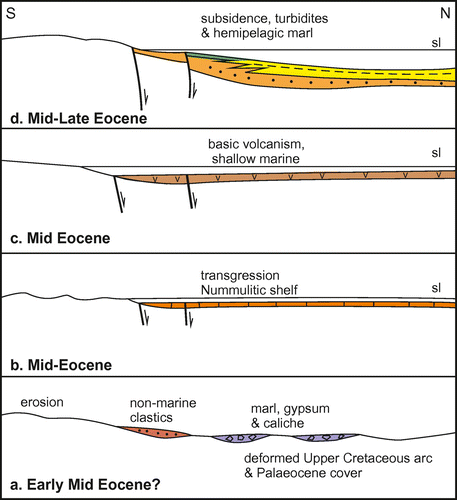
The Eocene marine successions terminate with a regional unconformity, followed by a major structural and depositional break. In different areas, the Eocene lithologies are overthrust, either southwards (e.g. NE of Erzincan; Figure ) or northwards (e.g. north margin of Kırdağ Ophiolite; Figure ) by oceanic units within the suture zone, which is attributed to post-collision suture zone tightening. Areas further south in the Taurides were also affected by Late Eocene compressional deformation (see Booth et al., Citation2013).
Non-marine deposition (poorly dated) took place widely during the Oligocene, reflecting regional uplift, presumably caused by suture zone tightening, during a time of lowered eustatic sea level (Haq, Hardenbol, & Vail, Citation1987; Miller et al., Citation2005). However, slab break-off during this time (latest Eocene–Oligocene, or Miocene) is another option, as suggested for the Lesser Caucasus and the Eastern Pontides during either the Oligocene–Miocene (Sosson et al., Citation2010) or the Miocene, respectively (Eyüboğlu et al., Citation2013).
The Eocene and Oligocene–Early Miocene depocentres occur independently of each other reflecting an intervening tectonic reorganisation. The basin configuration was also influenced by widespread post-collisional andesitic-dacitic volcanism and related magmatic intrusion (e.g. Keskin et al., Citation2006; Şengör et al., Citation2008).
Shallow shelf seas transgressed large areas of the suture zone and adjacent areas during the Early Miocene. Sequences typically deepen and fine upwards (e.g. NE of Erzincan), which is suggestive of regional extension. This could reflect subsidence of the Eastern Black Sea margin following a phase of suture zone tightening or slab break-off.
The Early Miocene shallow-marine deposition was followed by folding and re-thrusting that affected many parts of the suture zone and the Pontide foreland (e.g. S and NW of Erzincan). As a result, many units including the Jurassic ophiolites and accretionary melange were re-imbricated, generally southwards. Suture zone rocks including ophiolites were also re-thrust northwards especially in the east of the area (e.g. Karadağ Ophiolite). Further north, the structurally highest of the Pontide thrust sheets (Tortum thrust sheet) was thrust northwards over Mid-Eocene clastics and volcanics.
Left-lateral strike-slip-associated clastic sedimentation and volcanism ensued during Plio–Quaternary time related to the westward tectonic escape of Anatolia (e.g. Şengör et al., Citation2005). Suture zone units to the south of the North Anatolian Transform Fault (type area of the Refahiye ophiolite) need to be restored ~85 km eastwards.
12. Tectonic development
Several factors need to be considered when interpreting the setting of ophiolite genesis in the Eastern Pontides.
The ordered and dismembered ophiolites of the suture zone can be restored as a single Early Jurassic SSZ-type ophiolite. This may also have included the inferred marginal basin ophiolites of the Lesser Caucasus.
There is evidence of Early Jurassic subduction/accretion both from the melange in the Refahiye area (Topuz et al., 2012) and from the Pontide margin (Ustaömer & Robertson, Citation2010; Ustaömer et al., Citation2013).
The screens of metacarbonate rocks and schist observed in one area (SW Erzincan; see Rice et al., Citation2006, Citation2009; also Figure ) are an important (and unusual) indication that the Early Jurassic ophiolites formed adjacent to a crustal unit (e.g. a metamorphosed subduction complex or continental margin unit) that was detached and incorporated into the sheeted dyke complex when spreading began. An unrelated oceanic setting is unlikely, as this would not explain the metamorphism of the dyke host rocks. The field relations indicate that the dykes with screens represent an integral part of the sheeted dyke complex rather than being, for example, an incorporated slice of continental crust that, by chance, contained dykes. The host continental crust could have originated along the Eurasian continental margin or relate to a microcontinent within the Tethyan ocean.
After genesis of the ophiolites in the Early Jurassic (and related arc magmatism) above a subduction zone, the ocean remained partially open, probably until Late Palaeocene–Early Eocene time.
Collision was complete by the Late Middle Jurassic (Bathonian).
12.1. Alternative tectonic models
Three main scenarios for Early Jurassic ophiolite genesis and related subduction/accretion can be considered (Figure ).
Figure 39. Three alternative models for the Early Jurassic of SSZ oceanic crust. Option b (favoured) is developed in Figure . (a) Single subduction zone dipping beneath the Pontide continental margin. ai, The ophiolite forms by SSZ spreading, coupled with rifting (extension) of the Eurasian margin. The dyke swarms cutting metasediments (beneath the Refahiye ophiolite; see Figure ) are explained by initiation of spreading along the Eurasian margin; aii, A colliding crustal block (continental fragments or igneous seamount) is invoked to explain the well-documented closure of the backarc rift and deformation of the Eurasian continental margin during the Late Jurassic; (b) Two N-dipping subduction zones, one oceanic and one adjacent to the Pontide margin. Older oceanic crust (Palaeotethys) is subducted to create the Jurassic backarc rift and arc. bi, The Early Jurassic oceanic crust is generated by SSZ spreading in a more oceanic setting. A crustal block is again invoked to explain the origin of the dyke swarms (as in ai); bii, the inferred continental fragment collides with the Eurasian margin leading to closure of the backarc rift; (c) Single S-dipping subduction zone. ci, Intra-oceanic subduction possibly initiates along the margin of a crustal block. Slab-pull might help explain the Jurassic continental margin magmatism (but not its subduction-related chemical affinities). cii, Southward subduction culminates in collision and emplacement over the Eurasian margin during the Late Cretaceous. Some accretionary melange was indeed emplaced over the Eurasian margin during the Late Cretaceous but evidence for large-scale ophiolite obduction is absent. Each of the above models has some pros and cons as discussed in the text.
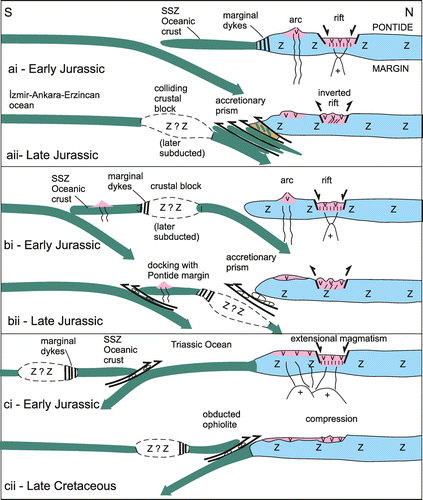
In the simplest option (Figure (ai–aii)), both the Early Jurassic ophiolites and the Mid-Late Jurassic Pontide continental margin arc/backarc basin (Irmakyanı Basin) are interpreted as single, unified active continental margin system. In this model, the collision of a crustal block (seamount or continental fragment) is called upon to collapse the backarc rift. The main problem with this interpretation is that SSZ ophiolite genesis requires oceanic slab rollback. However, such rollback does not allow for the development of a Mid-Jurassic continental margin arc (Olur arc; Ustaömer & Robertson, Citation2010) above the same subduction zone.
In the second option (Figure (bi–bii)), the Early Jurassic ophiolites formed above an intra-oceanic subduction zone, with a second, independent subduction zone dipping northwards beneath the Pontide margin. The Early Jurassic granitic intrusion into ophiolitic gabbro (Kırdağ area) is interpreted as incipient intra-oceanic arc magmatism, while the Mid-Jurassic volcanics of the Pontide margin represent a separate continental margin-type magmatic arc (Olur arc). This option implies the genesis of two subduction-accretion complexes of Jurassic age, one to the south and one to the north of the SSZ-ophiolitic slab. In this case, subduction could have nucleated at a microcontinent within the ocean to explain the metamorphic dyke screens (Figure (bi)). However, there is no evidence as to the distance of the SSZ-type spreading from Eurasia. The dated miscaschist from the Refahiye metamorphic melange provides evidence of Jurassic subduction/accretion (Topuz et al., 2012). The presence of oceanic lithologies (basalt; chert) but without thick terrigenous sediments (i.e. continental margin trench deposits) points to accretion in an oceanic setting. Any Jurassic subduction complex along the Pontide margin apparently was not preserved, possibly owing to subduction-erosion. In this model, the collision of a crustal block (seamount or continental fragment) is again invoked to collapse the backarc rift. The main problem is that there is no direct evidence that the Jurassic ophiolitic rocks were emplaced over the Eurasian margin until Early Cenozoic time.
In a third option (Figure (ci–cii)) is that the Early Jurassic ophiolites formed above a S-dipping subduction zone. A continental fragment might again be involved as above. Accretionary melange formed as older oceanic crust subducted, leading to docking of the SSZ ophiolite slab with the Pontide margin. Assuming such docking took place during the Mid-Late Jurassic (Figure (ci)), the implied collision of the oceanic slab could have collapsed the Pontide continental margin rift (Irmakyanı basin). However, there is no regional evidence of ophiolite obduction during the Mid-Late Jurassic (e.g. flexural downwarping; emplaced accretionary melange). Instead, the stratigraphy of the Eurasian continental margin persisted unbroken by emplacement-related event until Late Cretaceous or Palaeocene time. Southward subduction during the Late Cretaceous/Palaeocene could also have resulted in northward emplacement of the ophiolites and the observed northward-directed imbrication of the Eurasian margin (Figure (cii)). Previously, when the East Pontide ophiolites were assumed to be Cretaceous in age, Okay and Şahintürk (Citationl997a) postulated that the ophiolites were obducted northwards during the Cenomanian (~95–100 Ma) as a large crustal flake. Northward subduction then resumed until the ocean closed during Palaeocene–Eocene time. The main problem is that evidence from some parts of the Eastern Pontides (Erzincan area) and from the Central Pontides and the Lesser Caucasus (Figure (a–c)) indicates that the ophiolites were emplaced by regional-scale thrusting beneath the Eurasian margin during latest Cretaceous or Palaeocene time.
One additional possible, but seemingly unlikely, option is that the two belts (oceanic and continental margin) were not in their present relative positions but were brought together by strike-slip (terrane displacement) prior to Middle Eocene time, the age of the oldest common cover (see below).
When the tectono-stratigraphy of the wider region is considered, notably the Central Pontides and the Lesser Caucasus, the option shown in Figure (bi–bii) appears to be the most plausible, as developed in Figure (a–f). Northward intra-oceanic subduction began with a pre-existing ocean (Triassic Palaeotethys?). Subduction nucleated adjacent to a microcontinent, as suggested by the dyke metamorphic screen evidence (see above). Subduction probably began within the ocean (Early Jurassic; Figure (a)) but might alternatively have nucleated adjacent to the Eurasian margin. SSZ spreading created the Lower Jurassic ophiolites and the Mid–Upper Jurassic marginal basin-type ophiolites of the Lesser Caucasus (Figure (b)). The inferred continental block collided with the Eurasian margin collapsing the intra-continental backarc basin (Mid-Late Jurassic; Figure (b)). The SSZ oceanic crust remained to the south. A substantial width of oceanic crust (~1000 km) is implied to fuel the Late Cretaceous continental arc magmatism. To accommodate this subduction, additional spreading may have taken place above the intra-oceanic subduction zone during the Cretaceous. However, Cretaceous ophiolites have not been identified in the Eastern Pontides. The oceanic subduction zone collided with the Munzur (Tauride) margin during latest Cretaceous time, emplacing ophiolites and accretionary melange southwards; meanwhile, oceanic crust subducted beneath the Pontide margin giving rise to arc volcanism (Figure (c)). Accretionary material was backthrust over the Eurasian margin backstop during the Late Cretaceous (pre- or syn-Maastrichtian). Subduction continued until the remaining ocean finally closed initiating continental collision during Late Palaeocene–Early Eocene time (Figure (d)). The suture zone was re-imbricated, mostly southwards, but in places also northwards, during Late Eocene to pre-Pliocene time (Figure (e)).
13. Conclusions
The Ankara-Erzincan-Kars segment of the Tethyan suture zone in NE Turkey records northward subduction, at least during Early Jurassic to Late Cretaceous (Palaeocene?) time.
The various ophiolitic massifs within the suture zone, both relatively large bodies and locally underlying ophiolitic slice complexes, all formed during the Early Jurassic, based on U–Pb radiometric dating of zircons from plagiogranites and gabbroic rocks.
In one area (Kırdağ slice complex), a thrust sheet of ophiolitic gabbro is intruded by a tonalite that is also dated as Early Jurassic. This is interpreted as early-stage oceanic arc-type magmatism.
Chemical analysis of diabase and microgabbro from the ophiolitic slice complexes indicates IAT compositions, suggestive of a SSZ, forearc setting.
The volcanic-sedimentary melange that generally occurs beneath the ophiolitic rocks is interpreted as a subduction complex of mainly Cretaceous age (up to latest Cretaceous in age).
Stratified hemipelagic sediments and channellised debris-flow deposits of latest Cretaceous age within the melange are interpreted as deformed forearc basin (i.e. perched basin) deposits.
Subduction-influenced basalts in the melange are locally interbedded with Early Jurassic radiolarians, similar to the age of the overriding SSZ-type ophiolites. These volcanics and their deep-sea sedimentary cover were probably detached from an overriding Early Jurassic ophiolitic forearc complex and incorporated within the accretionary melange.
Within-plate (E-MORB/OIB) basaltic blocks within the melange are interpreted as accreted fragments of oceanic seamounts. At one location, these basalts are dated as Early Jurassic based on the age of interbedded radiolarites.
Metamelange in the east of the area that is affected by HP/LT metamorphism is interpreted as exhumed accretionary material (e.g. boninitic extrusives).
Accretionary melange was locally emplaced northwards onto the Eurasian platform (backstop) during latest Cretaceous time. However, deposition on the Eurasian margin persisted into the Early Eocene in some areas.
Palaeocene–Early Eocene clastic sediments, largely gravity flows, accumulated in a regional-scale continental margin foredeep and in thrust-top basins.
Continental collision took place progressively during Late Palaeocene–Early Eocene. Ophiolites and melanges were thrust beneath the Eurasian margin. As collision intensified, the ophiolites and melanges in some areas were thrust northwards associated with large-scale imbrication of the adjacent Eurasian margin.
Immediately following final collision (~45 Ma), the Pontide margin rifted and subsided associated with basaltic volcanism and the deposition of volcaniclastic gravity flows in a deepening marine basin. Oceanic slab rollback/delamination is a possible cause for the subsidence and calc-alkaline volcanism.
During the Late Middle Eocene (Bartonian), the suture zone and the deformed Eurasian continental margin were transgressed by non-marine clastic to shallow-marine sediments, derived from both the emplaced oceanic units and the Eurasian continental margin.
The suture zone was affected by several stages of suture zone tightening (Late Eocene; pre-Pliocene) resulting in large-scale, mainly southward, but also northward, re-imbrication of the suture zone and the adjacent Eurasian margin. The geometry of the post-collisional sedimentary basins changed several times, followed by the switch to left-lateral strike-slip and the westward tectonic escape of Anatolia during Plio–Quaternary time.
Acknowledgements
The research was financially supported by the DARIUS project. We thank Cahit Dönmez and Serkan Özkümüş of MTA (Ankara) for assistance during an early stage of the fieldwork. In addition, we thank Dr Richard Hinton for carrying out the ion probe dating in the microanalysis centre at the University of Edinburgh. Nicola Cayzer assisted with the backup SEM imaging. Ayşegül Yıldız kindly identified some calcareous nannofossils. We also thank Nusret Nurlu and Selena Ezgi Öztürk (Çukurova University) and also Yağız Demirtay and Aybike Kara (Istanbul University) for assistance with drafting of the diagrams. The manuscript benefited from reviews by Marc Sosson and Can Genç.
References
- Adamia, S. A., Chkhotua, T., Kekelia, M., Lordkipanidze, M., Shavishvili, I., & Zakariadze, G. (1981). Tectonics of the Caucasus and adjoining regions: Implications for the evolution of the Tethys ocean. Journal of Structural Geology, 3, 437–447.10.1016/0191-8141(81)90043-2
- Aktimur, H. T., Tekirli, M. E., & Yurdakul, M. E. (1990). Geology of the Sivas-Erzincan Tertiary basin. Bulletin of the Mineral Research and Exploration Institute of Turkey, 111, 21–30.
- Aktimur, H. T., Yurdakul, M. E., Sarıaslan, M., Göksel, M., Keçer, M., Yıldırım, T., & Akkuş, İ. (1995). Geology of Erzincan region and petrology of Quaternary volcanic rocks. In A. Erler (Ed.), Geology of the Black Sea region (pp. 82–90). Ankara: General Directorate of Mineral Research and Exploration and Chamber of Geological Engineers.
- Aktimur, T., Atalay, Z., Ateş, Ş., Tekirli, M. E., & Yurdakul, M. E. (1988). Munzur Dağları ile Çavuş Dağı Arasının Jeolojisi [Geology of the region between the Munzur and Çavuş Mountains] (Report 301). Ankara: Mineral Research and Exploration Institute of Turkey (MTA), p. 102.
- Altherr, R., Topuz, G., Siebel, W., Şen, C., Meyer, H. P., Satır, M., & Lahaye, Y. (2008). Geochemical and Sr–Nd–Pb isotopic characteristics of Paleocene plagioleucitites from the Eastern Pontides (NE Turkey). Lithos, 105, 149–161.10.1016/j.lithos.2008.03.001
- Barrier, E., & Vrielynck, B. (2008). Palaeotectonic map of the Middle East, Atlas of 14 maps, tectonosedimentary-palinspastic maps from Late Norian to Pliocene. Paris: Commission for the Geologic Map of the World (CCMW, CCGM).
- Baumgartner, P. O., O’Dogherty, L., Gorican, S., Dumitrica-Jud, R., Dumitrica, P., Pillevuit, A., … Steiger, T. (1995). Radiolarian catalogue and systematics of Middle Jurassic to Early Cretaceous Tethyan genera and species. In P. O. Baumgartner, L. O’Dogherty, S. Gorican, E. Urquhart, A. Pillevuit, & P. DeWever (Eds.), Middle Jurassic to Lower Cretaceous Radiolaria of Tethys: Occurrences, systematics, biochronology (Vol. 23, pp. 37–688). Lausanne: Memoires de Géologie.
- Bedi, Y., Yusufoğlu, H., Beyazpirinç, M., Özkan, M. K., Usta, D., & Yıldız, H. (2009). Doğu Toroslar’ın jeodinamik evrimi (Afşin-Elbistan-Göksun-Sarız Dolayı) [Geodynamic evolution of the Eastern Taurides (around Afşin-Elbistan-Göksun-Sarız)] (371 pp.) (Report). General Directorate of Mineral Research and Exploration (General).
- Bergougnan, H. (1975). Relations entre les edifices pontique et Taurique dans le Nord-East de l’Anatolie [Relationships between Pontide and Tauride structure in North-East Anatolia]. Bulletin de la Societé Géologique de France, 12, 1045–1057.
- Booth, M. G., Robertson, A. H. F., Taslı, K., İnan, N., Ünlügenç, U. C., & Vincent, S. (2013). Two-stage development of the Late Cretaceous to Late Eocene Darende basin: Implications for closure of Neotethys in central eastern Anatolia (Turkey). In A. H. F. Robertson, O. Parlak, & U.-C. Ünlügenç (Eds.), Geological development of Anatolia and the easternmost Mediterranean region (Vol. 372, pp. 385–419). London: Geological Society, Special Publications.
- Bozkuş, C. (1992a). Olur (Erzurum) yöresinin stratigrafisi [Stratigraphy of the Olur (Erzurum) region]. Türkiye Jeoloji Bülteni [Geological Bulletin of Turkey], 35, 103–119.
- Bozkuş, C. (1992b). Oltu-Narman (Erzurum) Tersiyer havzası kuzeydoğusunun (Kömürlü) stratigrafisi [Stratigraphy of the northeastern part of Oltu-Narman (Erzurum) Tertiary basin], Türkiye Jeoloji Bülteni [Geological Bulletin of Turkey], 33, 47–56.
- Bozkuş, C., & Yılmaz, Ö. (l993). Tercan (Erzincan) ve Aşkale (Erzurum) arasındaki bölgenin tektoniği [Tectonics of the region between Tercan (Erzincan) and Aşkale (Erzurum)]. Türkiye Jeoloji Bülteni [Geological Bulletin of Turkey], 36, 189–201.
- Bragin, N. Y., & Tekin, U. K. (l996). Age of radiolarian-chert blocks from the Senonian ophiolitic melange (Ankara, Turkey). The Island Arc, 5, 114–122.
- Çelik, Ö. F., Marzoli, A., Marschik, R., Chiaradia, M., Neubauer, N., & Öz, İ. (2011). Early–middle Jurassic intra-oceanic subduction in the İzmir–Ankara–Erzincan Ocean, northern Turkey. Tectonophysics, 509, 120–134.
- Çolakoğlu, A. O. (2010). Refahiye ofiyolitinin kökeni-KD Erzincan [Origin of Refahiye ophiolite-NE Erzincan] (MSc thesis). Çukurova Üniversitesi Fen Bilimleri Enstitüsü, Adana. 65 pp.
- Danelian, T., Asatryan, G., Sahakyan, L., Galoyan, G., Sosson, M., & Avagyan, A. (2010). New and revised radiolarian biochronology for the sedimentary cover of ophiolites in the Lesser Caucasus (Armenia). In M. Sosson, N. Kaymakci, R. Stephanson, F. Bergarat, & V. Storatchenoko (Eds.), Sedimentary basin tectonics from the Black Sea and Caucasus to the Arabian platform (Vol. 340, pp. 383–391). London: Geological Society, Special Publications.
- Danelian, T., Robertson, A. H. F., Collins, A. S., & Poisson, A. (2006). Biochronology of Jurassic and Early Cretaceous radiolarites from the Lycian Melange (SW Turkey) and implications for the evolution of the Northern Neotethys ocean. In A. H. F. Robertson & D. Mountrakis (Eds.), Tectonic development of the Eastern Mediterranean region (Vol. 260, pp. 229–236). London: Geological Society, Special Publications.
- Dilek, Y., & Thy, P. (2006). Age and petrogenesis of plagiogranite intrusions in the Ankara melange, central Turkey. The Island Arc, 15, 44–57.10.1111/iar.2006.15.issue-1
- Dokuz, A. (2011). A slab detachment and delamination model for the generation of Carboniferous high-potassium I-type magmatism in the eastern Pontides, NE Turkey: The Köse composite pluton. Gondwana Research, 19, 926–944.10.1016/j.gr.2010.09.006
- Dokuz, A., Karslı, O., Chen, B., & Uysal, İ. (2010). Sources and petrogenesis of Jurassic granitoids in the Yusufeli area, Northeastern Turkey: Implications for pre- and post-collisional lithospheric thinning of the eastern Pontides. Tectonophysics, 480, 259–279.10.1016/j.tecto.2009.10.009
- Dumitrica, P., Immenhauser, A., & Dumitrica-Jud, R. (1997). Mesozoic radiolarian biostratigraphy from Masirah Ophiolite, Sultanate of Oman. Part I: Middle Triassic, uppermost Jurassic and lower Cretaceous Spumellarians and multisegmented Nassellarians. Bulletin of the National Museum of Natural Science, 9, 1–106. Taichung, Taiwan.
- Erdoğan, T. (1972). Erzurum-Karayazı bölgesinin jeolojisi ve petrol imkanları [Geology of Erzurum–Karayazı region and its petroleum potential] (Report 4845). Ankara: General Directorate of Mineral Research and Exploration (MTA).
- Eyüboğlu, Y., Santosh, M., Yi, K., Bektaş, O., & Sanghoon, K. (2013). Discovery of Miocene adakitic dacite from the Eastern Pontides belt (NE Turkey) and a revised geodynamic model for the late Cenozoic evolution of the Eastern Mediterranean region. Lithos, 146, 218–232.
- Fenerci, M. (l994). Rudists from the Maden (Bayburt) area (NE Turkey). Turkish Journal of Earth Sciences, 3, 1–12.
- Floyd, P. A., Göncüoğlu, M. C., Winchester, J. A., & Yalınız, M. K. (2000). Geochemical character of and tectonic environment of Neotethyan ophiolitic fragments and metabasites in the Central Anatolian crystalline complex, Turkey. In E. Bozkurt, J. A. Winchester, & J. D. A. Piper (Eds.), Tectonics and magmatism in Turkey and the surrounding area (Vol. 173, pp. 183–202). London: Geological Society, Special Publications.
- Galoyan, G., Rolland, Y., Sosson, M., Corsini, M., & Melkonyan, R. (2007). Evidence for superposed MORB, oceanic plateau and volcanic arc series in the Lesser Caucasus (Stepanavan, Armenia). Comptes Rendus Geoscience, 339, 482–492.10.1016/j.crte.2007.06.002
- Galoyan, G. H., Rolland, Y., Sosson, M., Corsini, M., Billo, S., Verati, C., & Melkonyan, R. (2009). Geology, geochemistry and 40Ar/39Ar dating of Sevan ophiolites (Lesser Caucasus, Armenia): Evidence for Jurassic back-arc opening and hot spot event between the South Armenian Block and Eurasia. Journal of Asian Earth Sciences, 34, 135–153.10.1016/j.jseaes.2008.04.002
- Göncüoğlu, M., Turhan, N., Şentürk, K., Özcan, A., & Uysal, S. (2000). A geotraverse across NW Turkey: Tectonic units of the Central Sakarya region and their tectonic evolution. In E. Bozkurt, J. A. Winchester, & J. D. Piper (Eds.), Tectonics and magmatism in Turkey and the surrounding area, (Vol. 173, pp. 139–162). London: Geological Society, Special Publications.
- Goričan, S., Carter, E. S., Dumitrica, P., Whalen, P. A., Hori, R. S., De Wever, P., … Guex, J. (2006). Catalogue and systematic of Pliensbachian, Toarcian and Aalenian radiolarian genera and species (p. 446). Ljubljana: Založba ZRC.
- Göncüoğlu, M. C., Yalınız, M. K., & Tekin, U. K. (2006). Geochemistry, tectono-magmatic discrimination and radiolarian ages of basic extrusives from the İzmir–Ankara suture belt (NW Turkey): Time constraints for the Neotethyan evolution. Ofioliti, 31, 25–38.
- Goričan, Š., Carter, E. S., Guex, J., O’Dogherty, L., De Wever, P., Dumitrica, P., Matsuoka, P. A. (2013). Evolutionary patterns and palaeobiogeography of Pliensbachian and Toarcian (Early Jurassic) Radiolaria. Palaeogeography, Palaeoclimatology, Palaeoecology, 386, 620–636.10.1016/j.palaeo.2013.06.028
- Görür, N., Oktay, F. Y., Seymen, I., & Şengör, A. M. C. (1998). Triassic to Miocene Palaeographic Atlas of Turkey. İstanbul: Istanbul Technical University.
- Gradstein, F. M., Ogg, J. G., & Smith, A. G. (2004). A geological time scale. Cambridge: Cambridge University Press.
- Hakyemez, H. Y., & Konak, N. (1996). Tectonic evolution and stratigraphy of Eocene basins in the easternmost part of the Pontides. In A. S. Derman, F. Toksoy, & E. Yılmaz (Eds.), Proceedings of the 2nd International Symposium on the Petroleum Geology and Hydrocarbon Potential of the Black Sea Area (Vol. 4, pp. 19–25). Ankara: Turkish Association of Petroleum Geologists, Special Publications.
- Haq, B. U., Hardenbol, J., & Vail, P. R. (1987). Chronology of fluctuating sea levels since the Triassic. Science, 235, 1156–1167.10.1126/science.235.4793.1156
- Hässig, M., Rolland, Y., Sosson, M., Galoyan, G., Müller, C., Avagyan, A., & Sahakyan, L. (2013). New structural and petrological data on the Amasia ophiolites (NW Sevan–Akera suture zone, Lesser Caucasus): Insights for a large-scale obduction in Armenia and NE Turkey. Tectonophysics, 588, 135–153.10.1016/j.tecto.2012.12.003
- Hess, J. C., Aretz, J., Gurbanov, A. G., Emmermann, R., & Lippolt, H. J. (1995). Subduction-related Jurassic andesites in the northern Great Caucasus. Geologische Rundschau, 84, 319–333.10.1007/s005310050008
- Jud, R. (1994). Biochronology and systematics of Early Cretaceous Radiolaria of the Western Tethys (Vol. 19, 1–147). Lausanne: Mémoires de Géologie.
- Keskin, M., Genç, Ş. C., & Tüysüz, O. (2008). Petrology and geochemistry of post-collisional Middle Eocene volcanic units in North-Central Turkey: Evidence for magma generation by slab breakoff following the closure of the Northern Neotethys Ocean. Lithos, 104, 267–305.10.1016/j.lithos.2007.12.011
- Keskin, M., Pearce, J. A., Kempton, P. D., & Greenwood, P. (2006). Magma-crust interactions and magma plumbing in a post-collision setting: Geochemical evidence from the Erzurum-Kars Volcanic Plateau, Eastern Turkey. In Y. Dilek, & S. Pavlides (Eds.), Special Paper 409: Postcollisional Tectonics and Magmatism in the Mediterranean Region and Asia (Vol. 409, pp. 475–505). Denver, CO: Geological Society of America Special Paper.10.1130/0-8137-2409-0
- Koçyiğit, A., & Altıner, D. (2002). Tectonostratigraphic evolution of the North Anatolian paleorift (NAPR): Hettangian–Aptian passive continental margin of the northern Neo-Tethys, Turkey. Turkish Journal of Earth Sciences, 11, 169–191.
- Kolaylı, H. (1996). Kop Dağları (Erzincan-Erzurum-Bayburt) ultramafic ve mafik kayaçların jeolojik, petrolojik ve metalojik incelemesi [Geologic, petrologic and metallogenic investigations of the ultramafic and mafic rocks in the Kop Mountains (Erzincan, Erzurum, Bayburt)] (Unpublished PhD thesis) (282 pp). Karadeniz Teknik Üniversitesi, Black Sea Technical University.
- Konak, N., & Hakyemez, H. Y. (2008a). 1/100.000 Ölçekli Türkiye jeoloji haritaları serisi, Kars-G48 paftası [1/100.000 scale Turkish geology map series, Kars-G48 sheet ] (Vol. 104, 69 pp.). Ankara: General Directorate of Mineral Research and Exploration, Geology Department.
- Konak, N., & Hakyemez, H. Y. (2008b). 1/100.000 Ölçekli Türkiye jeoloji haritaları serisi, Tortum-H47 paftası [1/100.000 scale Turkish geology map series, Tortum-H47 sheet] (Vol. 95, 46 pp.). Ankara: General Directorate of Mineral Research and Exploration, Geology Department.
- Konak, N., Hakyemez, H. Y., Bilgiç, T., Bilgin, R., Hepşen, N., & Ercan, T. (2001). Kuzeydoğu Pontidlerin (Oltu-Olur-Şenkaya-Narman-Uzundere-Yusufeli) Jeolojisi [Geology of northeast Pontides (Oltu-Olur-Şenkaya-Narman-Uzundere-Yusufeli)] (Report 10489). Ankara: General Directorate of Mineral Research and Exploration (MTA).
- Konak, N., & Sümengen, M. (2009). 1/100.000 Ölçekli Türkiye jeoloji haritaları serisi, Kars-H48 paftası [1/100.000 scale Turkish geology map series, Kars-H48 sheet] (Vol. 106, 23 pp.). Ankara: General Directorate of Mineral Research and Exploration, Geology Department.
- Korkmaz, S., & Baki, Z. (1984). Demirözü (Bayburt) güneyinin stratigrafisi [Stratigrapy of the south of Demirözü (Bayburt) area]. Geological Bulletin of Turkey, 5, 107–115.
- Leggett, J. K., McKerrow, W. S., & Eales, M. H. (1979). The Southern Uplands of Scotland: A lower Palaeozoic accretionary prism. Journal of the Geological Society, 136, 755–770.10.1144/gsjgs.136.6.0755
- Miller, K. G., Kominz, M. A., Browning, J. V., Wright, J. D., Mountaın, G. S., Katz, M. E., & Pekar, S. F. (2005). The Phanerozoic record of global sea-level change. Science, 310, 1293–1298.10.1126/science.1116412
- MTA. (2002). 1:500,000 ölçekli Türkiye jeoloji haritası [Geological map of Turkey, 1:500,000]. MadenTektik ve Arama Genel Müdürlüğü [General Directorate of Mineral Research and Exploration]. Ankara.
- Nikishin, A. M., Korotaev, M. V., Ershov, A. V., & Brunet, M. F. (2003). The Black Sea basin: Tectonic history and Neogene–Quaternary rapid subsidence modelling. Sedimentary Geology, 156, 149–168.10.1016/S0037-0738(02)00286-5
- O’Dogherty, L. (1994). Biochronology and paleontology of mid-Cretaceous radiolarians from Northern Apennines (Italy) and Betic Cordillera (Spain). Mémoires de Géologie (Lausanne), 21, 1–413.
- Okay, A. I. (1984). The geology of the Ağvanis metamorphic rocks and neighbouring formations. Bulletin of the Mineral Research and Exploration Institute of Turkey, 99/100, 16–36.
- Okay, A. İ., & Leven, E. J. (1996). Stratigraphy and palaeontology of the Upper Palaeozoic sequences in the Pulur (Bayburt) region, Eastern Pontides. Turkish Journal of Earth Sciences, 5, 145–155.
- Okay, A. İ., & Şahintürk, Ö. (1997a). Geology of the Eastern Pontides. In A. G. Robınson (Ed.), Regional and petroleum geology of the Black Sea and surrounding region (Vol. 68, pp. 291–311). Houston, TX: American Association of Petroleum Geologists Memoir.
- Okay, A. İ., & Şahintürk, Ö. (1997b). Stratigraphy and tectonics of the Pulur (Bayburt) region in the Eastern Pontides. Bulletin of the Mineral Research and Exploration Institute of Turkey, 119, 1–24.
- Okay, A. I., Satır, M., & Siebel, W. (2006). Pre-Alpide Palaeozoic and Mesozoic orogenic events in the Eastern Mediterranean region. In D. G. Gee & R. A. Stepherson (Eds.), European lithosphere dynamics (Vol. 32, pp. 389–406). London: Geological Society, Memoirs.
- Okay, A. İ., & Tüysüz, O. (1999). Tethyan sutures of northern Turkey. In B. Durand, L. Jolivet, F. Horvath, & M. Seranne (Eds.), The Mediterranean basins: Tertiary extensions within the Alpine Orogen (Vol. 156, pp. 474–515). London: Geological Society, Special Publications.
- Okay, A. İ., Tüysüz, O., Satır, M., Özkan-Altıner, S., Altıner, D., Sherlock, S., & Eren, R. H. (2006). Cretaceous and Triassic subduction-accretion, high-pressure-low-temperature metamorphism, and continental growth in the Central Pontides, Turkey. Geological Society of America Bulletin, 118, 1247–1269.10.1130/B25938.1
- Önen, P., & Hall, R. (2000). Sub-ophiolite metamorphic rocks from NW Anatolia, Turkey. Journal of Metamorphic Geology, 18, 483–495.
- Özer, E., Koç, H., & Özsayar, T. (2004). Stratigraphical evidence for the depression of the northern margin of the Menderes–Tauride Block (Turkey) during the late Cretaceous. Journal of Asian Earth Sciences, 22, 401–412.
- Özgül, N. (1981). Munzur Dağlarının Jeolojisi [Geology of the Munzur Mountains] (Report 6995). Ankara: General Directorate of Mineral Research and Exploration (MTA).
- Özgül, N., & Turşucu, A. (1984). Stratigraphy of the Mesozoic carbonate sequence of the Munzur mountains (Eastern Taurides). In O. Tekeli & M. C. Göncüoğlu (Eds.), Geology of the Taurus belt (pp. 173–180). Ankara: Maden Tetkik ve Arama Enstitüsü Dergisi [Bulletin of the Mineral Research and Exploration Institute of Turkey].
- Özgülük, Y., Ustaömer, T., Ustaömer, P. A., & Gerdes, A. (2009). Petology and U/Pb geochronology of the Gökseki Metatrondjhemite (Ağvanis Metamorphics) E. Pontides: Early Lutetian magmatism and subsequent metamorphism and deformation. In Proceedings on the 62nd Geological Congress of Turkey, 13–17 April 2009 (pp. 500–501). Ankara: General Directorate of Mineral Research and Exploration.
- Parlak, O., Çolakoğlu, A., Dönmez, C., Sayak, H., Yıdırım, N., Türkel, A., & Odabaşı, I. (2013). Geochemistry and tectonic setting of ophiolites along the İzmir–Ankara–Erzincan Suture Zone in northeastern Anatolia. In A. H. F. Robertson, O. Parlak, & U.-C. Ünlügenç (Eds.), Geological development of Anatolia and the easternmost Mediterranean (Vol. 372, pp. 75–106). London: Geological Society, Special Publications.
- Parlak, O., Karaoğlan, F., Rızaoğlu, T., Klötzli, U., Koller, F., & Billor, Z. (2013). U–Pb and 40Ar–39Ar geochronology of the ophiolites and granitoids from the Tauride belt: Implications for the evolution of the inner Tauride suture. Journal of Geodynamics, 65, 22–37.10.1016/j.jog.2012.06.012
- Parlak, O., Yılmaz, H., & Boztuğ, D. (2006). Geochemistry and tectonic setting of the metamorphic sole rocks and isolated dykes from the Divriği ophiolite (Sivas, Turkey): Evidence for melt generation within an asthenospheric window prior to ophiolite emplacement. Turkish Journal of Earth Sciences, 15, 25–45.
- Pearce, J. A. (1996). A users guide to basalt discrimination diagrams. In D. A. Wyman (Ed.), Trace element geochemistry of volcanic rocks: Applications for massive sulphide exploration (Vol. 12, pp. 79–113). Geochemistry, Geological Association of Canada, Short Course Notes, St. John’s, Newfoundland.
- Pelin, S. (1981). Berdiga Dağları karbonat şelfinin mikrofasiyes analizi [Microfacies analysis of the carbonate shelf in the Berdiga Mountains]. Bulletin of Black Sea Technical University, Geology, 1, 15–20.
- Rice, S. P., Robertson, A. H. F., & Ustaömer, T. (2006). Late Cretaceous–early Ceneozoic tectonic evolution of the Eurasian active margin in the Central and Eastern Pontides, northern Turkey. In A. H. F. Robertson & D. Mountrakis (Eds.), Tectonic development of the Eastern Mediterranean region (Vol. 260, pp. 413–444). London: Geological Society, Special Publications.
- Rice, S. P., Robertson, A. H. F., Ustaömer, T., İnan, N., & Tasli, K. (2009). Late Cretaceous–Early Eocene tectonic development of the Tethyan suture zone in the Erzincan area, Eastern Pontides, Turkey. Geological Magazine, 146, 567–590.10.1017/S0016756809006360
- Robertson, A. H. F., & Dixon, J. E. (1984). Introduction: Aspects of the geological evolution of the Eastern Mediterranean. In J. E. Dixon & A. H. F. Robertson (Eds.), The geological evolution of the Eastern Mediterranean (Vol. 17, pp. 1–74). London: Geological Society, Special Publications.
- Robertson, A. H. F., Parlak, O., Metin, Y., Vergili, Ö., Taslı, K., İnan, N., & Soycan, H. (2013). Late Palaeozoic–Cenozoic tectonic development of carbonate platform, margin and oceanic units in the Eastern Taurides, Turkey. In A. H. F. Robertson, O. Parlak, & U.-C. Ünlügenç (Eds.), Geological development of Anatolia and the easternmost Mediterranean (Vol. 372, pp. 167–208). London: Geological Society, Special Publications.
- Robertson, A. H. F., Parlak, O., & Ustaömer, T. (2009). Melange genesis and ophiolite emplacement related to subduction of the northern margin of the Tauride–Anatolide continent, central and western. In D. J. J. Hinsbergen, M. A. Edwards, & G. Gowers (Eds.), Collision, collapse at the Africa–Arabia–Eurasia subduction zone (Vol. 311, pp. 9–66). London: Geological Society, Special Publications.
- Robertson, A. H. F., Parlak, O., & Ustaomer, T. (2012). Overview of the Palaeozoic–Neogene evolution of Neotethys in the Eastern Mediterranean region (southern Turkey, Cyprus, Syria). Petroleum Geoscience, 18, 381–404.10.1144/petgeo2011-091
- Robertson, A. H. F., Parlak, O., & Ustaömer, T. (2013). Late Palaeozoic–Early Cenozoic tectonic development of southern Turkey and the easternmost Mediterranean region: Evidence from the inter-relations of continental and oceanic units. In A. H. F. Robertson, O. Parlak, & U.-C. Ünlügenç (Eds.), Geological development of Anatolia and the easternmost Mediterranean (Vol. 372, pp. 9–48). London: Geological Society, Special Publications.
- Robertson, A. H. F., Parlak, O., Ustaömer, T., Taslı, K., İnan, N., & Dumitrica, P. (2013). Tectonic development and regional implications of the Ankara–Erzincan suture zone in the Eastern Pontides, Turkey during Late Mesozoic–Early Cenozoic time. In DARIUS Programme, Tbilisi Meeting, 24–25 June 2013 (pp. 53–57). Eastern Black Sea and Caucasus Workshop: Tiblisi, Georgia.
- Robertson, A. H. F., Ustaömer, T., Pickett, E. A., Collins, A. S., Andrew, T., & Dixon, J. E. (2005). Testing models of Late Palaeozoic–Early Mesozoic orogeny in Western Turkey: Support for an evolving open-Tethyan model. Journal of the Geological Society, London, 161, 501–511.
- Rojay, B. (2013). Tectonic evolution of the Cretaceous Ankara Ophiolitic Melange during the Late Cretaceous to pre-Miocene interval in Central Anatolia, Turkey. Journal of Geodynamics, 65, 66–81.10.1016/j.jog.2012.06.006
- Rojay, B., Altıner, D., Altıner, S., Önen, P., James, S., & Thirlwall, M. W. (2004). Geodynamic significance of the Cretaceous pillow basalts from North Anatolian Ophiolitic Melange Belt (Central Anatolia, Turkey): Geochemical and paleontological constraints. Geodinamica Acta, 17, 349–361.10.3166/ga.17.349-361
- Rojay, B., Yalınız, M. K., & Altıner, D. (2001). Tectonic implications of some Cretaceous pillow basalts from the northern Anatolian ophiolitic melange (Central Anatolia–Turkey) to the evolution of Neotethys. Turkish Journal of Earth Science, 10, 93–102.
- Rolland, Y., Billo, S., Corsini, M., Sosson, M., & Galoyan, G. (2009). Blueschists of the Amassia-Stepanavan Suture Zone (Armenia): Linking Tethys subduction history from E-Turkey to W-Iran. International Journal of Earth Sciences, 98, 533–550.10.1007/s00531-007-0286-8
- Rolland, Y., Galoyan, G., Bosch, D., Sosson, M., Corsini, M., Fornari, M., & Verati, C. (2009). Jurassic back-arc and Cretaceous hot-spot series in the Armenian ophiolites – Implications for the obduction process. Lithos, 112, 163–187.10.1016/j.lithos.2009.02.006
- Rolland, Y., Galoyan, G., Sosson, M., Melkonyan, R., & Avagyan, A. (2010). The Armenian ophiolite: Insights for Jurassic back-arc formation, Lower Cretaceous hot spot magmatism and Upper Cretaceous obduction over the South Armenian Block. In M. Sosson, K. Kaymakçı, R. A. Stephenson, F. Bergerat, & V. Starostenko (Eds.), Sedimentary basin tectonics from the Black Sea and Caucasus to the Arabian platform (Vol. 340, pp. 353–382). London: Geological Society, Special Publications.
- Sarıfakıoğlu, E., Özen, H., & Winchester, J. A. (2009). Petrogenesis of Refahiye ophiolite and its tectonic significance for Neotethyan ophiolites along the İzmir–Ankara–Erzincan Suture zone. Turkish Journal of Earth Sciences, 18, 187–207.
- Schildgen, T. F., Cosentino, D., Bookhagen, B., Niedermann, S., Yıldırım, C., Echtler, H., … Strecker, M. R. (2012). Multi-phased uplift of the southern margin of the Central Anatolian plateau, Turkey: A record of tectonic and upper mantle processes. Earth and Planetary Science Letters, 317–318, 85–95.10.1016/j.epsl.2011.12.003
- Şen, C. (2007). Jurassic volcanism in the Eastern Pontides: Is it rift-related or subduction related? Turkish Journal of Earth Sciences, 16, 523–539.
- Şengör, A. M. C. (1984). The Cimmeride orogenic system and the tectonics of Eurasia (Special Paper l95). Denver, CO: Geological Society of America.
- Şengör, A. M. C., Özeren, M. S., Keskin, M., Sakınç, M., Özbakır, A. D., & Kayan, İ. (2008). Eastern Turkish high plateau as a small Turkic-type orogen: Implications for post-collisional crust-forming processes in Turkic-type orogens. Earth-Science Reviews, 90, 1–48.10.1016/j.earscirev.2008.05.002
- Şengör, A. M. C., Tüysüz, O., İmren, C., Sakınç, M., Eyidoğan, H., Görür, N., … Rangin, C. (2005). The north Anatolian fault: A new look. Annual Review of Earth and Planetary Sciences, 33, 37–112.10.1146/annurev.earth.32.101802.120415
- Şengör, A. M. C., & Yılmaz, Y. (1981). Tethyan evolution of Turkey: A plate tectonic approach. Tectonophysics, 75, 181–241.
- Sosson, M., Rolland, Y., Danelian, T., Muller, C., Melkonyan, R., Adamia, S., … Galoyan, G. H. (2010). Subductions, obduction and collision in the Lesser Caucasus (Armenia, Azerbaijan, Georgia), new insights. In M. Sosson, N. Kaymakci, R. Stephanson, F. Bergarat, & V. Storatchenoko (Eds.), Sedimentary basin tectonics from the Black Sea and Caucasus to the Arabian Platform (Vol. 340, pp. 329–352). London: Geological Society, Special Publications.
- Sun, S. S., & Mcdonough, W. F. (1989). Chemical and isotopic systematics of ocean basalts: Implications for mantle composition and processes. In A. D. Saunders & M. J. Norry (Eds.), Magmatism in the ocean basins (Vol. 42, pp. 313–347). London: Geological Society, Special Publications.
- Tarhan, N. (1988). 1/100.000 Ölçekli Türkiye jeoloji haritaları serisi, Erzurum-F31 (~İ 45) paftası [1/100.000 scale Turkish geology map series, Erzurum-F31 (~İ 45) sheet] (Vol. 56, 13 pp.). Ankara: General Directorate of Mineral Research and Exploration, Geology Department.
- Tarhan, N. (2007a). 1/100.000 Ölçekli Türkiye jeoloji haritaları serisi, Erzincan-İ 44) paftası [1/100.000 scale Turkish geology map series, Erzincan-İ 44 sheet] (Vol. 67, 31 pp.). Ankara: General Directorate of Mineral Research and Exploration, Geology Department.
- Tarhan, N. (2007b). 1/100.000 Ölçekli Türkiye jeoloji haritaları serisi, Erzincan-İ 43 paftası [1/100.000 scale Turkish geology map series, Erzincan-İ43 sheet] (Vol. 68, 36 pp.). Ankara: General Directorate of Mineral Research and Exploration, Geology Department.
- Tarhan, N. (2008). 1/100.000 Ölçekli Türkiye jeoloji Haritaları serisi, Erzincan-İ 42 paftası [1/100.000 scale Turkish geology map series, Erzincan-İ 42 sheet] (Vol. 84, 27 pp.). Ankara: General Directorate of Mineral Research and Exploration, Geology Department.
- Tekin, U. K., Göncüoğlu, M. C., & Turhan, N. (2002). First evidence of Late Carnian radiolarians from the Izmir–Ankara suture complex, central Sakarya, Turkey: Implications for the opening age of the Izmir–Ankara branch of Neo-Tethys. Geobios, 35, 127–135.10.1016/S0016-6995(02)00015-3
- Topuz, G., Altherr, R., Satir, M., & Schwarz, W. H. (2004). Low-grade metamorphic rocks from the Pulur complex, NE Turkey: Implications for the pre-Liassic evolution of the Eastern Pontides. International Journal of Earth Sciences, 93, 72–91.10.1007/s00531-003-0372-5
- Topuz, G., Altherr, R., Siebel, W., Schwarz, W. H., Zack, T., Hasözbek, A., Satır, C. (2010). Carboniferous high-potassium I-type granitoid magmatism in the Eastern Pontides: The Gümüşhane pluton (NE Turkey). Lithos, 116, 92–110.10.1016/j.lithos.2010.01.003
- Topuz, G., Göçmengil, G., Rolland, Y., Çelik, O. F., Zack, T., & Schmitt, A. K. (2013). Jurassic accretionary complex and ophiolite from northeast Turkey: No evidence for the Cimmerian continental ribbon. Geology, 41, 255–258.10.1130/G33577.1
- Tulchoke, B. E., & Lin, J. (1994). A geological model for the structure of ridge segments in slow spreading ocean crust. Journal of Geophysical Research, 99, 11937–11958.
- Tunç, M. (1992). Olur (Erzurum) Yöresindeki Geç Jura–Alt Kretase yaşlı kireçtaşların biyostratigrafisi [The biostratigraphy of Upper Jurassic–Lower Cretaceous aged limestones of Olur (Erzurum)]. Geological Bulletin of Turkey, 35, 121–130.
- Tüysüz, O. (1990). Tectonic evolution of a part of the Tethyside orogenic collage: The Kargı Massif, northern Turkey. Tectonics, 9, 141–160.10.1029/TC009i001p00141
- Tüysüz, O., Dellaloǧlu, A. A., & Terzioǧlu, N. (1995). A magmatic belt within the Neo-Tethyan suture zone and its role in the tectonic evolution of northern Turkey. Tectonophysics, 243, 173–191.10.1016/0040-1951(94)00197-H
- Tüysüz, O., Yiğitbaş, E., & Serdar, H. S. (1988). Vezirköprü–Boyabat dolayının jeolojisi [Geology of the Vezirköprü–Boyabat area] (Report 55). Ankara: Turkish Petroleum Company (TPAO).
- Underwood, M. B., Ballance, P. F., Clift, P. D., Hiscott, R. N., Marsaglia, K. M., Pickering, K. T., & Reid, R. P. (1995). Sedimentation in forearc basins, trenches and collision zones, of the western Pacific: A summary of results from the Ocean Drilling Program. In B. Taylor & J. Natland (Eds.), Active margins and marginal basins of the Western Pacific (Vol. 88, pp. 315–354). Washington, DC: American Geophysical Union, Geophysical Monograph.
- Ustaömer, P. A., Ustaömer, T., & Robertson, A. H. F. (2012). Ion probe U–Pb dating of the Central Sakarya basement: A peri-Gondwana terrane intruded by late Lower Carboniferous subduction/collision-related granitic rocks. Turkish Journal of Earth Sciences, 21, 905–932.
- Ustaömer, T., & Robertson, A. H. F. (1997). Tectonic-sedimentary evolution of the north Tethyan margin in the Central Pontides of northern Turkey. In A. G. Robinson (Ed.), Regional and Petroluem geology of the Black Sea and surrounding region (Vol. 68, pp. 255–290). Houston, TX: American Association of Petroleum Geologists, Memoirs.
- Ustaömer, T., & Robertson, A. H. F. (2010). Late Paleozoic–Early Cenozoic tectonic development of the eastern Pontides (Artvin area), Turkey: Stages of closure of Tethys along the southern margin of Eurasia. In M. Sosson, N. Kaymakçı, R. A. Stephenson, F. Bergerat, & V. Starostenko (Eds.), Sedimentary basin tectonics from the Black Sea and Caucasus to the Arabian platform (Vol. 340, pp. 281–327). London: Geological Society, Special Publications.
- Ustaömer, T., Robertson, A. H. F., Ustaömer, P. A., Gerdes, A., & Peytcheva, I. (2013). Constraints on Variscan and Cimmerian magmatism and metamorphism in the Pontides (Yusufeli–Artvin area), NE Turkey from U–Pb dating and granite geochemistry. In A. H. F. Robertson, O. Parlak, & U.-C. Ünlügenç (Eds.), Geological development of Anatolia and the easternmost Mediterranean (Vol. 372, pp. 49–74). London: Geological Society, Special Publications.
- Vincent, S. J., Carter, A., Lavrishchev, V. A., Rice, S. P., Barabadze, T. G., & Hovius, N. (2011). The exhumation of the western greater Caucasus: A thermochronometric study. Geological Magazine, 148, 1–21.10.1017/S0016756810000257
- Yılmaz, A., Adamia, S., Chabukıanı, A., Chkhotua, T., Erdoğan, K., Tuzcu, S., & Karabıyıkoğlu, M. F. (2000). Structural correlation of the southern Transcaucasus (Georgia)–eastern Pontides (Turkey). In E. Bozkurt, J. A. Winchester, & J. D. A. Piper (Eds.), Tectonics and magmatism in Turkey and the Surrounding Area (Vol. 182, pp. 171–182). London: Geological Society, Special Publications.
- Yılmaz, A., Terlemez, İ., & Uysal, Ş. (1986). Erzurum güneydoğusunda yer alan Hınıs, Tekman ve Karayazı arasının jeolojisi [Geology of the area between Hınıs, Tekman and Karayazı at southeast of Erzurum] (Report 8089). Ankara: General Directorate of Mineral Research and Exploration (MTA).
- Yılmaz, A., Terlemez, İ., & Uysal, Ş. (1988a). Hınıs (Erzurum güneydoğusu) dolayının bazı stratigrafik ve tektonik özellikleri [Some stratigraphic and tectonic characteristics of the area around Hınıs (southeast of Erzurum]. Bulletin of the Mineral Research and Exploration, 108, 1–22.
- Yılmaz, A., Terlemez, İ., & Uysal, Ş. (1988b). Sakaltutan Dağı civarındaki ofiyolitik birimlerin jeolojik özellikleri ve yapısal evrimi [Geological characteristics and structural evolution of the ophiolitic units around Sakaltutan Dağı (Erzurum)]. METU Journal of Pure and Applied Sciences, 21, 221–235.
- Yılmaz, A., Terlemez, I., & Uysal, Ş. (1988c). 1/100.000 Ölçekli Türkiye jeoloji haritaları serisi, Erzurum-F33 (~I 47) paftası [1/100.000 scale Turkish geology map series, Erzurum-F33] (25 pp.). Ankara: General Directorate of Mineral Research and Exploration, Geology Department.
- Yılmaz, A., Terlemez, İ., & Uysal, Ş. (1989). Erzurum güneydoğusu Sakaltutan Dağı yöresinin jeolojisi [Geology of Sakaltutan region to the southeast of Erzurum] (Report 8903). Ankara: General Directorate of Mineral Research and Explorationara.
- Yılmaz, A., & Uysal, Ş. (1988). 1/100.000 Ölçekli Türkiye jeoloji haritaları serisi, Erzurum-F33 paftası [1/100.000 scale Turkish geology map series, Erzurum-F34] (20 pp.). Ankara: General Directorate of Mineral Research and Exploration, Geology Department.
- Yılmaz, H. (1995). Olur (Erzurum) Yöresinin Jeolojisi [The geology of the Olur (Erzurum) region]. Karadeniz Teknik Üniversitesi Dergisi, Jeoloji [Black Sea Technical University Bulletin, Geology], 4, 23–41.
- Yılmaz, C., & Kandemir, R. (2006). Sedimentary records of the extensional tectonic regime with temporal cessation: Gümüşhane Mesozoic Basin (NE Turkey). Geologica Carpathica, 57, 3–13.
- Yılmaz, Y., Tüysüz, O., Yiğitbaş, E., Genç, S. C., & Şengör, A. M. C. (1997). Geology and tectonic evolution of the Pontides. In A. G. Robinson (Ed.), Regional and petroleum geology of the Black Sea and surrounding regions (Vol. 68, pp. 183–226). Tulsa, OK: American Association of Petroleum Geologists, Memoirs.
- Zakariadze, G. S., Knipper, A. L., Bibikova, E. V., Silantiev, S. A., Zlobin, S. K., Gracheva, T. V., … Kolesov, T. M. (1990). The setting and age of the plutonic part of the NE sevan ophiolite complex. Izvestia NAS USSR, Geological Series, 3, 17–30. (in Russian).
